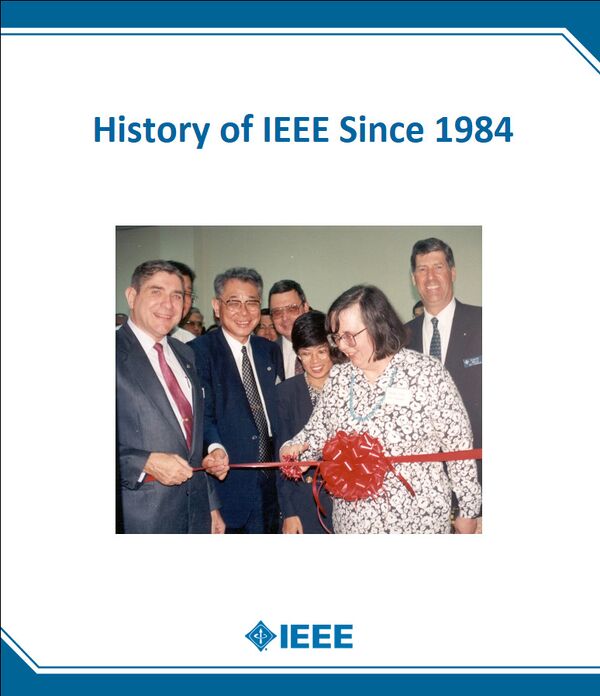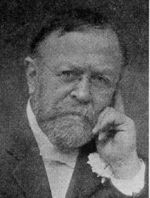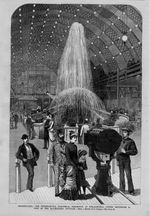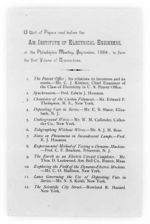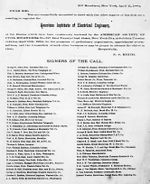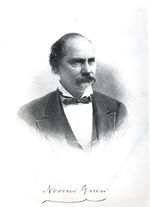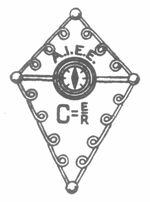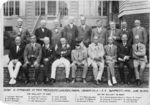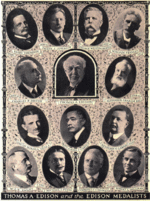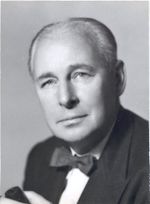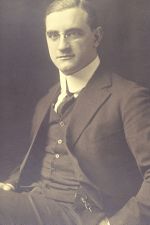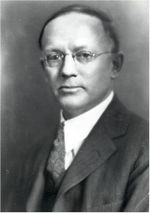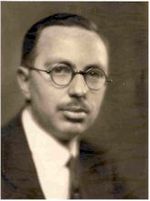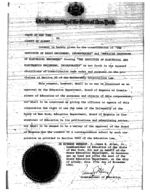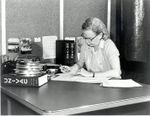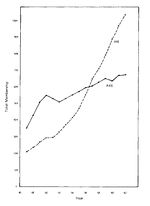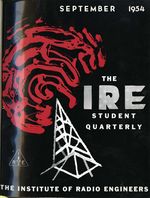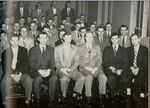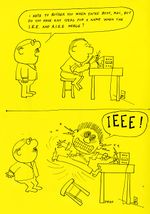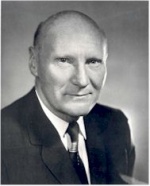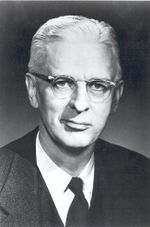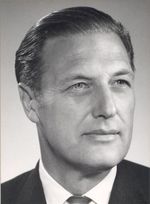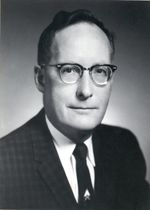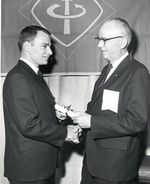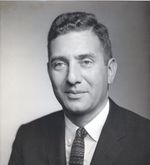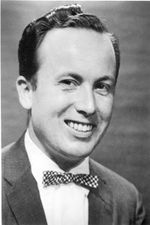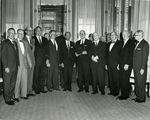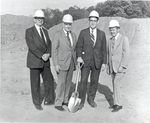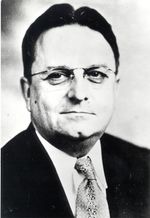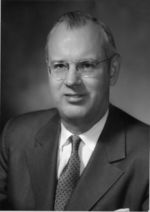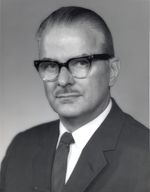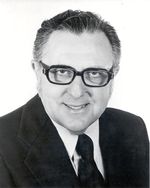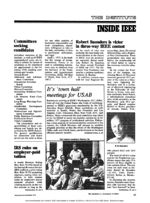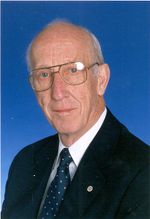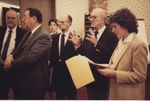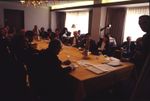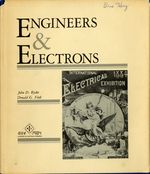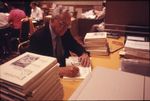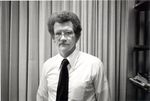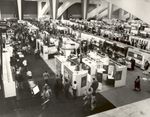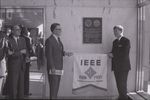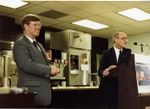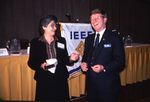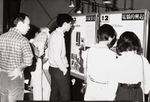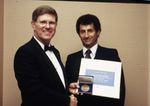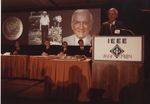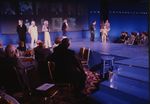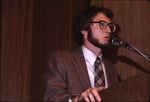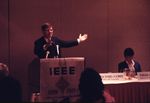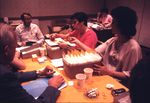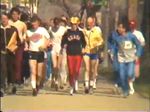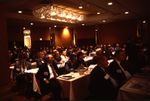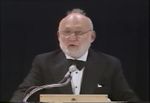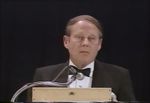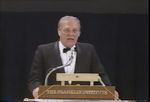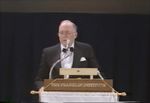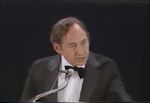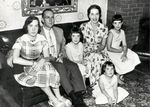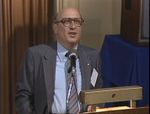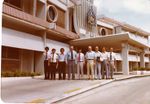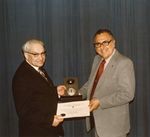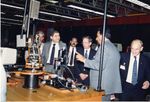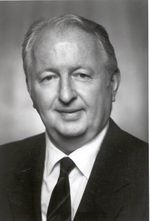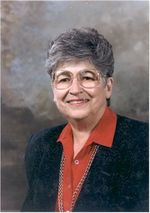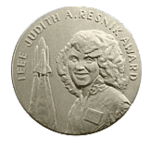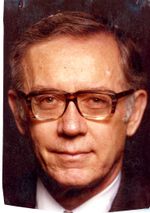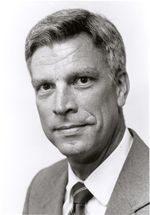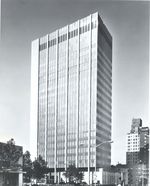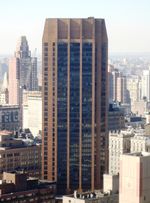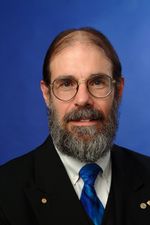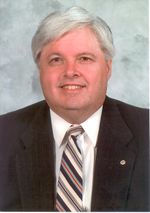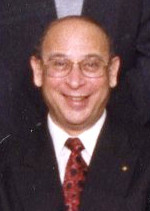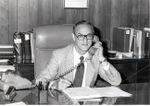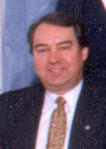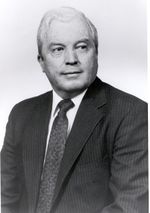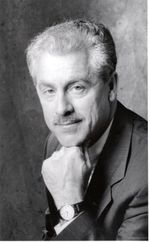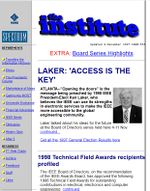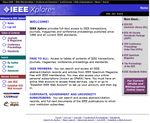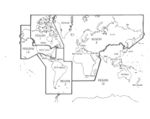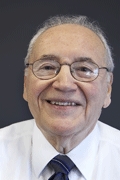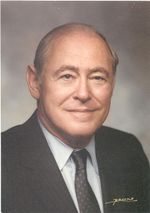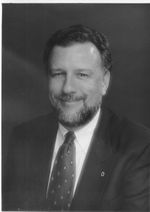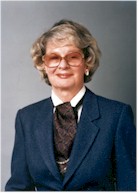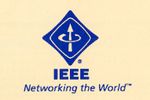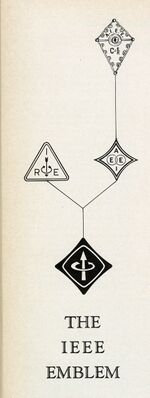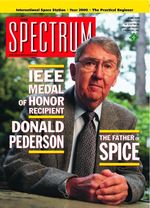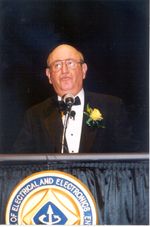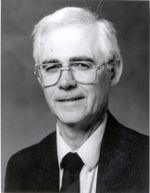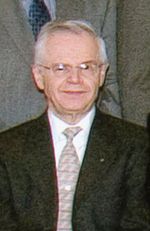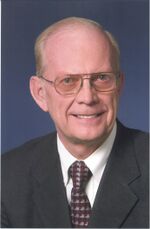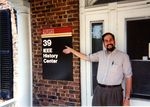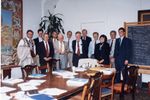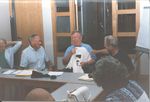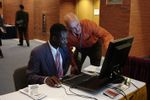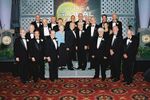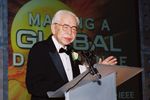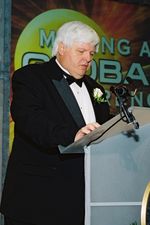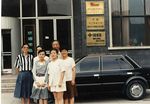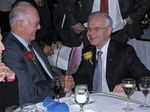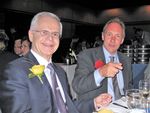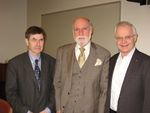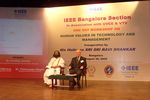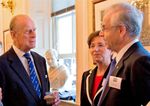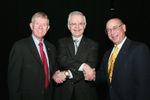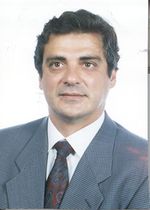History of IEEE Since 1984
For the IEEE centennial in 1984, two printed volumes were prepared on the first 100 years of IEEE history. The first, by professional historian A. Michal McMahon, was a scholarly approach. The second, by long-time IEEE volunteers John D. Ryder and Donald G. Fink, was more casual in tone. Besides these two texts being available on this site in PDF form, when this site was developed, much of the material about specific aspects of IEEE history was drawn from these earlier works. It is also important to note that although the books were published for the centennial in 1984, they were effectively completed in 1980, and their narratives thin out in the late 1970s.
Beginning in 2009, the 125th anniversary of IEEE, then IEEE President John R. Vig advocated that it was time for a new book covering the subsequent 25 years, and he raised funds from IEEE organizational units to make it possible: the IEEE Council on Superconductivity, the IEEE Aerospace and Electronic Systems Society, the IEEE Sensors Council, the IEEE Power & Energy Society, the IEEE Industrial Electronics Society, the IEEE Dielectrics and Electrical Insulation Society, the IEEE Vehicular Technology Society, the IEEE Ultrasonics, Ferroelectrics, and Frequency Control Society, the IEEE Robotics and Automation Society, the IEEE Nuclear and Plasma Sciences Society, the IEEE Circuits and Systems Society, the IEEE Communications Society, the IEEE Systems, Man, and Cybernetics Society, and the IEEE Signal Processing Society. As the project progressed, however, it became clear that what was need in the 21st century was an online publication that could be a living document. A wiki platform such as the Engineering and Technology History Wiki (ETHW), is the ideal medium for such an effort. Therefore, it was decided to produce this document, first posted in 2020. The histories of IEEE's predecessor organizations, AIEE and IRE, are included elsewhere on the site, as is the history of IEEE from the AIEE/IRE merger in 1963 through 1984. However, it was decided to summarize that other material here, so that there would be a continuous narrative of IEEE and how it came to be one of the world's largest, most impactful, and most prestigious professional technical societies.
Chapter 1 briefly summarizes the history of AIEE and IRE until the merger. Chapter 2 briefly summarizes the history of IEEE from the merger until 1980. Chapter 3 extensively covers the 1980s, with the focus on the lead up to the 1984 centennial, the centennial itself, and the aftermath. Chapter 4 extensively covers the 1990s. Chapter 5 extensively covers the 2000s. Chapter 6 initially covers 2010 - 2015, since one needs some time to pass to effectively evaluate history. It is understood that periodically this section will be extended as time marches forward. And of course, being a wiki-based site, all sections can be adapted, expanded, crossed-linked, and so forth in a continuous manner.
Since this is meant to be a living document, comments and suggestions are welcome. Please create an account and edit the page, or use the "Discussion" feature. IEEE History center staff will respond to your comments and incorporate them when appropriate. Also, if you have history to contribute directly, you may also use the First Hand Histories feature and start documenting that history.
Chapter 1: The Early Years of IEEE: a Community of Like-minded People
President E. J. Houston, “Our Time Had Come”
In 1894, American Institute of Electrical Engineers President Edwin J. Houston, delivered his inaugural address, recalling the founding of the AIEE, as it was known: “In 1884, the time had come when the advantages of congregation as opposed to segregation were to be demonstrated; when the lonely investigator was to be brought into contact with his brother toiler and taught the advantages of organized work and a free exchange of ideas. [It would be] a gathering of practical electricians.” Indeed, in 1884 they founded a new organization and in the process established a professional identity and a community of “like-minded” people.
Ten years earlier, an invitation to the AIEE’s organizational meeting appeared in Electrical World, informing all interested parties,
We give below the ‘call’ that has been issued for the purpose of establishing a national electrical society to which it is suggested to give the name of the ‘American Institute of Electrical Engineers.’ We print also the names of the electricians and capitalists and others prominently connected with electrical enterprises, who have already given their hearty adhesion to the project. The rapidly growing art of producing and utilizing electricity has no assistance from any American national scientific society. There is no legitimate excuse for this implied absence of scientific interest, except it be the short-sighted plea that everyone is too busy to give time to scientific, practical and social intercourse, which in other professions, have been found so conducive to advancement.
Americans who had attended First International Exposition of Electricity in Paris in 1881 (see Appendix 1) felt that the time had come to host a similar event. However, practically minded Americans chose to host a more commercially oriented affair, the International Electrical Exhibition, in Philadelphia, Pennsylvania in 1884. The United States, and Philadelphia in particular, were ideal venues for following up the French event. Under the impetus of Thomas Edison, Alexander Graham Bell, and many others, the American electrical industry was growing rapidly in the 1880s, and had become a center for innovation. Telegraphy was an established field, telephony was expanding, and the beginnings of electric power could be seen with the establishment of Edison’s Pearl Street Station in 1882.
It was the possibility of the visiting electrical experts not having a host society with which to interact that caught the attention of Nathaniel S. Keith, an electrical inventor. In April 1884, Keith issued a circular to interested parties, which began, "The rapidly growing art of producing and utilizing electricity has no assistance from any American national scientific society." What he really meant was an appropriate national engineering society. Beginning with the American Society of Civil Engineers in 1852, several other engineering groups had formed, but not yet one for the nascent field of electrical engineering (See Table 1-1: Select Engineering Societies in the United States, 1852 to 1912.)
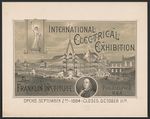
Founding the American Institute of Electrical Engineers
A small group of men, including Edison and Bell then met in New York City with a dual purpose, to found a society to advance the new field of electrical engineering, and to have this organization represent the United States at the International Electrical Exhibition that was opening in Philadelphia, Pennsylvania, that fall. They decided on the name American Institute of Electrical Engineers (AIEE). Norvin Green, president of the Western Union Telegraph Company, was elected first president of AIEE. Green was a medical graduate who had served in the Kentucky legislature and had entered the telegraph business in 1863. He became President of Western Union, the country's largest telegraph company, in 1878, and remained in that position until his death in 1893. During this period, he also headed the Edison Electric Light Company for several years. The six original vice presidents of the AIEE were Edison and Bell, along with Charles Cross, George A. Hamilton, Charles H. Haskins, and Frank L. Pope.
| Date | Founding Name | Name Change |
|---|---|---|
| 1852 |
| |
| 1871 |
|
American Institute of Mining, Metallurgical, and Petroleum Engineers (corporate headquarters, Littleton, Colorado) |
| 1880 |
|
|
| 1884 |
|
|
| 1904 |
|
United Engineering Foundation, Inc. (UEF)
|
| 1908 | American Institute of Chemical Engineers (AIChE) | |
| 1912 | Institute of Radio Engineers |
|
The International Electrical Exhibition, held in Philadelphia from 2 September to 11 October 1884, was a success in that it highlighted advances in telegraphy and telephony and served notice that electric light and power were going to have an impact on every aspect of social and industrial activity. The Exhibition was housed in a hall of wood and glass, which had been constructed at some financial risk by the sponsor, the Franklin Institute. However, although billed as an International Exhibition, to the disappointment of Keith and others, the show had only a few foreign exhibits. Because the American market was protected by tariffs, foreign manufacturers saw little reason to show up. Edison's exhibit was the largest and broadest in scope, and demonstrated his flair for showmanship. It included not only spectacular lighting displays, but also a complete central station system, using a 100 kW "Jumbo" generator with the characteristically long, thin, parallel cores for the field structure. The Edison exhibit also presented the curious three-lead lamp, showing the Edison-effect current through a vacuum.
The U.S. Congress had appointed a commission to conduct a National Conference of Electricians during the Exhibition. In planning for this conference, emphasis had been on the scientific gains to be expected, and most of the members of the appointed commission were teachers and scientists, while the exhibitors were inventors and entrepreneurs. Amid considerable friction between scientists and the more practical men, the conference did provide for mutual discussion on electrical topics. It became clear that electrical technology needed science to continue its advance, but at the same time, science would not be enough. After the model of the civil engineers, the electricians needed to evolve into electrical engineers (hence the name chosen for the AIEE), and not merely remain as applied physicists working on electrical phenomena.
Professor Henry Rowland, a physicist teaching at Johns Hopkins University, insisted that pure science must take the lead. "Let physical laboratories arise—let technical schools be founded—it is not telegraph operators but electrical engineers that the future demands." E. J. Houston, a practitioner of pure as well as applied science, tried to soothe the feelings of the electricians during his concluding remarks: "Theory comes as a result of experiment, and all that precedes is hypothesis."
During the exhibition,the AIEE held its first technical meeting at the Franklin Institute on 7-8 October. At this two-day session, there were ten papers presented, each stimulating vigorous discussion. The most significant paper, in retrospect, was "Notes on Phenomena in Incandescent Lamps," by Houston. In it, he described experiments undertaken with Edison's three-wire lamp, which elicited a conversation about the direction of current flow through a vacuum—a glimpse into the limited understanding of electricity in the years before the electron had been thought of. The papers included "The Scientific City Street,” on the role of electrical installations under city streets, by R.R. Hazard, president of the Gramme Company, a generator manufacturer.
The leaders of the new AIEE began with a vision that is not much different from what IEEE stands for today. The new organization would hold technical meetings, publish papers and transactions from the meetings, and interact with other technical societies. In a nod to the growing importance of standards, AIEE would settle intra-professional disputes over technical matters. AIEE would make its primary mission the dissemination of information on the latest electro-technical advances.
A council of leaders met monthly to manage AIEE, such as conveying information from members and organizing ad hoc committees. Within a few months, the institute began publishing its Transactions. In addition, an annual meeting, held each spring, continued the spirit of the Philadelphia meeting. The sands of the burgeoning electrical industry were shifting under the foundation of the AIEE, however, which had the effect of complicating the definition of who could join the organization. A two-tiered system of associates and full members, designed to distinguish between electricians and electrical workers, on the one hand, and engineers on the other, was a constant source of strife. The matter would take decades to resolve.
As early as 1890, some members thought an AIEE badge was needed for identity. In 1892, a committee produced a design that included the kite of Benjamin Franklin, a Wheatstone bridge around the border, a galvanometer representing magnetism and induction, and a blued-steel compass needle with a small, superimposed amber disk. The letters AIEE were to be above the galvanometer and Ohm's Law placed below. The resultant badge had a short life; in 1897, it was replaced with the badge that survived to 1963. This had a modified kite form, the letters AIEE, and two linked circles as evidence chat "electricity surrounds magnetism and magnetism surrounds electricity."
In the 1890s, a new generation of electrical practitioners began to appear on the AIEE technical programs in New York. The pages of the Transactions of the AIEE, which published the technical papers from the programs, frequently bear the names of Arthur E. Kennelly, Charles Steinmetz, and Michael I. Pupin, the latter two being graduates of European universities in mathematics and physics. The electrical engineers of the 1890s were finding their professional organization, the AIEE, an efficient means of transmitting and discussing the technical knowledge being introduced by these and other members. This spread of knowledge was an important part of industry's transition from rule-of-thumb at the bench to scientific accuracy at the machine. Much of the material presented at the meetings in New York must have been at a mathematical level well above the abilities of the average member, but attendees learned from the masters.
The members further learned that technical progress and commercial success required standardization. The scientists and early experimenters corresponded across national boundaries, and recognized that science needed a universal language. It was realized that for commercial use a kilowatt must be a kilowatt everywhere, and that a motor must perform the same on both sides of national boundaries. An International Electrical Congress, representing major governments that could enact the accepted standards into local law, undertook the defining and naming of units.
An 1890 paper by Kennelly introduced the first proposal for the Institute to adopt a formal name—that of "henry" for the unit of inductance. This continued the practice begun in science of naming units for its famous founders. In 1891, the Institute appointed a Committee on Units and Standards, with Kennelly as chair, to pursue standardization. In recognition of the growing influence of Americans in the electrical fields, it had been decided that the second International Electrical Congress would be held in Chicago in 1893 in conjunction with the World's Columbian Exposition. This was certainly a strong impetus for these efforts by the AIEE.
The year 1893 also saw the first activity of the Standards Committee in the presentation of a table of copper wire characteristics. An 1898 committee, chaired by Francis Crocker, described its own activities for machinery standardization by stating, "It aimed to define and state in as simple language as practicable, the characteristics, behavior, rating, and methods of testing of electrical machinery and apparatus, particularly with a view to setting up acceptance test standards for the electrical industry." This has remained the policy for IEEE standards.
From Practice to Profession
At the beginning of the 20th century, key developments were taking place in the filed of electrical engineering. The work of Guglielmo Marconi and others was building a new industry, wireless telegraphy, or radio. The invention of Fleming Valve held out the promise of wireless telephony, and was eventually to lead to the the new subfield of electronics. The AIEE was also undergoing many changes at this time. During his term in office, 1902-1903, AIEE President Charles F. Scott made a practice of asking for advice from members about proposed AIEE activities. To facilitate this, monthly meetings had started in Chicago, held on the same date and using the same discussion topic as the New York meetings. Members elsewhere were interested in extending this technical service to other geographical areas. A Committee on Local Organization was established, and sections were authorized in cities where there were sufficient interested members. In 1903, Chicago was joined by another eighteen branches or local groups (later official designations included sections and branches) noted in Table 1-2, but local sections were not authorized to hold their own programs until 1910.
| Location | Institution |
|---|---|
| Allegheny, PA | Western University of Pennsylvania |
| Ames, IA | Iowa State College |
| Bethlehem, PA | Lehigh University |
| Boston, MA | MIT and local members |
| Cincinnati, OH | |
| Columbia, MO | University of Missouri |
| Columbus, OH | Ohio State University |
| Denver, CO | |
| Ithaca, NY | Cornell University |
| Lafayette, IN | Purdue University |
| Madison, WI | University of Wisconsin |
| Philadelphia, PA | |
| Pittsburg, PA | |
| Schenectady, NY | Union University and local members |
| St. Louis, MO | |
| State College, PA | Pennsylvania State College |
| Urbana, IL | University of Illinois |
| Washington, D.C. | Columbian University and local member |
| Branch Location | Membership - 1 Nov. 1902 | Membership and Applications on File, 1903 | Increase |
|---|---|---|---|
| Chicago, IL | 85 | 139 | 54 |
| Pittsburgh, PA | 63 | 115 | 52 |
| Philadelphia, PA | 65 | 84 | 19 |
| Boston, MA | 75 | 164 | 89 |
| Denver, CO | 6 | 30 | 24 |
| Cincinnati, OH | 19 | 44 | 25 |
| Schenectady, NY | 54 | 105 | 51 |
| Columbus, OH | 6 | 15 | 9 |
| St. Louis, MO | 18 | 41 | 23 |
| Total | 391 | 737 | 346 |
As electrical engineering became more specialized, members needed to follow the progress of different technical areas, which led to the formation of technical committees. This process began in 1905 with the establishment of the Telegraph and Telephone Committee and the High Tension Transmission Committee. The purpose of these committees was to help members stay in touch with the latest in engineering practice in new fields. They were to provide information, via papers and reports, to members and to a Standardization Committee, so that it was apprised of the most recent relevant information about the evolving technologies. By 1915, there were thirteen technical committees; nearly forty years later, on the eve of the formation of Institute of Electrical and Electronics Engineers, the number had reached fifty-one.
The AIEE Matures
Given the educational developments described above, it is no surprise that by 1902, members expressed interest in organizing, as part of AIEE, electrical engineering students on college campuses. In 1903, the Institute recognized thirteen student organizations. The fact that these changes were suggested by the membership at large, aided by a dynamic president, seems to indicate that the AIEE board had been concerned only with activities in New York. Perhaps not totally coincidentally, a separate electrical engineering honor society, Eta Kappa Nu, was established at the University of Illinois at Urbana-Champaign. The AIEE members based in academia were often involved.
Also in 1902, at the annual dinner of the Institute, President Scott broached the subject of the need for a single building to house the engineering societies to bring about greater professional unity in engineering. Andrew Carnegie, the industrialist, was the keynote speaker. The next day Carnegie met with Scott and others and expressed a wish to see their plans for the building, which did not exist. They came back the next week with some ideas. Carnegie offered to donate $1,000,000, "more or less." In 1904, the "more" became an additional $500,000 to complete the building. A site was chosen at 33 West 39th Street in New York City, and plans were made to accommodate the ASCE, AIME, ASME, and the AIEE in a thirteen-story building. These "Founder Societies" were the first in the engineering field in the United States. The United Engineering Trustees were organized to build and operate the building, known as the United Engineering Center.
Before 1912, AIEE had two membership grades, Associate and Member. An individual entered as an associate and later applied for advancement to member after meeting the requirements of "ability to design and direct engineering work, and with responsible charge of engineering work for two years." The Board maintained control over the membership level by limiting the transfers to member grade to about fifty per year. This had the effect of keeping the number of members of AIEE relatively low, and perpetuated the domination of the organization by an engineering elite. In an attempt to open up the member classification, in 1912 the member requirement was reduced to the "ability to design and take charge under general supervision." To differentiate new members from the old, a Fellow classification was established to which members could apply. The expectation was that those who had been fully qualified as members under the old regulation would apply for transfer to Fellow. At the same time, the requirements for the associate grade were modified to allow the entrance of businesspersons in electrical work. This change in definition of member status did not greatly affect the membership divisions in AIEE. The rate of Board transfers to member continued at only a few hundred a year, and transfers from member to fellow were less than one hundred per year. Overall growth was small until World War I, when total membership reached 10,000.
Beginning at the turn of the 20th century, practitioners in radio were feeling that AIEE was not fully addressing their needs. In 1912, the Institute of Radio Engineers (IRE) was founded by a merger of two earlier societies, the Society of Wireless Telegraph Engineers (SWTE), started in Boston in 1907 by John Stone, and the Wireless Institute, established in New York in 1908 by Robert Marriott. Note that, from the start, the word "American" did not appear. Radio engineers felt that radio, instantaneous communication over the "airwaves," knew no national boundaries and would help bring the world together.
From forty-six members at the founding, the membership roll grew to two hundred and thirty one by January 1914. The Proceedings of the IRE was published on a quarterly basis almost immediately upon organization; it became bimonthly in 1916 and monthly in 1927. Radio had proved its worth as a point-to-point telecommunication system with the sinking of the Titanic and then during World War I, but in the 1920s and 1930s, radio grew rapidly as a commercial and consumer industry. At the same time the power industry continued to expand an innovate. The Great Depression in America, for example, led to to establishment of the Tennessee Valley Authority (TVA).
But it was World War II that really showed that electrical engineering was going to be the technology of the future. Although a lot of attention has been focused on the development of nuclear weapons (and subsequently nuclear energy) during the war, some of key technologies with major social impact that emerged from the conflict included radar, the electronic computer, and magnetic recording, sonar (which actually had its origins in World War I).
Chapter 2: The Electronics Age, the Merger, and Beyond
In the aftermath of World War II, people around the world lived in an increasingly interconnected world. At the same time, that world was polarized by the Cold War and lived in the shadow of the nuclear age. Military technology continued to advance, but consumer-oriented technological innovation spread across every aspect of daily life. New and improved technologies affected how people lived, worked, and played. Improvement and proliferation of vacuum tubes was opening up a world of new machines that could make mathematical calculations in an instant, or transmit moving images over great distances via radio waves, to be displayed on screens in people’s living rooms (the new technology, television). It was not long, however, before another revolutionary device, the transistor, superseded the vacuum tube, and launched the electronics revolution. Admittedly, not all the advancements that came out of World War II and its aftermath were electrical or electronic in nature. Jet travel, plastics, and other technologies transformed manufacturing, transportation, communication, farming, food processing, mining, medicine, consumption, consumer culture, and much more. Jets and rockets eventually led astronautics, a field where electronic tracking, guidance, and navigation was just as important as the material, mechanical, and chemical aspects of humanity's reach into space.
These changes were reflected in the growth of engineering organizations in the U.S. and around the world. The IRE grew rapidly, expanding from 6,000 members in 1940 to 17,000 members in 1945 and 21,000 members in 1950. The AIEE grew as well, as did engineering associations in other countries, but the IRE began to attract significant numbers of international members. At the same time, it became increasingly difficult for AIEE and IRE to fully cover all the disciplines in the expanding breadth of the profession. Then, in 1948, in a brilliant move, IRE adopted a decentralized “professional group” structure that allowed it to incorporate the new fields, such as electronic computers and information theory, hold specialized conferences, and publish specialized journals. It's future growth was assured. As new subfields arose, members could still remain in the IRE, rather than splitting off as other engineering associations were doing. In 1956, the IRE passed the AIEE in the number of student members as students increasingly turned to electronics. In the following year IRE became the larger society in total number of members as well with both societies over 50,000.
Approaching the Merger
Lloyd V. Berkner, 1961 IRE President wrote “IRE-The First 50 Years,” for inclusion in the May 1962 issue of Proceedings of the IRE which was devoted to IRE’s fiftieth anniversary (1912-1962). His article offered a short history as well as an explanation of the factors behind the IRE’s rapid growth over the last ten plus years. Berkner reminisced,
As we complete the forty-ninth year of the Institute and enter into our Golden Anniversary Year of 1962, we notice that the membership…is rising by about 1000 per month. This is a most unusual situation for a professional society…Indeed no other area of engineering interest has ever enjoyed or been faced with a more rapid expansion…
[W]e must recognize that man has just crossed the threshold of a quite new technological revolution whose momentum is beginning to gain at a striking rate. This revolution in technology is not a mere extension of the old industrial revolution, but rather an entirely new social phenomenon of quite a new order of power. Its beginning can be dated from the end of World War II or perhaps better, the mid-twentieth century.
The great discoveries of mechanics, thermodynamics, chemistry, electricity and radio of the nineteenth century simply put into scientific order the more obvious features of man’s environment…Perhaps the outstanding exception of the nineteenth century was the development of radio – a phenomenon imperceptible to man’s senses and derived purely from theoretical constructs. Thus radio was the forerunner of what was to come.
[T]he whole content of physics has changed…and so at the midcentury we find emerging an altogether new technology that is founded on powerful theoretical grounds…This new technology has profound implications in engineering education. ..The traditional forms of engineering are bewildered and confused by the disappearance of time-honored procedures before the avalanche of new ideas with a new order of efficiency, function and flexibility.
These, I believe, are the fundamental forces that are creating this extraordinary progress of our Institute. Their recent origin is illustrated by our rapid growth in membership from a mere 11,000 in 1945 to nearly 100,000 today.
The leaders of our Institute have recognized from the beginning the fundamental issues underlying the revolution in technology and have worked to mold our Institute to meet the challenge through the development of a variety of professional measures…IRE has worked …to command the ideas of the new science and to mold them into the engineering of the future.
[T]hrough the wisdom of our leaders, our Institute has found its place in the new technology. It has been at the right place at the right time and with the right ideas. It has led and not followed the parade. This is why, on the occasion of our Golden Anniversary, we find the Institute of Radio Engineers the largest and most virile of the professional technical societies.”[3]
The presidents of the IRE and AIEE had discussed the possibility of merger in 1922, but without a concrete result. Some joint sessions were held at a national convention in San Francisco in 1939 and at the AIEE winter meeting and IRE convention in New York in the late 1940s. The two groups cooperated on some technical standards. But the climate was largely, "You do your job, we'll do ours." As a result, despite many commonalities, the two organizations developed along different lines.
The two institutes shared the objective of serving qualified members in increasing numbers as the profession grew. Each group’s financial base came from member dues and advertising. They sought to attract members with technical publications, conferences, local sections for technical exchange, and the status of belonging to a recognized organization. However, they approached these goals with different structures. The AIEE was centralized; the Board of Directors and its committees held most of the power. The IRE was decentralized, probably because radio technology was changing so rapidly that it could not be coordinated from the top. As mentioned, IRE established the Professional Group System in 1948. At the time, it included two groups. By 1961, the system expanded to 29 Groups.
| Professional Group Number | Name of Professional Group | Annual Fee |
|---|---|---|
| G-11 | Aerospace and Navigation | $3.00 |
| G-3 | Antennas and Propagation | $6.00 |
| G-1 (1948) | Audio | $2.00 |
| G-23 | Automatic Control | $3.00 |
| G-18 | Bio-Medical Electronics | $3.00 |
| G-8 | Broadcast and Television Receivers | $4.00 |
| G-2 (1948) | Broadcasting | $2.00 |
| G-4 | Circuit Theory | $4.00 |
| G-19 | Communication Systems | $2.00 |
| G-21 | Components Parts | $3.00 |
| G-25 | Education | $3.00 |
| G-15 | Electron Devices | $3.00 |
| G-16 | Electronic Computers | $4.00 |
| G-14 | Engineering Management | $3.00 |
| G-16 | Engineering Writing and Speech | $3.00 |
| G-29 (1961) | Geoscience Electronics | None |
| G-28 | Human Factors in Electronics | $2.00 |
| G-13 | Industrial Electronics | $3.00 |
| G-2 | Information Theory | $4.00 |
| G-9 | Instrumentation | $3.00 |
| G-17 | Microwave Theory and Techniques | $3.00 |
| G-24 | Military Electronics | $2.00 |
| G-5 | Nuclear Science | $3.00 |
| G-22 | Product Engineering and Production | $2.00 |
| G-27 | Radio Frequency Interference | $2.00 |
| G-7 | Reliability and Quality Control | $3.00 |
| G-10 | Space Electronics and Telemetry | $3.00 |
| G-20 | Ultrasonics Engineering | $2.00 |
| G-6 | Vehicular Communications | $3.00 |
These differing approaches were evident in how each group handled publications. The AIEE Technical Committee, which began with two sub-committees in 1902 and grew to fifty by 1962, had sole charge of accepting or rejecting papers for presentation at regional or technical conferences. It was this material that was published in the AIEE Transactions. The IRE, in the early years, had only one publication, the Proceedings of the IRE; prior presentation of a paper was not required for publication. The IRE, with its roots in science, published its papers more promptly than the AIEE.
The two organizations handled conferences differently as well. The IRE admitted non-members for a fee and it allowed manufacturers to display their wares during its spring convention, held in March in New York City. These events were well-attended and lucrative enough to draw the attention of the U.S. Internal Revenue Service. The IRS claimed that the IRE was operating outside the parameters of its tax-exempt status under paragraph 50 l(c)3 of the tax code. The IRE argued that the exhibitions were educational. After the merger between IRE and AIEE, the IRS withdrew its complaint and rewrote the rules governing such activities by professional societies.
Qualifications for the various membership levels differed. The IRE was looser than AIEE about who could join the organization, it was stricter when considering the qualifications of those who could lead it. To join AIEE, a candidate had to demonstrate the ability to perform at the level of a graduate of a school accredited by the Engineering Council for Professional Development; the IRE was open to anyone professing an interest in radio engineering, electronics, or any of the sister sciences, but not all members could vote or hold office. Both organizations, of course were challenged by diversity. There were only 10 women members of AIEE in 1934 (see Table 2-2), and the situation had scarcely improved by the late 1950s. IRE was only slightly better.
| Name | Date and Membership Grade | Occupation | Employer |
|---|---|---|---|
| Mrs. Paul McMichael | A – 1922 | Electrical Engineer | 530 E. 22nd St., Brooklyn, NY |
| Miss Edith Clarke, SWE Award, 1954 | A – 1923, M – 1933 | Engineer | Central Station Engineering Dept., General Electric Co., Schenectady, NY |
| Mrs. Zella A. McBerty | A – 1924 | Secretary and Treasurer | The Federal Machine and Welder Co., Dana Ave., Warren, OH |
| Miss Helen W. Hardy | A – 1926 | Assistant to General Lighting Representative | Public Service Electric and Gas Co., 90 Park Place, Newark, NJ |
| Miss Deany C. LaZan | A – 1927 | Sales Engineer | Simplex Wire and Cable Co., 2019 Union Trust Building, Cleveland, OH |
| Miss Frances H. Pettee | A – 1927 | Sales Department | Simplex Wire and Cable Co., 79 Sidney St., Boston, MA |
| Miss Mabel MacFerran [Rockwell], SWE Award, 1958 | A – 1928 | Assistant Engineer | Metropolitan Water District of Southern Calif., 306 West 3rd St., Los Angeles, CA |
| Miss Vivien Kellems | A – 1930 | President | Kellems Products Inc., 100 Lafayette St., New York, NY |
| Mrs. Roland R. Miner | A – 1930 | [unknown] | 820 North Pershing, Wichita, Kansas |
| Miss Ruth Kern | A – 1933 | [unknown] | 44 Kenwood Rd., Drexel Park, Drexel Hill, PA |
The AIEE granted “Fellow” status upon application by members with records of distinguished achievement. An IRE Fellow was recognized by the AIEE Board of Directors, following recommendation from the Fellow Committee. IRE conferred the Fellow grade on physicists. In 1955 it gave an award to William Shockley, who a year later shared the Nobel Prize for invention of the transistor. It went even further afield in 1962, conferring the Fellow grade on Grace Hopper, who conceived the compiler method of organizing computer instructions; she was neither an engineer nor a physical scientist.
From its founding, the AIEE thought of itself as primarily an American institution serving American engineers. The IRE, on the other hand, emphasized the “transnationality” of science and electrical technology. Its constitution explicitly stated that its aims and geographical extent were worldwide. Although this difference was partially reconciled in the merger, it will be seen in later chapters how the tension between U.S. and international roles has persisted in IEEE to the present day.
Although the AIEE had a head start, the IRE caught the wave of the electronics age that arrived prior to World War II. Its membership grew quickly. By 1947, the IRE had 35,491 members to the AIEE’s 21,037. Perhaps nothing better illustrates the growth of electronic technology over electric power engineering than the rise of semiconductors and electronics.
The Merger
Despite these differences, economic pressures mounted on the two Institutes, especially AIEE. AIEE had been earlier in attracting student members. It established campus organizations in 1903. The IRE did not admit student members in 1941 and opened its first campus branches only in 1947. By then, AIEE had one hundred and twenty six such groups. Although academics argued that electrical engineering and electronics were one field, many schools established separate AIEE and IRE Branches, which meant that students had to choose one or the other, or pay both sets of dues. In 1950, the two organizations agreed to allow joint activities, which was probably, in hindsight, the first step toward the merger of the two orgainzations. As new engineering subfields, many of them interdisciplinary, the pressure increased not just on students but on senior grade members to choose one society or the other.
By 1961, the two groups had began serious merger talks. Many questions had to be discussed and resolved. Would the new Institute be transnational? How would its geographical and technical structures be combined? Would an executive committee make month-to-month decisions?
The Merger Committee wrote a constitution and bylaws and prepared a ballot for membership vote. A large majority of the members of both institutes welcomed the merger. The vote in favor was the same in both groups: eighty-seven percent, with more than sixty percent of the eligible voters casting ballots.
The record shows that the structure of the IEEE more closely resembled that of the IRE than the AIEE. Perhaps IRE representatives insisted that their traditions and modi operandi remain unchanged. The AIEE also approached the merger from a weakened position, both financially and in terms of membership. The AIEE’s own councils had recognized that its centralized structure, with its firm control of technical affairs, was no longer suited to rapid change in the field. Neither institute, however, could claim to have covered all of the professional fields within electrical engineering and electronics on its own. A separate path may have led to destructive competition; together, they were complete.
Because the new organization was to be transnational in character, serving electrical engineers around the world, the "A" in AIEE was removed. The name "Institution of Electrical Engineers" had already been adopted by the British organization. As the vacuum tube eventually become known as the "electron tube,” the adjective "electronic" began appearing in a few publications. In 1929, when publishing firm McGraw Hill began looking for a name for a new magazine on this burgeoning industry, they called it Electronics, using the word as a noun. The first issue appeared in April 1930. The new word stuck. Therefore, some of the IRE contingent suggested that "electronics" become part of the merged organization’s name.
Because the new institute would primarily be a publishing house, with a combined budget exceeding $5 million, a full-time general manager was deemed necessary. Donald Fink, 1958 IRE president and a Fellow of both organizations, took up this new post in January 1963. What lay before the IEEE Board of Directors and the staff was a mammoth job of compromise to bring into being a single society from two different preceding cultures. The AIEE Power Division initially decided to stay outside the IEEE organization; in 1965, it became the IEEE Group for Power Equipment and Systems.
After the Merger: the New Professionalism
IEEE's emphasis on technical communications as its prime mission persisted after the merger. As it had been for decades, the main challenge of the institute was to meet the challenge of rapid growth. Handling this massive growth required managerial skills, something the IEEE's leadership had in abundance. By the early 1970s, complaints that the IEEE was dominated by managers led one president to explain that, because the Board of Directors' function was "to manage the affairs of the Institute, it is quite natural that it should include a majority of those skilled and trained in the art of management."
The description fit the IEEE's first presidents. After the inaugural presidency of professor and research scientist Ernst Weber in 1963, between 1964 and 1969 a string of corporate administrators held the office: Clarence H. Linder of General Electric, Bernard M. Oliver of Hewlett-Packard, Walter K. MacAdam of American Telephone and Telegraph, and Seymour W. Herwald of Westinghouse. That string was broken only by William G. Shepherd, in 1966, a vice president at the University of Minnesota. At the end of the period, in 1969, came F. Karl Willenbrock, provost at the State University of New York at Buffalo.
During these years, they undertook major organizational innovations. In September 1964, the Executive Committee combined the AIEE's Technical Operations Committee (TOC) with the IRE's Groups Organization to form the Technical Activities Board (TAB). TAB assumed TOC's six general committees, including standards. In addition, TOC had six technical divisions with sixty-nine technical committees and their three hundred and twenty subcommittees. TAB had the status of a board, which gave it authority. In 1967, the IEEE established an Educational Activities Board and, the next year, a Regional Activities Board to give geographical representation.
To stay true to its central missions, in 1965 President Bernard Oliver called attention to the need for the Institute to develop “modern methods of abstracting and information retrieval.” In 1966, William Shepherd described the IEEE's central purpose as an "engineering mission." The following year, President Seymour W. Herwald explained the Institute's mission: “Our underlying purpose in getting together is to enhance communication about our field. Our goal is to advance the technology that we all, in one way or another, depend on.”
This concentration on the technical led in 1969 to the clustering of TAB's thirty-one specialized groups into six divisions. The idea was to decentralize management responsibility and increase "information flow." Before the divisions were formed, a vice president for technical activities had full responsibility for the thirty-one groups. Under the new structure, the directors of the six divisions plus a seventh "interdivisional" director would share the labor. All would serve on the IEEE Board of Directors. The divisional structure was intended to give the group system the "flexibility" needed to keep pace in a time of "rapid technological expansion.”
The Institute's Technical Planning Committee, chaired by RCA engineer Edward W. Herold, reviewed the Institute's technical activity to identify important areas not being covered. The committee then established committees to cover cable television, plasmas and magnetohydrodynamics, cryogenics, social systems, and the history of electrical engineering.
Similar innovations continued to alter the IEEE organizational structure. In early 1970, the Board of Directors approved the formation of technical societies, beginning with the Power Engineering, Computer, and Electronic Controls societies.
As the electronics boom continued, IEEE began to expand the scope of what it considered its remit as a professional organization. Increasingly, electrical engineers were redefining professionalism to include economic concerns. In 1969, the Board of Directors opened IEEE Spectrum, the flagship publication, to social and economic material. By 1970, the Board had appointed IEEE general manager Donald G. Fink to begin a study of the financial and legal implications of absorbing within the organization the social and economic concerns.
In an article in IEEE Spectrum in 1973, Leo Young designated the early 1970s as the time when IEEE had started down the "road to professionalism." Young had recently left a position as a research engineer at the Stanford Research Institute to join the Naval Research Laboratory. He explained that IEEE had extended its traditional concern with engineering to include the engineer. Young traced the source of the new interest to the "crisis in electrical engineering" brought on in the late sixties by reduced expenditures for military and space research and development programs. The initial force that drove IEEE down the road to professionalism had come in 1969, spurred by the moral and political reaction to the Vietnam War and to the reliance of electronics engineering on the design and development of military weaponry. These issues first arose in the spring of 1969 over the anti-ballistic missile (ABM) system proposed by the administration of President Richard M. Nixon.
The issue came to a head over a letter to the editor of IEEE Spectrum from the Union of Concerned Scientists at MIT condemning the actions of the United States government in developing and using sophisticated weapons—namely, the ABM—and calling for a day of speeches and protest at MIT on 4 March 1969. IEEE Spectrum received letters of protest from members who felt neither the magazine, nor the IEEE, should engage in political debates over the uses of technology. The IEEE Board backed the magazine.
The personal testaments and policy discussions of 1969 and 1970 translated into organizational change in IEEE. In September, IEEE President Karl Willenbrock asked for responses from the membership on a proposed policy statement to govern "the presentation of controversial material." Four months later, after two-thirds of nearly three hundred respondents opted for the new policy and the Board had engaged in "extended discussion," a policy statement was approved. The new subject matter, whether social, technical, or economic, should be "relevant to the field of electrical and electronics engineering and to its relationship to the needs of society." Moreover, "reasonable efforts" would be made to air different viewpoints. In any case, the "opinions expressed" would be the author's, not those of "the Institute, its officers, or its members.”
This policy had repercussions beyond speech to the issue of jobs. NASA had begun to contract after the end of the Apollo programs. Donald Fink, who had served the IEEE as general manager since the merger, used data from a 1971 National Science Foundation study to determine that unemployment among electrical engineers had risen tenfold in recent years: from 0.4 percent during the "good years" of 1965 to 1968 to 4 percent in 1970 and 1971. “The employing institutions—the offices and laboratories of industry, government, and the universities—are suffering an upheaval of unemployment as well as a cessation of the productive work on which the future depends," wrote Fink.
Among the responses to this first year of economic upheaval were calls for portable pensions and pamphlets on career development. Yet beneath the concrete responses to the social and economic protests of the early 1970s ran an undercurrent of discussion about the meaning of professionalism and the broader question of the IEEE's role in defending its members as workers.
Members wrote letters-to-the-editor voicing a need for representation in the workplace. For instance, one engineer said he and his colleagues felt like "nomads following the contracts and trying to keep one step ahead of the layoffs." Because engineers were not professionals in the same sense as doctors and lawyers, IEEE members should admit that "engineers are workers subject to the whims of management," Fink wrote.
Responses to these concerns began in late 1971, with new committees, membership surveys, and proposals for constitutional amendments. In 1972, some members established a Professional Group on the Social Implications of Technology. In January 1972, the IEEE Board arranged with the National Society of Professional Engineers (NSPE) to serve the profession's needs in legislative and economic matters from its office in Washington, D.C.
The IEEE helped get a $750,000 contract from the Department of Labor to learn how to transfer the skills of "aerospace and defense engineers and scientists" into new areas. In addition, the IEEE joined with the American Institute of Aeronautics and Astronautics (AIAA) to develop a program in which volunteer engineers established committees to find and fill available engineering jobs with the unemployed.
By 1972, President Tanner was able to report that, since 1970, when the IEEE and the AIAA conducted the first employment workshop in Baltimore; one hundred seventy workshops had been held in forty-three cities for 15,000 engineers. The IEEE in the areas of career development (with a new staff member added to administer programs) and salary standards took additional initiatives. The job programs were capped with meetings attended by IEEE officers in 1971 and 1972, first in California with President Nixon and other officials on aerospace unemployment, and, later, with the heads of several engineering societies and the Secretary of Labor.
In the spring of 1971, members, acting in opposition to the IEEE Board, attempted to overturn the primacy of IEEE’s technical mission. They drafted a petition seeking to amend the constitution to state that “the primary purpose of the IEEE is to promote and improve the economic wellbeing of the membership. Its "secondary purposes" would be "scientific, literary and educational.” With seventy-one percent of the international membership voting “no,” the amendment was defeated. However, within the United States membership, the petition garnered fifty-two percent of the vote.
The Board asked the Directors of the six United States Regions to recommend “actions desirable to meet member needs in the area of professionalism.” The United States Activities Committee (USAC), a committee of the Regional Activities Board, had the authorization to establish an Institute office in Washington, D.C. to aid in the “exchange of information” with Congress and the executive branch.
The Board devised a constitutional amendment to add clauses that extended IEEE’s purposes to those that were “professional, directed toward the advancement of the standing of the members of the profession it serves.” Eighty-six percent of the members ratified the amendment.
Professional activities were consolidated under the USAC. It became a nine-member committee with three Divisional Directors to complement the Directors from the six United States Regions. The committees established under USAC demonstrated what a regional director termed “a focus for IEEE’s professional goals.” The USAC formed subcommittees on government relations, pensions, employment practices, member employment, and manpower planning. It also took on a monitoring function for both TAB’s committee on technology forecasting and assessment and the Educational Activities Board’s committees on career development and continuing education, surveys, and public relations. The following year, USAC was elevated to board status, thus placing social issues at the highest level of authority within IEEE.
In January 1972, Donald Christiansen, a Cornell University-educated electrical engineer who had recently been editor-in-chief of Electronics magazine, became IEEE Spectrum’s first staff editor. Christiansen summed up for his readers the nature of the questions that IEEE faced. The basic components of professionalism had been familiar for some time. Christiansen wrote, a professional required “specialized skills and knowledge,” and “buried somewhere” in the notion of professionalism “were ethics” or “honest practice.” This new professionalism “is based not only on traditional high standards of technical achievement but that embraces concern for the impact of technological developments on society as well.”
By then, the steady growth of IEEE operations put a strain on office space at headquarters at the Engineering Center. In 1973, IEEE opened its Service Center in Piscataway, New Jersey, to accommodate the increased staff.
At the time of the merger, members received two publications as a basic perquisite of membership: AIEE's Electrical Engineering, which was edited at headquarters by staff, and the IRE Proceedings, edited by a volunteer editor. John D. Ryder took over both publications as IEEE Editor. Whereas the Proceedings was a source of revenue, Electrical Engineering had failed to attract enough advertising to support itself and was discontinued. IEEE Spectrum took its place in January 1964.
Politics, Politics, and IEEE: an Identity Battle
During the 1960s, the U.S. electronics industry grew rapidly. NASA spent hundreds of millions of dollars to put astronauts on the moon, the Pentagon spent millions more on defense technology for the Cold War and Vietnam, including the early computer technology discussed above. But as the decade drew on, many of the drivers of that growth began to wane. NASA’s budget peaked at nearly $6 billion in 1966 and fell to $4.3 billion in 1969. Commercial aircraft shipments peaked at $3.8 billion in 1968, and then dropped along with the general economy. Defense electronics also declined during the first term of President Nixon.
Despite all of the technological successes, IEEE members in the early 1970s—still largely U.S.-based—felt that getting and holding jobs was more difficult than it had been. Engineers had to change jobs frequently, threatening their pensions and long-term financial outlook. Careers became unstable. The sentiment among members that IEEE ought to help them through the tough times grew. Some felt that IEEE should act more like a labor union—lobbying Congress for favorable legislation, helping people find jobs, doing something to shore up pensions and so forth. This pressure from members caused the IEEE to rethink its relationship with members and make changes to respond to their more precarious employment prospects.
How far IEEE should stray from its original role as a “learned society” and venture into areas of broader policy had been a matter of debate for many years. IEEE had been conservative about throwing its expertise around in matters of public controversy, even when the issues involved expertise in its own bailiwick.
In the early 1970s, microwave ovens started to catch on with a broad public. In 1972, articles began to appear warning of a public health hazard in the non-ionizing radiation that leaked from the ovens. In April 1973, Consumers Union recommended against the purchase of a microwave oven if any microwave leakage from it could be detected. This declaration and other media coverage led to widespread confusion and public misunderstanding on the nature of electro-magnetic waves and associated risks. In response, IEEE decided to weigh in. It formed the Committee on Man and Radiation (COMAR) to serve as a corrective by publishing position papers and making public outreach.
COMAR denounced the statement from Consumer’s Union, which “implies that any amount of microwave energy is biologically suspect,” according to a subsequent article in IEEE Spectrum. In November 1973, the U.S. Bureau of Radiological Health's (BRH) Technical Electronic Product Radiation Safety Standards Committee (TEPRSSC) failed to back a Consumers Union petition for stricter oven tests.
The action by IEEE garnered some controversy of its own. Although the episode was an appropriate level of involvement in public policy, recalled Ivan Getting (President, 1978), he thought the institute had gone too far in some of its conclusions, particularly as they pertained to medical effects of non-ionizing radiation. “Electrical engineers were qualified to make measurements, they were qualified to say what the results of different levels of power are,” he said. “But they should have limited their statements where they were not qualified. The question of what could damage the brain, for instance, gets into medical questions that IEEE members aren’t necessarily qualified to answer.”
In any event, IEEE involvement ended in 1974, when the International Council on Radiation Protection Measurements (NCRP), chartered by Congress for providing ionizing radiation advice and education to the public and the scientific community, expanded its activities to the area of non-ionizing radiation. It elected a number of scientists and engineers involved with non-ionizing radiation to its membership.
A similar debate arose in the mid-1970s, when IEEE made a policy statement in support of continuing development of nuclear energy. Many members, including some IEEE Board members, believed that the electrical and electronics profession did not qualify them to establish policy on nuclear matters. Policy involved other aspects of engineering and physics that went beyond the training of electrical engineers.
IEEE leadership had also been reluctant to venture into politics on behalf of its members, but that began to change in the 1970s. Concerned by layoffs of thousands of engineers in the space program, the Washington, D.C. Chapter of the IEEE Aerospace and Electronics Systems Society (AESS) appointed a committee to study the problem and come up with recommendations for the IEEE Board. About fifteen members met each month during 1971 and 1972, and developed two recommendations: first, that the IEEE should get actively involved in safeguarding the professional interests of its members; and second, that it should persuade the government to phase out major aerospace projects gradually or start other projects to take their place, in order to avoid large-scale lay-offs. The Washington Section supported these recommendations. The IEEE Board of Directors did not.
John Granger, IEEE president in 1970, and other members of the Board believed that IEEE was a “learned society” and should stick to what its members knew best—advancing electro-technology—and leave the politics to politicians. Lobbying, they argued, violated IEEE’s constitution and jeopardized its status as a non-profit organization. Granger acknowledged the problem in an article in IEEE Spectrum (Volume: 7, Issue: 11, Nov. 1970), claiming: “there is no doubt of the seriousness of the current problems for many individual engineers. Neither is there any reason to believe that employment stability will be any less of a problem” in coming years. However, he was against IEEE taking action to represent the interests of members to government leaders. He believed “Engineers, and their professional institutions, have an important role to play in informing the public, and representatives in government, of the scientific and technical considerations that underlie the problem of choosing national goals and priorities and represent an important constraint on efforts to solve problems of public interest.” To go beyond this, to assert technical expertise or institutional solidarity as a basis for special influence in the choice of national goals and priorities—which is inescapably a political choice—would impoverish, not enhance, the professional recognition the public extends to engineers.”[6] Many IEEE members did not see it that way and let their feelings be known. Granger’s article “created a stir among the members,” said John Guarrera (President 1974), in a 1995 oral history: “It was like saying ‘too bad for you, but IEEE is not interested’.”
When James H. Mulligan succeeded Granger as IEEE president in January 1971, he decided to meet with members of IEEE to assess their perspective on the topic. He scheduled a series of meetings with local sections. According to Guarrera, the reception was at times antagonistic. In particular, at a meeting in Columbus, Ohio, the crowd grew openly hostile, strongly pushing back on the idea of lobbying during the question and comment portion of the presentation.
Shortly afterwards, Mulligan convened a meeting of IEEE leaders in Los Angeles to discuss the issue. Guarrera, the incoming Director of Region 6, argued that members perceived IEEE as mainly a publishing organization that paid insufficient attention to their economic plight. After the meeting, he and Mulligan met with Don Fink, IEEE’s executive director, to try to “get something done,” Guarrera recalled. Fink and IEEE counsel argued against any involvement in policy on the grounds that IEEE would lose its tax-exempt status, thus losing its ability to accept membership dues as a tax-deductible donation.
Members, upset about Granger’s article in IEEE Spectrum and what they perceived as indifference of IEEE leadership, petitioned for a constitutional amendment to make the “professional” interests of its members the primary purpose of the IEEE, and “scientific and technical” interests as the secondary purpose. The co-called Galindo petition, named after sponsoring member Victor Galindo, did not win the day. The governing board of the IEEE Computer Society voted to reject it. Guerrero spoke out against it. It was ultimately defeated.
However, Mulligan and others on the IEEE Board of Directors agreed with the idea that professional interests should be a part of IEEE’s charter—that it should not be solely a learned organization.[7] "It should be possible," wrote Mulligan in a report, "to provide a systematic process by which policy-makers are adequately informed of the technical resources of the Institute, and to assure that IEEE members are adequately informed of the myriad actions of the U.S. government that may affect the electrical engineering profession." In November 1971, the Board authorized funding to open a Washington, D.C. office. Ralph L. Clark, an IEEE Fellow whose career for the most part had been in government service in the Washington, D.C. area, was tapped to lead the new office. It monitored legislation of concern to the profession, provided technical expertise to policy-makers, and established Congressional Fellowships. It also drew on data from IEEE societies to make technology forecasts and explore the social implications of technology.
The Board of Directors also took steps to remove the limitation on political activities in the IEEE constitution, which stipulated that professional activities be kept to an "insubstantial fraction of the Institute efforts and resources." In March 1972, the Board proposed an amendment that kept scientific and technical interests as the first purpose of IEEE, but added professional interests as the second purpose. The amendment passed with 86.6 percent of the vote.
With the constitution no longer an impediment to political activities, it remained for IEEE to change its legal status. As a 501(c)(3) organization, under the U.S. Internal Revenue Code, IEEE was forbidden from devoting a “substantial part” of its resources to political or lobbying activities—the definition of substantial being at the discretion of the Internet Revenue Services. IEEE counsel maintained that the formation of a U.S. Activities Committee (USAC) would run afoul of the IRS rules.
In 1973, IEEE changed its status to a 501 (c) (6) organization, giving it a freer hand to lobby. To retain the ability to accept membership dues as tax-deductible donations, IEEE created a separate organization, the IEEE Foundation, which it registered as a 501(c)(3). Ironically, a new opinion from IEEE’s legal counsel enabled it to revert to a 501(c)(3), now leaving two partnered nonprofits of the same sort.
In any event, the initial change immediately cleared the way for the formation of US Activities Committee (USAC) in 1973. USAC—renamed the US Activities Board (USAB) in 1975 and IEEE-USA in 1998—went on to support the effort to establish the Office of Science and Technology Policy (OSTP) in the office of the U.S. President, and provided testimony on technology matters to the National Platform Committees of both political parties during 1976. It started programs to improve employment practices, ethics codes, patent agreements, and the development of professional engineers.
At the same time, IEEE became involved in social and political issues from another direction. A public dispute involving whistleblowers focused the IEEE’s attention on the matter of professional ethics. In March 1972, three engineers working on the Bay Area Rapid Transit system (BART) were given an ultimatum: resign or be fired. Their treatment came in apparent retaliation for leaking their concerns about safety defects in the development of the new BART Train System. They subsequently filed suit against BART, and IEEE was asked to file an amicus curiae (Friend of the Court) brief in support of the engineers.
The trouble was that IEEE had no written code of ethics. Board members and other leaders had to scramble to draft one. “These people who were doing whistle blowing needed something to lean on, and to support them,” recalled Robert Saunders, 1977 IEEE President. “We had several cases brought to our attention, and we suddenly found, well, we didn't have a code of ethics. How could we support them if we didn't have it down in black and white?”
The USAB drafted a code and the IEEE Board of Directors enacted it with modifications in 1974. IEEE cited the new code in its amicus brief, arguing that "engineers had a responsibility to protect the public safety and to be fired for that action was unlawful.” Ultimately, the case was settled out of court.
The Board followed up with procedures for enforcing the code in 1978, approving a policy statement and bylaws establishing procedures for disciplining members for unprofessional conduct and for supporting members placed in jeopardy with employers for complying with principles of ethical conduct. IEEE later took a leading role in the development of a uniform code of ethics for member societies of the American Association of Engineering Societies, which it joined in 1979.
In response to all of these developments, in 1978, Guarrera, who had been elected to serve as USAB Chairman and Vice President of Professional Activities in 1977, organized the first IEEE conference on technology policy, sponsored jointly by USAB and the Technical Activities Board (TAB). The conference drew one hundred and fifty leaders, including some cabinet officials and congressional leaders, to a two-day discussion on how IEEE could have more influence on the development of technology policy. On developing IEEE activities to influence public policy, Guarrera remarked, "Pronouncement of a position doesn't alter anything." At the Technology Policy Conference, IEEE participants were told that they "must come to Washington and see the congressmen, to be influential."
Armed with largely positive responses to such questions on the U.S. Member Opinion Survey taken in 1977, USAB and TAB representatives also explored how IEEE positions could best be developed and promulgated, and how best to call up IEEE experts quickly to respond to congressional requests for information. USAB began sponsoring the expansion of an intersociety legislative committee that had been providing technical advice to some state governments of all fifty states. The membership also supported the establishment of a political action fund, or PAC, although that never came to pass.
Over the next few years, IEEE’s Washington presence provided input in a wide-range of deliberations in the executive and congressional branches of the Federal government. IEEE officials met with the Department of Labor and the Office of Federal Procurement Policy to lobby for an amendment to the Service Contract Act of 1965 and used its influence to urge quick settlement of a dispute involving contract services at the Eastern Test Range, owned by the U.S. Air Force. IEEE also drafted a patent bill, which would protect the rights of individual, employed inventors for introduction in the next session of Congress. It provided a written statement of concerns for R&D funding to the congressional committees considering extension of the Renegotiation Act, relating to Federal contracting. A USAB task force and an ad hoc committee of the Board of Directors were set up to review title and practice laws, and to consider means of assuring effective standards and examination for licensing of EEs, as well as evaluating the impact of licensing.
IEEE’s newfound involvement in politics gave it a role in the establishment of Individual Retirement Accounts, which have since become a staple of retirement planning for U.S. citizens. IRAs addressed a key concern of IEEE members for portable pensions that would follow them from one job to the next. IEEE drafted an IRA bill in 1978 and made some progress in winning co-sponsors in the U.S. House of Representatives and garnering support from business and employee groups as well as technical societies represented on the Engineers and Scientists Joint Committee on Pensions. USAB promoted through newsletters and a televised debate to drum up support for the Economic Recovery Act of 1981, which extended IRAs to al.
In 1977, a section of IEEE Spectrum devoted to IEEE news was separated from the magazine and became a newsletter type publication for members called The Institute. It launched a department, “Washington Focus,” that carried news of IEEE’s activities on behalf of members. Almost immediately thereafter, in March 1978, the Office of Federal Procurement Policy issued a policy letter declaring that "all service employees, including professional employees...be fairly and properly compensated." The letter also warned that "instances of lowered compensation may be considered a lack of sound management judgement," in addition to indicating a "lack of understanding" of requirements. In one of the first uses of the new platform, USAB Chairman Bruno O. Weinschel published an open letter to members in The Institute in September 1978 , stating that "IEEE intends to watch closely the agencies' enforcement" of the new policy. He urged members to help in this effort "by passing along information concerning solicitations and awards calling for professional services.”
The accident at the Three Mile Island nuclear power plant in Harrisburg, Pennsylvania in 1979 put IEEE squarely in the policy arena. Indeed, in 1979 IEEE provided more than thirty oral or written statements to House and Senate committees and responded to congressional inquiries. USAB developed plans for a conference to take place in January 1980 with the Nuclear Regulatory Commission to examine "lessons learned" and recommend applications of advanced electrotechnology to nuclear power safety.
Three Mile Island was a major step in terms of IEEE membership understanding that their work on technology could not be isolated from the impact of that technology on society, politics, economics, and the environment. In 1979, without much pushback from members, IEEE president Jerome Suran testified before members of Congress in favor of additional funding for nuclear power research. He said that nuclear fuel was required to meet the goal of decreasing U.S. reliance on imported petroleum.
The changes that gave rise to USAB, however, did not succeed in heading off the persistent criticism that IEEE was biased in its orientation towards academics and corporate management at the expense of the “practicing” or “working” engineer, as some called those engineers who were not in academia. This dissatisfaction gave rise to a populist challenge to the IEEE leadership from a member named Irwin Feerst who argued persuasively to many members that IEEE should function as a labor union (further discussed in chapter 3). He called for stopping the immigration of engineers to the US and restricting leadership positions in IEEE to US citizens. He maintained that IEEE was being controlled by an “elite” that were disproportionately academics and corporate managers.
Feerst began to run as a petition candidate for IEEE President in 1977, losing in a close race to Robert Saunders. It was the first contested election in IEEE history. The election gave IEEE Board members pause. “Since IEEE presidents serve one-year terms, no one person dominates or controls,” recalled Ivan Getting in a 1995 oral history. “The IEEE’s many societies, regions and conferences and other activities operate independently. There are international divisions. This decentralized nature of IEEE meant that no single president could inflict too much damage.” Nevertheless, Getting and other leaders were worried about Feerst. “It could be very disturbing if someone who took the position of Feerst were to become the president.” The next year, Getting ran against Feerst and won. The following year, Jerome Suran ran as a Board nominee and narrowly defeated Feerst, who garnered 40.6 percent of the votes.
The last elections of the decade were tumultuous. Leo Young, a microwave engineer from Westinghouse, ran as a petition candidate on a quasi-populist note, contending that elitism had displaced "democracy" in the organization. He felt that IEEE should be run, like most other societies, according to Robert's Rules of Order. This meant that present and former presidents would no longer be able to occupy seats on the nominations and appointments committee. The Board had nominated Burkhard Schneider, the Board-nominated candidate, and Feerst ran as a petition candidate. Feerst withdrew for health reason, and Young handily beat Schneider with fifty-five percent of the votes.
However, even as the various arguments—academic vs industry engineers, U.S.-centrism vs. global vision, populist vs conservative governance—IEEE found an opportunity to come together and grow its brand in the broader world.
Chapter 3: The 1980s
The Centennial
In the early 1980s, IEEE realized that its centennial—the one hundred years since the foundation of AIEE—was rapidly approaching. IEEE budgeted “up to $1 million” for centennial celebrations to be held in 1984, and Richard Gowen created the Centennial Task Force with select current and former members of the Board of Directors (also referred to as the Board) under the leadership of John Ryder to develop a calendar of activities.[8] They enlisted some of the most accomplished innovators and technical pioneers to serve on the Honorary Centennial Committee.[9] The luminaries included John Bardeen, one of the inventors of the transistor and a Nobel laureate; William Hewlett, co-founder of the Hewlett-Packard Company; Robert Noyce, inventor of the integrated circuit; and Ian Ross, the president of Bell Labs.
A lasting achievement of the Centennial was the publication of numerous IEEE articles and books on the history, status, and future prospects of almost every field of electrical and electronics engineering. Six books and booklets were published from the scholarly The Making of a Profession: A Century of Electrical Engineering in America to the popular Engineers and Electrons: A Century of Electrical Progress by IEEE Fellows and long-time volunteers John D. Ryder and Donald G. Fink. As well as the Hewlett-Packard Foundation funded illustrated history titled A Century of Electricals: A brief history of the electrical engineers, 1884-1984 written by the IEEE Center for the History of Electrical Engineering (later the IEEE History Center), staffed by Director Robert Friedel, Assistant Historian Robert H. Casey, and Curator Joyce B. Bedi.
IEEE also created a traveling exhibit to display at IEEE regional and national conferences. The exhibit included presentations from IEEE Education Activities, IEEE Professional Activities, IEEE Spectrum and other boards. A twenty-five panel historical display combined text, portrait photographs, and graphics of major inventions over the profession’s first one hundred years. IEEE printed five hundred copies of a companion booklet and distributed them to IEEE chapters. History Center Director Friedel recalled in a 2010 oral history: “We wanted to put out something that the various units of IEEE could use to make them feel that they were part of [the centennial celebration].” In addition, IEEE commissioned a film intended to celebrate the role of engineers in society titled The Miracle Force, a twenty-eight minute film and narrated by Orson Wells, and was excerpted in part in the IEEE Centennial Report. Production of the film cost approximately $150,000 and it was intended for a wider public audience with copies distributed to each of the regions and divisions, public-broadcasting stations, and cable television networks.
Special publications began in the January 1984 issue of The Institute, with Gowen’s overview of IEEE’s history from the founding of the AIEE in May 1884, to its first technical meeting at the International Electrical Exhibition in Philadelphia the following October 1884, to the first issue of the Transactions of the AIEE. He chronicled AIEE’s early years through its merger with the IRE in 1963 to create the modern transnational professional organization known as IEEE. Gowen emphasized the development of standards that “helped to form the basis of today’s electrical and electronics industries throughout the world.” Gowen also drew attention to the constitution change in 1973, which “helped make IEEE the world’s largest professional-technical society, with nearly 250,000 members.”
Richard Gowen, 1984 IEEE President spent the year travelling the globe representing IEEE at events organized by the ten Regions and many sections. The IEEE Germany Section held a meeting in March in Karlsburg. A Centennial Anniversary Celebration in New York City included an address by Gowen and the dedication of a plaque at the United Engineering Center. The keynote speaker was Simon Ramo, the TRW cofounder and author of numerous books, including the textbook, Fields and Waves in Communications Electronics, and the popular book What's Wrong with Our Technological Society—and How to Fix It. Speakers also included President Reagan’s science advisor George Keyworth, Defense Department Undersecretary for Research and Engineering Richard DeLauer, and IBM executive Erich Bloch, who would later become head of the National Science Foundation. The festivities even included a two-mile footrace, Challenge 21. The Region 10 conference, IEEE TENCON, in Singapore in April, and the International IEEE Antennas and Propagation Symposium in Boston devoted part of their agendas to the anniversary. IEEE President Gowen was in favor of administering an awards ceremony at IEEE LATINCON84 in Mexico City in July.
IEEE leadership saw the Centennial as an opportunity to present the IEEE to a broader public. The Technical Activities Board organized a meeting in Washington, D.C. in February for newsgathering organizations and briefed them on the latest developments in five areas of electro-technology. On hand were 1980 IEEE President Leo Young, who worked at the Pentagon; Robert Mann, a professor of mechanical engineering at MIT who is credited with developing the world’s first biomedical prosthetic; and physicist Kenneth Wilson of Cornell University, who had received the Nobel Prize in Physics two years earlier for his work on phase transitions, and who had pioneered the use of computers in physics.
Merrill Buckley, Chair of the Regional Activities Board, and his colleagues came up with the idea of bringing together IEEE members from all over the world for an event in 1984. Representatives from more than one hundred engineering societies attended the meeting held in Boston in May. Robert Lucky, a Bell Labs executive, was master of ceremonies, and David Packard gave the keynote address. In 2009, interviewed by Sheldon Hochheiser, Archivist and Institutional Historian at the IEEE History Center, Buckley recalled,
Some of the Boston families volunteered to put these people up coming from all over the world, and they were very nice about it… After that was over, we put out a questionnaire about what did you think of this and all this and that, and it came back pretty strong. We ought to do this more often…This was the beginning of Sections Congress. We didn’t call it that, but that was the first of the Sections Congresses. Indeed, the meeting turned was so successful it became the first Sections Congress, a gathering that is now held every three years.
In Boston, executives at a session of the Electro conference and a subsequent press conference in May sparred over the results of a poll on engineers and their attitudes towards their jobs and careers. The poll, conducted by Louis Harris and Associates and commissioned by IEEE Spectrum, with help from the National Science Foundation, had been published in the IEEE Spectrum’s June 1984 issue. Bernard Gordon, chair and technical director of Analogic Corp in Bedford, Massachusetts, told a press conference, that the study painted a sorry picture of the state of engineering management and respondents blamed “everyone but themselves” for their own lack of job satisfaction. Gordon faulted engineering managers for not training engineers at the beginning of their careers and bemoaned the loss of a generation of project managers. Rather than “kowtowing” to engineers, managers needed to “train and discipline” them. He also stated, “Most engineers are incompetent. They do not relate to other human beings, cannot understand the motivations of their subordinates, cannot give of themselves, and have the emotional and intellectual combined abilities of an adolescent. The survey confirms this.” However, Gordon’s comments seemed to put Ian Ross of Bell Labs on the defensive. Ross was more optimistic, pointing out that the survey showed that job satisfaction grew as engineers gained more experience. Most of the engineers who reported poor job satisfaction, he said, were under thirty: “That is good.”
The main IEEE centennial event was the IEEE-Franklin Institute Centennial Technical Convocation held in Philadelphia in October 1984. One hundred years earlier, the AIEE had held its first technical meeting at the Franklin Institute during the International Electrical Exhibition of 1884, in Philadelphia. The theme of IEEE’s centennial convention was “The Second Century,” and it was held in Franklin Hall named after Benjamin Franklin, whose bust sat on a pedestal at the center of the room, looking down on the faces of the IEEE members in attendance. The speakers, for the most part, brimmed with celebratory optimism. IEEE Fellow Edward E. David proclaimed in his opening remarks: “Some people say the future isn’t what it used to be—but not according to our speakers!” Alvin Toffler, author of the best-selling books Future Shock and The Third Wave, spoke of “the vast promise that the advance of technology holds for even the poorest nations.” Two Nobel laureates at the event also hit high notes. Charles H. Townes, a physicist at the University of California at Berkeley who received the Nobel Prize in 1964 and had been made an IEEE Fellow, said his field, particle physics, was “young and rather bumptious.” He asked, rhetorically, “How far do we have to go” in the pursuit of knowledge? Biologist Joshua Lederberg, who won the Nobel Prize for his work on genetics and who had subsequently collaborated with Edward Feigenbaum on artificial intelligence, seemed to represent a possible biological future for the field of computer engineering. He remarked on the “marvelous complexities” of biology. At one point, he made an aside to Townes: “Charley, if you ever run out of particles, I suggest you look into the nucleotides of the cell.”
Robert Noyce, who is credited, along with Jack Kilby of Texas Instruments, with inventing the integrated circuit and who oversaw the invention of the microprocessor at Intel, forecast the obsolescence of these technologies of his own making. In the fabrication of integrated circuits, engineers were approaching fundamental limits in circuit size, which suggested the need for alternatives. The Von Neumann computer model would eventually wind up on the junk heap of history, to be replaced by some kind of biological system that mimics the brain. “We are already beginning to look at biological models as a potential answer to the problems we are now encountering in microelectronics,” said Noyce. Carver Mead, the co-author with Lynn Conway of the seminal textbook on very large scale integration titled Introduction to VLSI Systems (first edition, 1979) noted that “biologists see themselves as observers and engineers see themselves as synthesizers,” and suggested each could benefit from the other.
Noyce and Mead seemed to anticipate the development of visual processing, neural networks, and machine learning algorithms, which mimic aspects of biological systems. Like many engineers in the early 1980s, however, they underestimated the improvements in IC fabrication and design that would keep Moore’s Law going in silicon well into the next century.
IEEE Fellow, Robert A. Frosch, former head of NASA and a vice president at General Motors, talked about colonies in space as an alternative to Earth. To make space colonies economical, autonomous, self-replicated solar-powered machines could convert raw materials on asteroids and the moon into the basics needed to support human life. To top it off, President Ronald Reagan addressed the crowd, albeit on videotape: “Over the years, your members, now a quarter million strong, have proven there is nothing we can’t do if we set our minds to it. And each breakthrough lifted us to a new, better and higher plateau, paving the way for great gains in our daily lives in the security of our nation and for the next generation.” An estimated 5,000 electrical engineers at one hundred and forty sites in North America eventually watched or listened to Reagan’s address.
At the centennial in Philadelphia, Robert Lucky, an executive at Bell Labs, gave a speculative talk about the future of communications technology. He began his remarks by pointing out that engineers are notoriously bad about predicting the future—and then proceeded to do exactly that. With the benefit of hindsight, his record is mixed. He was correct that “the future is going to be owned by optical transmission,” but he missed the mark when he predicted that engineers would invent an all-optical data switch in the next decade.
Lucky’s boss, Ian Ross, president of Bell Labs, was part of the honorary Centennial Committee. His editorial for The Institute celebrated one hundred years of electro-technology, but it was also a eulogy of sorts for the institution that was now embarking on an uncertain future. Ross wrote:
In 1884, those without service from the fledgling telephone company were quite willing to accept overnight delivery of a telegram, while today we drum our fingers impatiently when faced with a brief delay in getting a dial tone... In the last 100 years, we have come very close to realizing a dream that AT&T’s founders had of connecting every city and town in the United States with the rest of the ‘known world’…Now that universal telephone service has been achieved in this and many other nations, we must set our goals even higher. We must plan and work toward those capabilities that will make data and video communications as available and usable as telephone communication.
The end of the telephone monopoly in the United States cast a pall over much of the centennial year. In 1982, AT&T signed a consent decree with the Federal Trade Commission to break up its decades-old end-to-end monopoly on the telephone network. It took effect in 1984, forcing AT&T and its Long Lines Division to separate from the local Bell Operating Companies.
IEEE’s Global Expansion
From the 1950s to the fall of the Berlin Wall in 1989, the United States was the dominant superpower, economically, politically, and technologically. IEEE, as the world’s largest transnational technical society, benefited somewhat from the dominance of the United States. The IEEE’s location—its headquarters in New York City and its strong membership of U.S. engineers—gave the organization a cachet outside the United States, because engineers the world over looked to the U.S. as a technical leader. As other countries developed their economies and improved their standard of living, the United States saw its predominance wane. This trend held not only in economics and politics, but in technological influence as well. IEEE also benefitted, in a sense, from the relative rise of engineering in the regions outside the United States. As Europe, China, India and other countries become bigger players on the world technological stage, membership in the IEEE from these regions grew as well. In the 1980s, as the Cold War began to thaw and China began making overtures to the West and experimenting with a market economy, the IEEE saw its role as a transnational society grow more active and diplomatically significant. “The growing dominance of the U.S., as the dominant nation-state, and that of the IEEE, as the only transnational technological organization, is not a coincidence,” said 1987 IEEE President Henry L. Bachman in a 2009 oral history.
The Middle Kingdom
Through his involvement in IEEE, Robert E. Larson had met a number of Chinese engineers. Larson took his first trip to the People’s Republic of China in 1980, a year before he would become IEEE president-elect, while managing System Control, the company he co-founded. Under premier Deng Xiaoping, China was starting to adopt a market economy, encourage entrepreneurialism, and open up to the West. “Seeing the opportunities in China was just absolutely amazing… I am certain that I was one of the first people invited there because of my IEEE ranking,” Larson told John Vardalas, an historian from the IEEE History Center, in 2009. He spent one week traveling and lecturing to audiences that seemed thirsty for technical knowledge, and later recalled, “Four hundred of the smartest people in China came to listen to my lecture and I could feel my brain cells being drained.”
Private industry was lacking, but Larson went to various technical ministries associated with electrical engineering, including the ministries of Communications, Electronics, Computers, Electric Power and others. At the Ministry of Electronics, he met Jiang Zemin, who served as President of the People’s Republic of China from 1993 to 2003. Larson said, “They were very interested in how to form companies...At the time about the only practical way to do it was to form a U.S.-China joint venture.” After Larson’s trip, his firm brought four professors from Tsinghua University to the United States and trained them in its technology for controlling electric power grids. When they returned to China, they became “evangelists” for the technology. Eventually, System Control hired representatives in China, which led to projects in twenty of the twenty-nine provinces. Years later, after selling Systems Control, Larson went into venture capital and formed several of these joint ventures himself.
The IEEE Computer Society also sent a delegation to China in 1980. Headed by Tse-yun Feng and Edward. A. Parrish, they went to Beijing to drum up interest in holding a technical conference. When Larson became IEEE president in 1982, he returned to China with the goal of making IEEE transactions and journals available to engineers in China. There were many obstacles. For one thing, the IEEE had strict rules about allowing only individual members to receive the publications, rather than institutions such as universities. There were virtually no regular conferences or exchanges. The U.S. government was uneasy about the dissemination of technical information that could be used in weapons development. In addition, visas were a problem for Chinese engineers coming to the United States and Europe, and vice versa. However, IEEE leaders slowly worked through these barriers to open the flow of information. Professors in China were encouraged to get subscriptions to the transactions and conference proceedings and other publications and donate them to libraries. “It was a pretty exhausting year,” Larson recalled “I gave something like 200 speeches, traveled to thirty-six different countries, flew 300,000 miles and spent one month in either airplanes or airports.” The work paid off. From 1979 to 1984, the number of IEEE members in China increased from one to thirty-five, with a parallel increase in the number of subscriptions to IEEE publications. In 1985, IEEE inaugurated its first section in the People’s Republic of China. The section began with one hundred and twenty members, and by 1988, IEEE opened its first student branch in China.
During the centennial year, IEEE’s President Richard Gowen, after several trips to China himself, hosted a twenty-two person delegation to the Boston Centennial Meeting. The First International Conference on Computers and Applications in China took place in June 1984. Participants from thirty-seven countries came to the Fragrant Hill Hotel in a suburb of Beijing to present two hundred papers. “That conference was one of the high points of my whole IEEE career,” recalled Martha Sloan, one of the IEEE Computer Society’s leaders (she would later become president of both the Computer Society and IEEE), in a 2009 oral history. “I brought with me my twenty-year-old daughter and nine-year-old son. The Chinese were just getting used to seeing Caucasians and were really surprised to see a blond boy. They followed him down the street. They had him appear on national television and wanted him to sing an American song, but he was too shy. He ate everything Chinese he saw. My daughter ate only white rice, Coke and M&Ms.”
The Popov Society
In June 1984, The Institute reported that IEEE members in China received seven single-copy subscriptions to IEEE journals. This was far less than subscriptions in the Union of Soviet Socialist Republics (USSR), where members received multiple journals at more than eighty institutions. Throughout the 1970s, IEEE members from the U.S. acted as de facto diplomats by maintaining technical and social dialogues with their counterparts in the Soviet Union. Formal technical exchanges between IEEE and the Popov Society in Russia took place regularly until 1979. The USSR’s treatment of Andrei Sakharov, its invasion of Afghanistan, and the shooting down of the Korean Airlines 747 put a chill on US-Soviet relations. In 1980, the IEEE Board of Directors voted to suspend activities with Russia.
In 1984, as the chill continued, the U.S. Department of Commerce tightened restrictions on what technology the United States could export to certain countries. U.S. officials said the restrictions were necessary to keep technology with military applications from falling into the hands of the Soviets. IBM and other U.S. electronics firms objected. IEEE, trying to balance national security with the needs of its members, many of whose jobs were linked to technology exports, remained officially neutral. Russell Drew, Vice President for Professional Activities, told The Institute, “We’re on record as strongly supporting measures to increase the competitiveness of U.S. industry.”
The Department of Commerce restrictions appeared at about the same time as a survey by IEEE Spectrum and the Harris Corporation, a professional polling organization. The report showed that electrical engineers were concerned about the world marketplace and how U.S. industries compared to those of other countries. In particular, more than seventy percent thought U.S. productivity was fair or poor; less than one in ten considered this the fault of engineers. They blamed instead major corporations (forty-nine percent), the work force (forty-eight percent), and Congress (forty-five percent). The report underscored that members were concerned with U.S. competitiveness.
In 1985, IEEE strongly opposed a tentative plan by the U.S. Air Force restricting access of non-U.S. citizens to unclassified electronic databases, which was part of an ongoing effort to keep Soviet bloc agents from learning about U.S. high technology. Air Force officials were considering restricting both governmental databases – such as the National Technical Information Service of the Commerce Department – and non-governmental databases – such as the American Chemical Society’s Chemical Abstracts. The chair of the IEEE Technology Transfer Committee argued that these restrictions could actually help the Soviets, contending that “any restrictions placed on access to these databases would impede the ability of the United States to advance both military and civilian technology.”
Some IEEE members objected to the Cold War policies of the Reagan administration, and argued in favor of continuing a professional dialogue with the Soviet Union. Robert Duggan, an engineer at Lockheed and an IEEE member, had participated in exchanges with the Popov Society in 1971, 1975, and 1978 before exchanges were suspended. The disagreements between the United States and Russia were significant. Duggan asked later, “But should they be reasons for stopping dialogue, when, in fact, they vividly demonstrate the strong need for dialogue?” He pleaded to use IEEE’s centenary as an excuse for thawing Cold War relations. “Until its suspension, the IEEE’s exchange with the USSR Popov Society was the oldest continuous technical exchange between the United States and the Soviet Union.”
At a workshop at Aspen, Colorado, IEEE Fellow John McLucas, an executive vice president of Comsat and former head of the Federal Aviation Administration, warned that restrictions on technology transfer could hurt the U.S. economy, and presumably, the interests of IEEE members who worked on the technologies. The United States was in danger of becoming “paranoid” about the leakage of technology to the Soviet Union and other countries. He recommended expanding space science collaboration with the Soviet Union and other countries, especially as it related to any space station venture. He also advocated making U.S. remote sensing satellites available to all countries. McLucas, who was critical of the feasibility of any anti-missile shield against nuclear missiles, even advocated sharing some of the technologies from the Star Wars program. “Right now, relations are bad,” he said. “But these things wax and wane, and a few months from now, who knows? We’ve been trying to send the Soviets a signal about the Korean Air Lines disaster, but after a while we’ll get bored with that and we’ll go off on some other kick.”
Relations improved in 1985. The Popov Society sent IEEE President Charles “Bud” Eldon a letter inviting him to Moscow. Eldon remembered, “They were going to have a 40th anniversary celebration in Moscow, and the IEEE president was invited to come there and try to renew relations which had been broken off ten years previously by the IEEE.” To his surprise, the prospect of taking the Popov Society up on its offer met with some resistance. “Very few people on the executive committee, let alone in the membership of IEEE, were enthusiastic about this,” said Eldon. He had allies in Eric Herz and Bruno Weinschel, who thought that the time might be right for a rapprochement. “I accepted the invitation and went to Moscow in May of 1985 with a specific goal in my mind, backed up by the executive committee, but I think rather enthusiastically by Eric Herz and Bruno Weinschel, to reestablish formal relations with the Popov Society.” Eldon was determined that IEEE would not be a Cold War dupe. He insisted that any invitations by western nations to the Russians to attend conferences, technical meetings, plant tours, or the like be reciprocated by states in the Eastern bloc. “That went over a little bit sticky at first,” he recalled. After a few days of negotiation, the Popov Society leaders agreed to those conditions.
Officials at the United States Department of Defense (DoD) were not pleased. They worried that western delegations would inadvertently leak research and development secrets during their travels. Eldon and others worked with the DoD to produce a document that authorized and specified the procedures for release of information. In 1988, IEEE and USSR’s A.S. Popov Society signed a new technical agreement to resume technical exchange visits. The Popov Society leadership noted that the new Soviet government policy of glasnost had “changed the way that Soviet scientific and technical institutions operate.”
Emerson Pugh, 1988 IEEE president-elect, and Russell Drew, the 1988 IEEE president, participated in the official signing ceremony of the agreement between IEEE and the Popov Society to renew technical exchanges. In September 1989, Pugh led a delegation of eight IEEE scientists and engineers in the first of these exchanges. The delegation attended a two-day optoelectronics conference, and then toured a variety of research, educational, and industrial sites. “With the help of Yuri Gulyaev, president of the Popov Society, we were the first U.S. group ever to visit the city of Fryazino, about twenty-five kilometers outside Moscow,” said Pugh. “This city had been created secretly by the Soviet Union near the end of World War II for the purpose of developing advanced technologies.” Eventually, IEEE opened a section in Moscow and others elsewhere in Russia. In 2009, Pugh recalled, “With these and many other activities, I helped advance IEEE’s role internationally…. But realistically the movement toward a more transnational society was well under way when I became president. It had its own momentum, and continues to have that momentum, largely driven by our excellent conferences and publications.”
The Transnational Institute
As the non-U.S. parts of IEEE grew, IEEE’s transnational nature came into conflict with its role as a U.S. membership organization. In 1989, the IEEE Board of Directors hired Cresap, management consultants in New York, to review current procedures in all operations of IEEE and the IEEE management structure to determine whether changes were needed. A series of proposals to restructure IEEE led to extended and often heated discussion within IEEE, and ultimately most of the proposals were not adopted. The objective was to restructure the IEEE to "strengthen its international’ character by restructuring the Board of Directors to ‘make it more international in scope." The proposals noted that any changes had to be carried out with member support, and done gradually. Underlying at least some of these debates was a tension between international and national (U.S.) representation. One of the proposals was to place the responsibility for IEEE’s journal publications under the Technical Activities Board, eliminating the Vice President of Publications and the Publications Board. Ultimately, IEEE concluded that because publications are the most visible evidence of IEEE’s work and membership, their governance should remain high level and independent.
One proposal that was adopted was a suggestion that the office of executive vice president be eliminated, on the grounds that most of the functions of that position had been assumed by the president-elect. The IEEE BoD placed this issue before the membership as a referendum, because it involved a change to the IEEE constitution. It passed. Another more significant proposal, which was ultimately approved years later, was to create IEEE-USA out of what had previously been the United States Activities Board. The new IEEE-USA would elect its own president and oversee all U.S-related activities of IEEE. The hope was that this change would allow IEEE’s leadership to focus more on the transnational needs of the organization and of its members while the IEEE-USA leadership would assure that the needs of U.S. members would be met.
The consultants also looked at problems with the IEEE staff. Many of the volunteers had become dissatisfied with their staff support for volunteer activities. Pugh, the president in 1989, came under pressure to replace Eric Herz, who had been executive director for ten years. Pugh, though, felt that their concerns were not fully justified. “There were some worthy issues, but the truth is that volunteers often expect a great deal more than is realistic, and if you don’t watch out, they’re likely to become upset with the current structure and seek major changes when smaller changes would be better.”
Pugh was adamant that Herz was a good executive director and refused to fire him. The consultants found that Herz was a hands-on manager and very knowledgeable about all aspects of the management of IEEE. This caused many people reporting to him to be less independent than they could be. Over the next eighteen months, the IEEE Board of Directors restructured the staff to remove some of Herz's management responsibilities. It reduced the number of direct reports to the executive director by creating an additional layer beneath that position: three senior-level managers. In the new structure, these three managers reporting to Herz were expected to exert more independent leadership.
The “Gadfly”: IEEE and the Practicing Engineer
Throughout much of the 1980s, a populist gadfly named Irwin Feerst ruffled feathers among IEEE leadership. A member of the Long Island Section, Feerst advocated for the “working engineer” as opposed to the “elites” at the top of the IEEE hierarchy. He was boorish, bullying, and at times threatening, and he exploited an existing tension between IEEE’s role as a professional, international technical society and a professional organization for U.S. members. Feerst wanted IEEE to work more on improving salaries and working conditions for U.S. engineers and less emphasis on international involvement and promoting the development of new technologies. He formed the Committee of Concerned Engineers to represent the working engineer, and began publishing his own newsletter, amassing a substantial following within the IEEE membership.
Feerst exploited a move on the part of IEEE leaders to make the organization more democratic in its annual election for president. Prior to 1982, the IEEE Board of Directors generally nominated an IEEE member as president-elect, who ran unopposed. That year, however, the Board decided to allow more than one nominee to run. Some members argued to adopt “approval voting” in which voters indicate preferences for each person on the ballot.
In 1986, with two IEEE Board-approved candidates already on the ballot, Feerst ran as a write-in candidate. He received thirty-five percent of the vote, coming a few hundred votes shy of winning the election outright. Henry Bachman, however, won and became president-elect. The episode worried IEEE Board members, who feared what might happen in future elections if Feerst were able to pull off a victory. “This result starkly illustrated to the Board how vulnerable their nominees, who together might win a substantial majority in an election, are to a minority candidate if these nominees split the majority vote more or less evenly,” Bachman recalled in an oral history.
In the wake of the 1986 election, the IEEE Board of Directors ended its experiment and returned to nominating only one candidate. Because many IEEE directors were uncomfortable with this policy, the next year, Bachman, as president, invited Steven Brams, professor of politics at New York University and a strong proponent of approval voting, to talk to the executive committee and the board. Brams explained the merits of the electoral method. Under an “approval voting” procedure, members would be allowed to vote for as many candidates for a given office as they believed were qualified for the position. Thus, if four candidates were running for a particular office, a member might vote for one, two, or three of them – or even all four.
In November, the IEEE Board of Directors adopted approval voting and returned to nominating two candidates for president-elect. The Board also set a minimum of two board-nominated candidates for each elected office. Under this procedure, a candidate favored by a minority of voters but disapproved by the majority was unlikely to be elected.
Feerst continued to worry IEEE leaders, however. The 1986 IEEE President, Bruno Weinschel, urged Emerson Pugh to run for president in part to avert a challenge by Feerst, who was “of special concern.” That year, the IEEE put up no opposing candidate, and Pugh sailed in; Feerst stayed on the sidelines.
Feerst’s methods were often unsavory. In his newsletter, in addition to criticizing IEEE policies and activities, he made ad hominem attacks on IEEE volunteers and wrote damaging letters to their employers. When this behavior was brought to the attention of the Ethics and Member Conduct Committee, it highlighted a gap in IEEE’s ethics code: there was no language explicitly forbidding this type of behavior. In 1987, the IEEE Board of Directors quickly corrected this omission by inserting a fifth article in the code of ethics that addressed behavior of IEEE members to each other and to members of the staff. The Board also approved amendments to the IEEE bylaws to establish procedures to recall or suspend IEEE officers, Board members, and committee officers. As a result, officers elected by the membership could be removed from office by a majority vote of the IEEE. The Board also approved in principle an amendment that would authorize disciplinary actions, up to expulsion from the IEEE, for members found to have violated IEEE ethics standards. With these measures in place, the IEEE Board of Directors was in a position to take action against Feerst if the need arose, and it did. Feerst accused one member of attempted blackmail and another of religious discrimination. He also wrote letters to their employers. The IEEE Board of Directors formally censured him in 1989. Feerst died on 20 August 1990.
A New Code of Ethics
When the Board added Article V to the code of ethics, some members criticized it for acting too hastily. The administrative committee of the Society on Social Implications of Technology (SSIT) objected on free speech grounds. The changes, it said, could have a “chilling effect on criticism, real or implied.” Critics also expressed concern about how IEEE’s board had made the changes without first consulting the IEEE Ethics Committee, calling the process “secretive.” Supporters of the changes maintained that they simply held members to professional standards of civility by restating civil slander and libel laws, and pointed to checks and balances in the complaint process that discouraged abuse.
Sensitive to the criticism, Russell Drew set up a committee to look into whether the IEEE had followed proper procedures. After study, the committee concluded that IEEE had followed its rules and the actions had been appropriate. However, it also suggested that the next time the code was changed, IEEE should bring the proposed changes before the total membership for comment before seeking board approval.
Emerson Pugh was on that committee. Despite years as an active member of IEEE, he had never read the code of ethics. He found them difficult to find and poorly written. “I had a great desire to rewrite it in more lofty language, to make it shorter, and to word it so as to be appropriate for people throughout the world,” he recounted in an oral history. Pugh was especially concerned about the code’s provision on bribery. Although he wanted the code to apply worldwide, he realized that in many countries an engineer could not earn a living without engaging in some form of bribery. “At that time there was a lot of feeling among IEEE members that the code of ethics should be enforced. Not only should we enforce it against our own members, but we should somehow help finance members who got into difficulty outside of IEEE because they had obeyed our code of ethics. I felt all such enforcement concepts were unrealistic.” He later recalled the moment he changed his mind. It came during a conversation with an IEEE volunteer in Budapest, who complained that Hungary was rife with corruption. “In our country bribery is a terrible problem,” Pugh recalled his friend saying, “but a code of ethics is not what you do, it’s what you aspire to do.” Pugh heard a similar message from other members overseas, and he convinced himself that IEEE’s code of ethics should speak strongly against bribery.
As IEEE President, Pugh appointed a committee to work on a revised code, which he had drafted. “We had opposition,” he recalls. “People who had been very heavily involved in the previous code of ethics were concerned because so much detail had been lost, and they still wanted a code that could be enforced. They lobbied against the new code, but it passed easily through the IEEE Board of Directors at their last meeting in 1990.” On 1 January 1991, it became the official IEEE Code of Ethics. It remained unchanged for fifteen years, when the board decided to make a small change. The first article admonished members to take responsibility for “engineering decisions.” The word “engineering” was deleted, so the code referred more broadly to any kind of decision. Pugh said, “With the greater breadth of interests and professions of IEEE members today, it was felt that the word ‘engineering’ put too much constraint on the type of decisions the code of ethics should cover.” He believed that the succinct and clearly written code of ethics helped cement IEEE’s role as a transnational organization.
The Membership
At the IEEE Sections Congress in Boston in May 1984, IEEE members weighed in on their satisfaction with what they were getting from their membership. The consensus indicated that they wanted more services for their dues. The sixty-two IEEE Sections (nineteen from outside the United States) interviewed more than 2,000 members and sent delegates to the congress. Region 3 Director Robert S. Duggan said the major theme was “better returns” on their dues. Specifically, they wanted more and varied technical meetings at the section level aimed at the working engineer, and better access to technical committees by the societies. They also wanted IEEE to promote the profession more, both to potential members and the general public. They wanted more quality papers on practical engineering in the transactions and journals. They wanted more self-study and short continuing-education courses. And they wanted the IEEE to represent their views to government. They also recommended increased cooperation with industry and that products and services be geared more for the practicing engineer. All of these concerns were reported in the July 1984 issue of The Institute and the survey’s results were presented to the IEEE Board of Directors on 12 August 1984.
At the same time, IEEE leaders were disappointed with the pace of membership growth. They had set a target for reaching 250,000 members by the centennial year, but on 31 December 1983, the number stood at 248,275. “We gave it a good try,” Roy J. Yee, Membership Development Committee Chair, told The Institute. The sluggish growth in membership highlighted a recurring question for IEEE: did the organization provide enough value to its members? IEEE had to charge dues to keep its fiscal house in order. But there was a tension between part of the membership who participated in the full benefits of the organization—attending conferences, publishing in periodicals—and the average working engineer who often did not have the same interests, or enough time to pursue them, or both.
The question of whether or not to increase dues “seems to come up with every board and every period,” recalled Merrill Buckley, an executive at RCA. Although dues rose each year roughly in line with inflation, many members complained that they were too high for engineers who were not in academia. During his oral history, Buckley also stated, “I’m a working engineer. I use the technical information but that’s about it, and they think the dues are too high for that. My wife asked me, why am I paying $150 to stay in this IEEE when all you’re doing is reading [IEEE Spectrum] magazine when it comes in?”
The IEEE Board of Directors talked over ideas about relieving the dues burden on members. One idea was simply to cut dues for all members and reduce services. Another proposal was to develop a scale of varying charges to members depending on what services they used. Still a third was to offer more services that members would pay a premium for. But which concrete plan would work? What extra services could IEEE offer? It already had a pension program and other financial services, and members were generally happy with the publications and transactions. Buckley advocated for an AARP-style (American Association of Retired Persons) system in which members were charged a nominal amount to join. For that, they would get IEEE Spectrum, but if they wanted other services, they would pay additional fees depending on what services they opted into. “My frustration is that in the United States, three out of four people who are qualified to be IEEE members are not IEEE members,” said Buckley. On the other hand, AARP has “millions of people. What do they charge them, $10 per year or something like that, and what do they get? A publication, but they join. We can’t charge dues that low, but [we could] at least give some break to the people who just want to be part of their professional society and not get involved with conferences all the time or what and go to meetings once in a while.” It was a problem that IEEE has yet to resolve.
Another frequent discussion at IEEE Board of Directors meetings was whether IEEE should allow corporate members. As firms grew leaner in the 1980s, they had less appetite for allowing executives to devote time from their day jobs to run IEEE as volunteers. Also, IEEE leaders and members were wary of allowing corporations to have too much say in what the organization did, particularly as IEEE moved closer to direct lobbying in Washington and some members agitated for IEEE to become more like a trade union. “This has come up a number of times over the years—should we have a corporate membership? I’ve always talked against it because I don’t think it’s a good idea, said Buckley. “One of the strongest things about the IEEE is our volunteer organization. The volunteers run the IEEE, and not many of the other professional societies, mechanicals, civils, and chemicals do that. They have more staff, but we have maintained that over the years. We have very good staff, but the volunteers really run it, and I would be reluctant to change that. That’s worked well.” Membership continued to be a sore spot for IEEE for many years. “We’ve got to have more members,” said Bachman. “Not only in the United States but all over the world, people who are doing what we do and are not members of the IEEE.”
Competitiveness
One topic that seemed to get the attention of U.S. members was competitiveness. Globalization of technology industries made U.S. engineering jobs dependent on how well U.S. companies competed against overseas firms. In 1979, Bruno Weinschel was concerned enough to assemble a committee to study innovation in electrical technology. Over time, the committee took a broader look at the problem of competitiveness. It looked as such questions as why CEOs earn so much more than the average worker in the United States, which was not the case in other highly competitive countries, such as Japan and Germany, where engineers have more respect in society than they did in the United States. The question of education came up, too. Weinschel found that a greater proportion of people with technical educations ran the biggest high tech companies in Japan and Germany. Such was not the situation in the United States. The committee also debated the capital-gains tax, coming down in favor of lowering it for the purpose of stimulating the growth of startups.
In 1986, when Weinschel became IEEE president, he took an interest in U.S. competitiveness in international trade. In particular, he saw that across ten or so major industrial sectors, the U.S. trade balance was slipping. He explained in an oral history that, “It is only a question of time with this high-tech area until our trade balance would be negative. I tried to understand why we were slipping in so many areas.”
With the rise of Japan’s big electronics firms, the committee, which by then had become the U.S. Competitiveness Committee, started to argue that the U.S. Justice Department ought to give big corporations more leeway to consolidate. Weinschel met with an assistant attorney general in charge of anti-trust. Weinschel believed that anti-trust policies did not sufficiently take into account the global nature of business. “Look at anti-trust,” he said. “When it was put together against the robber barons to protect the public, you were talking about small domestic markets. Today you are talking about global markets.” A company like IBM or AT&T should be judged not by its market share in the U.S. but by how well it holds up to global competition.
“It took a while and we were successful in putting a law through which facilitated cooperative research of different companies as long as they did not fix the price in manufacturing or decided what regions are their sales territories,” says Weinschel.
Lobbying
One of the more divisive issues among the IEEE’s U.S. membership in the early 1980s was the issue of H1-B visas that allowed non-citizens to work in the United States. Whereas many IEEE leaders maintained that there was a shortage of engineers to fill available jobs, Feerst and others insisted that there was no shortage—that employers were motivated by a desire to drive down labor costs. A 1983 survey reported in the February 1984 The Institute suggested, however, that Feerst’s suspicion was not widespread among the membership. The survey found that most IEEE members in the United States agreed that the shortage was real. Of 2051 U.S. members surveyed, fifty-seven percent believed that an engineering shortage existed in the United States; only six percent believed that alien engineers should never be allowed to work in the United States. Two-thirds of members agreed that “alien” engineers should be allowed to work in the United States. under certain conditions—if they were employed in areas where there were acute shortages, and thier wages were not lower than those of U.S. citizens.
Another question was the degree to which the IEEE should maintain a lobbying presence in Washington, D.C. In 1982, Russell Drew, then chairman of the IEEE United States Activities Board (USAB), drafted a charter for an IEEE PAC, or political action committee, and presented it to the IEEE Board of Directors. Upon surveying the membership, only thirty percent supported creating a fund for making political contributions. In October 1983, Drew moved that the proposal be laid to rest. Although Drew favored forming a PAC, he told The Institute, “I don’t think we should do things where we have a divided membership.”
IEEE leaders fretted, too, over whether the IEEE should do more to support members’ retirement finances. The USAB Pension Task force surveyed the eleven largest private-sector employers of its membership, companies employing between nine hundred and four thousand members, and found that engineers who frequently switch jobs in their career “face significant hurdles in obtaining adequate retirement incomes.” The survey examined “defined benefit” pensions, which pay out specific amounts depending on years served and salary. An electrical engineer who left an employer every eight years “could easily wind up with no pension at all,” Hillel Gray, who compiled the report, told The Institute in March 1984. The Tax Reform Act of 1986 changed some rules in ways that partly ameliorated the situation, such as shortening the time it takes to vest in pensions and increasing the proportion of employees a plan must cover. Over the next few decades, employers moved away from defined benefits pension plans to employer contribution plans such as 401(k) programs.
Star Wars and the Reagan Defense Buildup
United States President Ronald Reagan's strategic defense initiative was a controversial program among IEEE members. On the one hand, the program employed thousands of engineers working on some of the most advanced technologies ever devised for tracking missiles. The program began on the heels of a severe recession in the early 1980s that had cost electrical engineers many jobs. The Strategic Defense Initiative (SDI), and the Reagan defense buildup in general, came as a much-needed boost to employment prospects. Nevertheless, some members had qualms about the ambitious program, on ethical and technical grounds. At the IEEE Electronics and Aerospace Systems Conference (EASCON) in October 1985, Carl Barus, professor of engineering at Swarthmore College who chaired the committee in the Society on the Social Implications of Technology, proposed a session at the conference “in which the merits of the whole SDI concept would be debated on technical strategic legal and ethical grounds.” This proposal was turned down on the grounds that it was off the topic of the conference, which was to report on technical progress. Barus argued that this violated section 6.8 of the IEEE policy and procedures manual, which stipulates "the presentation of socio technical material” in meetings and publication. Section 6.8 states in part that “every reasonable effort should be made to provide for adequate and timely presentations of different viewpoints.”
Women in IEEE
In 1988, membership passed the 300,000 mark, including more than 60,000 outside of the United States. The 300,000th person to join was Susan R. Sanicky, an engineer with IBM in San Jose, California. However, the percentage of women in IEEE has never risen above single digits. This problem is not unique to IEEE. It is also common in other fields of engineering and computer science where women are underrepresented.
In 1982, Thelma Estrin, a longtime IEEE member and accomplished biomedical engineer, was named as the head of the National Science Foundation’s Engineering and Computer Science Division, a prestigious and influential group.
Estrin waged a parallel effort on behalf of women in her IEEE work. She joined the administrative committee of the IEEE Engineering in Medicine and Biology Society (EMBS) in 1972, after having been encouraged to apply by Julia Apter, a physician. Apter had warned Estrin that the men on the committee would not treat her as an equal and would leave her out of deliberations. Estrin, however, found the men to be “sincere, friendly, and interested in working with me.” In 1977, she became president of EMBS.
Estrin became active on several IEEE national committees. There she met Irene Peden and Martha Sloan (who later became the president of the IEEE Computer Society and president of IEEE). In 1983, she ran for IEEE executive vice president. She recalled that members in the Business and Management Society did not want her to run. “They thought a woman could not handle the position,” she recalled in 2002. “It was up to the Governing Board of IEEE to decide this, and they decided I could run. I did and was elected.” As vice president, she was active in the Life Members Committee and in the IEEE Western Electronics Show and Convention (WESCON). At the final 1982 aoard meeting, she told the group that she had had a “very disappointing year because I was never asked to do even one item, as the vice president,” a statement which angered some IEEE board members.
Estrin later considered running for IEEE president by petition, but she decided against it. In 1992, she said,
I'd love to have a woman president of IEEE, but I really didn't like what the job entailed: extensive speech making in Europe and the U.S., representing men, who were not really comfortable with women as technological leaders. While I'm willing to fight for something I believe in for myself and for others, I just wasn't willing to struggle in IEEE any further. If IEEE leadership had wanted me to run, they would have proposed my name. But to go and seek the job by petition—I just was not about to do that.
A few years after Estrin left the IEEE board, the astronaut Judith Resnik died in the space shuttle Challenger explosion. “I had always felt that IEEE should have some woman's name on an award. I thought a Judith Resnik Award would be an honor to her and to IEEE.” With the support of Bruno Weinschel, the 1986 IEEE president, she proposed the award. In 1986, the IEEE established the IEEE Judith A. Resnik Award presented to an individual or team, with preference given to an individual for outstanding contributions to space engineering within the fields of interest of the IEEE (it was discontinued in 2012).
Estrin served as head of COMPOW, the Committee on Professional Opportunities for Women from 1975 to 1980. At first, COMPOW meetings held at WESCON and EASCON attracted only a handful of women. In 1980, however, COMPOW had a hospitality suite for women in computing at one of the conferences that attracted approximately one hundred people.
Estrin was elected to the Aerospace Corporation Board of trustees in 1978. Aerospace, a non-profit corporation that advised the Air Force and its contractors on matters related to systems engineering, had formed an Aerospace Women's Committee (AWC) to support women on staff. Estrin’s computer science expertise was much needed on the board, which was heavily weighted toward the physical sciences. She worked to get more women at the organization promoted.
Throughout the 1980s, Estrin continued to encourage women members to serve on IEEE boards and committees. In 1991, she received the Haraden Pratt Award for her service to IEEE. “I think IEEE leadership had come to the point of wanting to recognize women.” “Even though my mother died when I was seventeen,” she said, “I had instilled in me that women were not to take a back seat.” Estrin had a chance to pass that point of view to her three daughters, two of whom followed her into computing: Judith Estrin a chief technology officer at Cisco Systems who also co-founded eight technology companies, and Deborah Estrin, a professor of computer science at Cornell Tech in New York City.
Strategic Planning
Before becoming president-elect in 1983, Charles A. Eldon had worked in Hewlett-Packard on corporate systems management and operations research. He saw immediately that IEEE needed to get its planning house in order. “I was taken aback by what I found to be the so-called long-range planning committee,” he told IEEE History Center Historian John Vardalas in 2009. “It turned out to be nothing more or less than a dumping ground of issues that the Board didn’t want to deal with or couldn’t deal with in real time.” He found that a small group of people was running IEEE, and they had little interaction with the various groups that made up the organization. This, Eldon thought, accounted for much of the tension between the regions and the people who ran the technical societies, and fueled the populism of Irwin Feerst. The IEEE was run by people who were in the technical societies, but they were fewer in number than the whole of the membership, who participated through the regions. “The societies were run by professional engineers and scientists—people like that—who ended up becoming president,” he said.
Eldon wanted to introduce the IEEE, now entering its second century, to the practice of strategic planning. The Board should develop a vision for the future and have a mechanism for communicating that vision and encouraging every part of IEEE to do the same, consistent with the overall vision. All of this would happen in writing. “Each entity would write a Mission Statement, clarified by a set of Objectives, to define its job and how it would operate. Each year, it would identify a set of ‘issues’ (problems and/or opportunities) related to its Objectives; select and prioritize measurable Goals for addressing each of those Issues; and specify who would be responsible for each Goal. At the end of each year, there would be identifiable achievements. Meanwhile, all Objectives, current Issues, measurable Goals and Assignments would be clearly visible and coherent throughout IEEE; and individual entities would have clear delegated responsibilities and accountabilities.”
Eldon and a colleague wrote bylaw changes that eliminated the long-range planning committee and substituted a strategic planning committee. The new committee would have a standard step-by-step process for composing strategic plans; developing mission statements and strategic objectives; setting local, time-bound goals; measuring achievement of goals; and accountability. The procedures would be the same for every section, committee, region, and society of IEEE. “They would be compatible and consistent, coherent, and tie in with the overall strategic plan of the IEEE Board of Directors for the Institute,” he said. The Board members readily agreed to the concept of strategic planning. He submitted the new procedures and got them approved. “The trouble,” said Eldon, “came in implementing it.” Making sure the entire organization came up to speed on the new procedures, and the need to follow them, was “tough duty,” he recalled. In 1985, the IEEE Board of Directors established a strategic planning committee, and provided that committee with written guidelines for the strategic planning process.
Electronic Publishing
Members consistently ranked the IEEE publications highly in terms of member value. As digital technologies took hold, the Institute tried to stay abreast of the latest technologies. In the early 1980s, the IEEE Educational Activities Board (EAB) initiated several projects aimed at providing opportunities for continuing education for members. Surveys had indicated high interest in home study courses because of their convenience and low cost. In 1984, EAB launched a major program to produce home-study courses for members. It picked three topics—microprocessor advances, digital signal processing and spread-spectrum analysis—based on the best-selling IEEE Press publications at the time. The idea was to enable engineers to “switch into different technical areas or increase their knowledge of existing expertise,” EAB Chairman J Barry Oakes told The Institute (3/84). They had had a combination of cassette tapes, written exams, papers and a textbook, costing from $100-$200 for members. They hoped the program, planned in conjunction with the IEEE Press, would provide royalties to IEEE as high as $10,000. Other projects included a trial electronic conferencing system for seminars, and a computer database of tutorial resources.
In 1986, the IEEE Board of Directors voted unanimously to allocate $100,000 to fund the first phase of an ambitious electronic publishing project. The plan was to create an electronic index of all articles published in IEEE conference records in a given twelve-month period. Members would be able to use the index to order copies of articles from their computers. Envisioned as the first step in a sweeping initiative to provide members with easy-to-use electronic storage and retrieval of IEEE material, organizers said that all Institute articles and information could be available on-line in five years if the first phase was successful.
In 1986, IEEE publicly demonstrated its new electronic publication database at a technical publications panel sponsored by IEEE, Britain’s IEE, and University Microfilms International (UMI) in New York. The pilot database contained listings for 40,000 pages of the IEEE’s 1984 journals. UMI representatives displayed the company’s electronic workstation, which quickly accessed specific articles from the database of 40,000 IEEE pages that UMI had stored on optical disk. Subsequent plans for the system included the creation of an electronic archival database to store all IEEE literature electronically and the development of an electronic submission system for IEEE authors.
In 1988, IEEE launched a pilot project to collect all of its publications for 1988 on CD-ROM sets to be available in nine corporate, government and university library locations in the United States and one in either Canada or Great Britain in 1989. The project was intended as a test-marketing of CD-ROM publication collections and was dependent on the conclusion of a three-way agreement between the IEEE, Britain’s Institution of Electrical Engineers, and University Microfilm, Inc. Actual production began in early in 1989, with testing and evaluation continuing into 1990.
In 1989, IEEE began to test the use of CD-ROMs as optical storage media for IEEE publications. Users were able to access about 200,000 pages of IEEE and IEE’s 1988 journals and conference proceedings. Information was to be added to the test database as it was published. The CD-ROMs were housed at twelve libraries throughout the United States and England. The move to CD-ROMS were IEEE’s first foray into digital publishing, which set the stage for further digitization in subsequent years.
Power Electronics and the Rapid Rise of the Computer Society
By 1980, IEEE Computer Society membership had grown to more than 43,000, including nearly 8,000 students. As membership grew, the society expanded its publishing operations. It added publications on computer graphics, testing, software, expert systems, database and knowledge engineering and machine intelligence. The number of technical committees continued to grow, mirroring the diversity in the computer industry, which encompassed fields as diverse as microcomputing, artificial intelligence, and human factors. The society sponsored and cosponsored more than fifty conferences annually, and cooperated in dozens more. The technical committees began to support standards activities in a major way. At the end of the decade, fifty-six standards had been approved and one hundred twenty-five working groups were under way.
The Computer Group staff operations had begun in the garages and basements of its first publisher and executive secretary. In early 1980, the west coast publishing operation moved into its newly purchased building, and in 1985 the space was doubled with the purchase of the adjoining building. Also in 1985, the society purchased its current headquarters building in Washington, D.C., and extended its staff support overseas by opening an office in Brussels. The Brussels office was expanded in 1987. In 1988, an office was opened in Tokyo. These offices represent a major step in serving the society internationally.
The perennial question through this decade of rapid growth, however, was: should the Computer Society stay within IEEE, or form its own society separate from IEEE? “They were by far the largest society at the time,” said former IEEE President Bachman, “and there was constant discussions and negotiations as to if they should strike out on their own.” Within the IEEE, the Computer Society was regarded as “the 800-lb. gorilla in the room,” said former president Martha Sloan. Although by the end of the decade the Computer Society had 80,000 to 90,000 members, it accounted for only one of ten technical divisions within IEEE. Although each of the divisions was intended to represent a roughly equal number of society members, some of the other technical divisions comprising smaller societies had only a few hundred members. IEEE Computer Society leaders agitated for a second division, and eventually got one.
Complicating matters was the Association for Computing Machinery, a society separate from IEEE that served computer scientists and engineers. The IEEE Computer Society had a close working relationship with the ACM. The two organizations developed joint curricula. Members of one got a $5 discount on membership in the other. The two groups shared thousands of members.
IEEE Computer Society members tended to think of themselves as scientists rather than engineers. This difference in identity was the source of much of the tension between the Computer Society members and the rest of IEEE. This division came to the fore when the Computer Society tried to partner with the ACM to form what was called CSAB, the Computer Science Accreditation Board, which would serve as an accreditation for Computer Engineering degrees. The mainstream IEEE preferred to stick with ABET, the Accreditation Board for Engineering Technology, the group that provided accreditation for electrical engineering degrees. “The true-blue IEEE electrical engineers said they would welcome accrediting computer science but wanted to do that within ABET,” recalled Sloan. “However, that was not acceptable to the more liberal part of the computer science community.”
Members of the Computer Society felt that they were underrepresented in the technical divisions, which meant that they were also unrepresented in the leadership. 1993 IEEE President Martha Sloan, who was also a Fellow of the ACM, recalled that during the 1980s, the Computer Society leaders failed to reach high office in the IEEE. “In a Board of around thirty there was only one person in the room arguing the Computer Society viewpoint,” she said.
Professional registration was another contentious issue. IEEE wanted computer scientists to go through the process of becoming registered engineers, in the same way that electrical, civil, mechanical and other kinds of engineers did. They would have to take a professional engineering exam. At the time, this ran counter to the culture of computer scientists and even to the culture of those who called themselves computer engineers. The IEEE leaders did not push to make registration mandatory, since they realized many members would probably leave the organization if it were. Nonetheless, they encouraged it to such an extent that many Computer Society members objected. The matter was debated, but ultimately for Computer Society members it was a nonstarter. Eventually, IEEE backed down on the issue of mandatory registration and instead formed a second division for the Computer Society. “We still didn't have proportional representation,” said Sloan, “but that's the way it goes.”
Even if the Computer Society was not quite proportionally represented, gaining the second division had a tremendous impact on the group’s influence within IEEE. With two division directors at IEEE Board meetings, arguing the point of view of the Computer Society became less of an uphill slog. Computer Society members began winning election to high IEEE positions of leadership. Sloan became the first former Computer Society President to become IEEE president in 1993. More importantly, she was the first woman elected IEEE President. Subsequent IEEE Presidents Tom Cain and Troy Nagle had been Vice Presidents in the Computer Society. Commented Sloan: “Oddly enough, the year that I was Past President of the IEEE all three of the Presidents—the incoming, current, and outgoing Presidents—were from the Computer Society. So at that point we had five people in the room minimum that were at least aware of the Computer Society viewpoints.”
Chapter 4: The 1990s: Spanning the Globe
Of course, in the 1990s, computers continued their inroads into society and economy. IEEE, fueled by the expansion of the global economy based on its technologies, especially in Asia, experienced unprecedented growth. Through its work on standards, IEEE became more international, as it became increasingly associated with other standards-making organizations in the world. Membership also grew more internationally diverse. At the beginning of the decade, membership outside the United States was about thirty percent, but IEEE leaders made a concerted effort to increase the international membership to fifty percent of the total. This led to tensions between the U.S. and non-U.S. parts of the organization, and IEEE would eventually vote to discontinue the United States Activities Board (USAB) and replaced it with IEEE-USA.
Even as the growth of IEEE accelerated—by the end of the decade, IEEE operations were to grow to about five-hundred staff and 70,000 volunteers—the decade also began with some financial struggles. However, as will be seen, IEEE was to turn its finances around with help from the growing tech-based economy.
Money and Status
Whereas professional societies in other fields charged their members relatively high dues, IEEE was able to offset much of the cost of membership with revenue from its publishing and conference operations. At the beginning of the 1990s, it published a third of the world’s literature in electrical technology, and annually sponsored about three hundred conferences. “We were having enough income that probably reduced the cost of …real membership…from maybe $600 a year to about $150, because of the added income that would offset the dues for our members…So, we were able to give them a lot for their buck,” said volunteer Charles (Chuck) Alexander, 1997 IEEE President.” Over the next few years, improving economic conditions benefitted many organizations, including IEEE. The Board of Directors staved off membership fee increases and eventually got its budget back in order. See Appendix 14 for a complete table of membership dues over time.
When Alexander first became a member of the IEEE Board of Directors in the early 1990s, he was surprised to find that IEEE was struggling with its budget, and remembered, “Financial problems were just destroying IEEE at the time… [and the Board was in] utter chaos.” Most of the Board wanted to increase dues, and to save money, reduce the number of issues of The Institute from eleven a year to six, and to cut editorial pages from IEEE Spectrum. These two publications were the only products that went to all members. Alexander argued that members would resent paying more for less, so he led a minority faction on the Board to vote against the budget and stop it from passing with the required two-thirds majority. What followed was an effort to find money somewhere in IEEE’s budget to keep the organization in the black. “It was a lot of hard work on the part of a number of people, but a focus to say let us get it done,” recalled Alexander.
Against this backdrop, IEEE’s staff operations were expanding and it needed more office space. However, it became increasingly expensive to operate in New York City, so in 1992, the IEEE Board of Directors approved an expansion to IEEE’s Operation Center in Piscataway, New Jersey. IEEE continued to have an office in the United Engineering Center, an eighteen-story structure built in 1961 at 845 1st Avenue (UN Plaza) at 47th Street, NW Corner. It had replaced the Engineering Societies Building at 29 West 39th Street in New York City, completed in 1906, to provide a united home for the major engineering societies in the Unites States. Discussion began with the other Founding Societies about selling the United Engineering Center, an eighteen-story office tower built in 1961 at 845 1st Avenue (UN Plaza) at 47th Street, NW Corner. In 1997, Donald Trump and his partners agreed to purchase the site from the United Engineering Trustees for $52 million. Demolition began in October 1998 to make way for the Trump World Towers. However, IEEE is incorporated in the State of New York, so it rented space at 3 Park Avenue to maintain a corporate office in New York City. IEEE Spectrum also moved to 3 Park Avenue, while the rest of the New York IEEE staff relocated to the Operations Center in Piscataway, New Jersey. (Since its founding IEEE and its predecessors have had many office locations in Manhattan, the Operations Center in Piscataway, and other locales in the United States and abroad. See Appendix 2).
IEEE also reassessed its tax status—a contentious issue. IEEE had been a 501(c)(3) organization until it changed in 1973 to a 501(c)(6), on the advice of counsel, to allow for spending more funds on lobbying activities. In retrospect, that modification was unnecessary. “It turns out the maximum amount of lobbying IEEE-USA could do or would do was far below what the cutoff was for a 501(c)3,” said 1995 President James Thomas (Tom) Cain. In 1992, the Board debated the merits of reverting to 501(c)(3) status. “We had a big go around about that—whether we would or would not,” recalled Merrill Buckley, Jr., who was president at the time. Although presidents typically refrained from voting, the IEEE Board was deadlocked and Buckley cast the deciding vote in favor of a change. In 1993, IEEE obtained 501(c)(3) status under the U.S. internal revenue code, thus IEEE dues became deductible from members’ U.S. tax returns as charitable contributions. It also allowed IEEE to apply to the individual U.S. states for exemption from sales taxes.
The change in tax status brought into question the purpose of the IEEE Foundation, which was created in 1973 to enable IEEE to receive donations. The IEEE Board of Directors decided to keep IEEE and the IEEE Foundation separate corporations, and it moved to separate the leadership of the two organizations. Whereas IEEE presidents, presidents-elect, and past presidents had automatically been officers of the IEEE Foundation, the by-laws were changed to create separate elections for the IEEE Foundation. This decision became particularly significant in 1997, when IEEE’s share of the United Engineering Center sale went to the IEEE Foundation.
The method of electing the IEEE president also came up for revision. In 1991, five candidates ran for election, more than ever before. The IEEE Board nominated three candidates, Edward Bertnolli, Theodore Hissey Jr., and Edward Parish, while two candidates—Martha Sloan and Merrill Buckley—were nominated by petition. Many members considered that having so many candidates diluted the process, and began to talk about changing the requirement that the Board nominate at least two candidates.
For Buckley, who won the election and became 1991 president-elect, the debate surrounding Board nominations gave him a bit of deja vu. For most of its first century, IEEE (and the AIEE before it) nominated one person to be its official candidate for each election. That often meant that the Board of Directors’ candidate either ran unopposed or had a significant advantage over other candidates who got on the ballot by petition or by gathering write-in votes. In the 1970s, members had criticized this nominating practice as not sufficiently democratic. Buckley recalled, “A few of us started to have a discussion about this. What kind of election is this? So, we harangued about it, and finally convinced the Board [it] ought to put up [nominate] two candidates.” The bylaws were duly changed; however, in the wake of the 1991 election, opinion had swung in the other direction, and in 1992, the Board of Directors changed IEEE’s bylaws on elections to require that the it nominate “one or more” candidates for president-elect.
Experimenting With Electronic Publishing Continued
In the early 1990s, the question of whether IEEE should publish its journals and conference proceedings digitally was debated in depth. Most people agreed that the digital publishing technology was ready. The key question was, did members want to read their IEEE papers on a digital platform? Members kept their runs of paper journals on their shelves, each in a different color—red for the Solid-State Circuit Society, yellow for Computers, and so forth. Michael Lightner, a member of the Board of Directors and 2006 IEEE President recalled, “You could walk into a faculty member or a researcher's office, look at their shelf, and see all the Transactions…People were used to the colors; they were defining themselves in this way. It was also a mechanism by which the societies then branded themselves.” In addition, some worried that IEEE would invest a great deal of money in electronic publishing only to find that members did not use it. The question of whether electronic publishing would erode the value proposition of IEEE for its Members was also paramount. After all, if papers were available online, would people still join? It was not clear if individual Societies would go along with putting their journals online. If some did and some did not, how would that affect the way IEEE sold its journals to libraries, corporations, and governments? Nevertheless, some of the societies and volunteers were excited by the prospect of e-publishing. Lightner said, “This was a time when some Societies wanted to do it, some Societies didn't. The idea of bringing everybody on board in one way or another, either by convincing them, by having mechanisms that allowed them to experiment, or in the end by saying, ‘Thou shalt,’ was something that had to be worked through.”
Kenneth Laker, 1999 IEEE President, was an early evangelist for moving to electronic publishing, and he was invited to speak at a meeting of the IEEE Publications Board about electronic publishing. He recalled,
As I gave the talk on authoring systems, some things became clear to me by the questions I was being asked. I realized that if I had gone around the room and asked each Pubs Board member what he or she thought that electronic publication looked like, I would probably get a different answer from every one of them. My conclusion or question from that experience was, how can the Pubs Board lead the charge to electronic delivery of IEEE publications if everyone has a different view of what it is?
The IEEE Publications Board set out to write a vision statement for IEEE electronic publications. Part of the vision was not only how IEEE journal and magazine articles should be rendered, but also how to take full advantage of the technology using multimedia. For instance, a paper on speech processing ought to include samples of speech before and after the processing being reported in the paper. A paper on semiconductors and integrated circuits ought to have a chip layout rendered in color. Such images would be expensive to run in a print journal, but not online. This vision statement became the basis for the next decade’s investment in electronic publishing and dissemination.
In 1990, IEEE began to move the writing, editing, and production of its publications to a fully electronic system to speed turn-around time and decrease costs. By the end of the year, ten magazines had moved to the new system. At the same time, the Internet was increasing in influence and the applications it could support. IEEE, along with everyone else in the publishing world, wrestled with how best to use it. Providing access to technical information was a key role of IEEE, and publishing was at the heart of that. Nonetheless, traditional print formats were still effective. Indeed, in 1991, IEEE Press sales exceeded $1 million for the first time, an increase of thirty-six percent from 1990.
IEEE proceeded slowly, trying some experimental projects. One of the most consequential was a CD-ROM based multimedia project. At the time, the lack of broadband internet made the use of video and interactive graphics prohibitively data-heavy for online publication. CD-ROMs, however, offered sufficient local data storage as an option. Cain, then vice president of publications, set about to negotiate an agreement with the United Kingdom’s Institution of Electrical Engineers (IEE), and with University Microfilms, Incorporated to develop a CD-ROM-based system for IEEE publications. Cain recalled,
I managed to convince first TAB, and then the Board of Directors, that we really didn’t have the staffing at that time with the background to do this on our own…I thought that this was a way we wanted to get into that field as quickly as possible, and a way to do it was to live with this agreement until such time as we would be able to do it ourselves.
The parties had difficulty with the details of the contract. IEEE had proposed that University Microfilms Incorporated get fifty percent of the revenue and that IEE and IEEE split the remaining half between them. The initial agreement included significant penalties if either the IEE or the IEEE pulled out of the venture. Cain got University Microfilms to agree to a new deal that allowed either partner to withdraw without penalty.
In 1992, IEEE, IEE, and University Microfilms introduced the IEEE/IEE Publications Ondisc (IPO) as a commercial subscription product. IPO provided a database of more than 500,000 pages of scanned documents that included IEEE’s and IEE’s periodicals, conference proceedings, standards, and magazines from 1988 onwards. A second portion of IPO contained IEEE’s subset of the Institute ion Engineering and Technology’s INSPEC database (Information Services in physics, electronics, and computing) containing abstracts and indexing. The accompanying software from United Microsystems linked the two portions, let the user display, and print articles. IPO provided members access to eighty-five journals, five hundred standards, and three hundred and sixty conference proceedings.
Sales of the CD product were “significant,” said Cain. “The Institute, and TAB [Technical Activities Board] in particular, got nice revenues out of it. It brought in additional revenues beyond what pubs had been getting through print alone. A significant number of libraries recognized what was happening, and many of them in addition to their hard-copy subscriptions to all IEEE publications had a subscription first to the CD based system.”
The project also succeeded in raising enthusiasm for digital publications among IEEE staff and volunteers. The IEEE Publications Board spearheaded a more ambitious digital publications strategy. The Board approved an increase in spending; and additionally IEEE received, in 1995, a $464,000 grant from the Sloan Foundation for a two-year project to develop interactive career guidance tools for pre-college and university students interested in engineering specialties.
IEEE leadership grappled with the implications of the transition to digital publishing, which would mean a considerable increase in IT infrastructure. Would IEEE host all the publications? When would this happen? Lightner recalled,
There were just huge questions and it leads to bigger infrastructure, more staff, more requirements on authors. So how do we get conferences in there? Do the conferences come in a year after they appear? What if conference publications appeared in our Xplore database contemporaneously with the conference, would people still go to conferences? As we started to delve into it, one could see numerous issues that could have been very disruptive.
The process of resolving these questions proceeded in parallel, in a decentralized fashion. While the Publications Board developed a strategic plan, the individual societies formed a joint committee to work out details of how to package their digital products. Some societies accepted parts of the plan and rejected others—agreeing to publish digital conference proceedings, for instance, but not journals, or vice versa. Some agreed to publish conference proceedings but only after a year’s delay. “The ability to capture the [intellectual property] and create effective products was being challenged all the time,” recalled Lightner.
By 1995, the IEEE Board of Directors had decided against renewing its contract with University Microfilms. There was disagreement over whether IEEE would pay a penalty for withdrawing because the exemption clause that Cain had requested apparently never made its way into the final contract. In the end, University Microfilms elected not to press the case. A newly confident IEEE brought production of the CD-ROMs in-house.
Digital in IEEE’s Backyard
As IEEE cautiously moved towards digital publications, Board members were eager to embrace the digital transformation in IEEE’s own operations. They began hauling “portable” Compaq computers to meetings at headquarters in Piscataway. “Someone had the idea that every Board member should have a laptop computer,” recalled 2000 IEEE President Bruce Eisenstein, who, while on the Board in the 1990s, visited Piscataway several times a month. Eisenstein stated,
A laptop computer at that time was the size of a small briefcase with a tiny screen. It must have weighed 8 lbs. They were like cinderblocks…[The machines were also slow.]..Each item that the Board was discussing would be on its own floppy [disk]. We would have to stick the floppy in and wait for the item to come up. That often took 3 or 4 minutes. In addition, it was impossible to go back and forth and compare items. That became an absolute fiasco, and after a year or two everyone just gave their laptops back. They were glad to be rid of them.
IEEE needed a plan to adapt the information and computing technologies that its own members were playing a crucial role in developing. In 1993, as IEEE put together an ambitious plan to computerize its headquarters operations, longtime Executive Director Eric Herz decided to retire. Herz, who ran IEEE from 1979 to 1992, had made himself indispensible, negotiating IEEE’s yearly leadership transitions and managing the professional staff with aplomb. Alexander said, “Eric [is] just a fabulous man…I consider it [a] fact that he kind of walks on water.”
The Board took nominations for Herz’s replacement, consulted employment agencies, and assigned a committee to review the applications and pare them down to a reasonable number to present to the Board. The committee selected John Powers, an IEEE Fellow with twenty-six years of experience at IBM and three years of IEEE staff experience as associate general manager for volunteer services. Powers became Executive Director in 1993. As Powers took the reins at IEEE headquarters, the volunteer leadership took a hands-off approach. “The feeling was that in general, among volunteers, we would give direction, but we would not interfere in staff operations…We would set policies and general directions, but the details and execution of things were left to the executive director,” recalled IEEE President H. Troy Nagle. One such general direction was to accelerate the pace of computerization.
The new computer system, however, was not cooperating. Powers and IEEE staff struggled from one computer-system failure to the next. Nagle recalled,
Every morning. John and this staff leadership team would meet early in the morning and decide each morning what they were going to do that day. It was like a red team, putting out fires. You can’t run a computer system hardware/software overhaul putting out fires every day. Powers was not able to get it done under the financial constraints given him.
The Board decided that the contractors on the system had to be replaced, and they lost confidence in Powers. Nagle said:
John just kept hoping that everything was going to turn out all right, and that they were going to find the magic solution—one more day, one more week. And it just didn’t happen. So, he resigned. He wasn’t forced out. He could just see the handwriting on the wall. This wasn’t going very well, and he decided to go pursue other things.
Although Powers resigned at the 1994 November Board meeting, by most accounts, he was a diligent and innovative manager, particularly regarding the strategic direction of IEEE. He contributed good ideas and followed up on initiatives, but his tenure was characterized by poor communications among IEEE staff and volunteers. There were also other factors at work beyond Powers’ control. “John was an outstanding individual,” said Alexander, “but he came on board at a time where the problems on the Board were just so huge. There was a lack of really focused leadership, and that has nothing to do with any individual. It was just a collective leadership that just wasn’t there.”
Powers’ abrupt departure put further strain on IEEE’s volunteer leadership. After Powers left, the Board decided to separate the positions of executive director and general manager. Powers, and Herz before him, had held both titles. The Board appointed Theodore Hissey, a retired volunteer who had industry administrative experience, to the position of executive director and Richard Schwartz to the position of acting general manager. After a few weeks; however, Schwartz withdrew because of illness. It fell to Nagle, who became IEEE President in 1994, and the other volunteers to recruit a replacement quickly, keep the business running, and find some contractors who could fix the computer system. Nagle, who lived in Pittsburgh, Pennsylvania, recalled spending 255 days of that year in Piscataway, often catching the 6:30 am flight to Newark, New Jersey and returning on the 8 pm flight.
The computer problem had ripple effects in 1995. IEEE’s IT department could not keep up with the backlog in membership renewal notices, which were supposed to go out in August and September. Cain recalled, “No matter where I would go in the world, literally, I would walk into a room, and I swear, half the room would come up to tell me about the problems they had renewing their membership.” He eliminated the position of IT director at IEEE and formed a committee of volunteers to run the department for 1995. At the June Board meeting, he asked for an extra $10 million to bring back the consulting firm that had helped get the systems up and running the year before. IEEE hired a project management firm that had experience salvaging waylaid projects. In the end, the events during Powers’ tenure added about a year’s delay to the project completion.
Meanwhile, a committee headed by 1996 IEEE President Wallace Read searched for a permanent executive director. Daniel Senese, who had been vice president for quality for Bellcore, “overwhelmed” the committee in his final presentation, according to Cain. In November 1995, IEEE named Senese as general manager of IEEE. He put a steady hand to the helm during the continuing transition to digital technology. Under Senese, IEEE began making headway in improving the productivity of its staff and volunteers. Bulky desktop computers gave way to slim laptops. Cell phones and email enabled volunteers to cut back on the number of in-person meetings they had to attend. “Dan put the enablers in place to allow all the infrastructure to be built and the people to be hired that made that happen,” said Eisenstein.
Rolling Out the E-publications
The year 1995 marked a turning point in IEEE’s digital publishing plans. After hiring a consulting firm to “turn around” its information systems, IEEE proceeded to move much of its publishing operations to computers used in-house. Previously, the production of the CD-ROMs, as well as typesetting and other services had been outsourced. Much of the staff also had their own PCs. In January 1995, both IEEE and The Institute unveiled their own home pages on the worldwide web.
IEEE kept working to build up staff as part of an effort to launch an ambitious e-publishing platform for all members. The effort, long pushed by Laker and other volunteers, became largely staff driven. The Board’s policy was to put as much of the publishing operations onto electronic media as possible. A big incentive for moving to electronic publishing was to overcome the mailing costs and delays inherent in an increasingly large and increasingly international organization such as IEEE. Cain recalled making efforts to try and come up with ways of involving the volunteers from the other parts of the world, as well as trying to do a better job of delivering our various products to various parts of the world. Some of the mail delays of stuff that was printed and then mailed to various parts of the world were significant. [Once IEEE moved to putting much of its publications online,] that was a tremendous step forward, because if those people’s institutions or their companies had subscriptions, those people had immediate access to the stuff, and that could make a month’s difference in time.
In 1997, nine IEEE Societies offered their publications online through IEEE’s secure OPeRA (On-line Periodicals and Research Area) website. That same year, IEEE began accepting membership applications via the internet. The next year, the role of the Publications Board was formally expanded to include internet and other electronic services. In November 1998, IEEE put the IEEE/IEE Electronic Library online, making it available to subscribing institutions over the web, rather than on a collection of CDs in their libraries. It also began a pilot test of Manuscript Central, a software system designed to reduce the review period for peer-reviewed articles. Authors submitted papers electronically using any standard web browser, and the system then helped editors to track them through the entire peer-review process. Reviewers retrieved papers electronically in the standard PDF format. The test was successful, and over the next years, use of the system spread through IEEE’s societies and their publications. The IEEE Online Catalog and Store opened on the web late in the year. For the first time, the full line of IEEE’s products was available for sale on the web, including book, conference proceedings, standards, mixed-media products, and merchandise.
The jewel in the crown of IEEE’s digital publishing efforts would come in 2000, when it launched IEEE Xplore. It became generally available over the course of the year to members, libraries, and non-members. It provided a greatly enhanced level of access to IEEE technical collections. Users could browse table of contents, as well as search and view abstracts and table of contents for all IEEE /IEE publications back to 1988. Members could also browse, search, and view full text of their personal subscriptions, and retrieve copies as PDF or HTML full text.
In 2001, the IEEE Publications Board changed its name to the IEEE Publications, Products and & Services Board, and in 2002 to the IEEE Publication Services and Products Board, in recognition of the growing breadth of its mission with the coming of new technologies such as electronic publication and the internet, and in particular IEEE Xplore and the IIEE/IEL Electronic Library.
The availability of technical information through other means may have had a deeper effect on the value-proposition of IEEE membership than its leaders anticipated at the time. Indeed, IEEE eventually saw a downturn in Society membership after the launch of Xplore. “When [people] asked, ‘Why should I join IEEE?’ the answer was, ‘To get access to the technical information’,” said Bruce A. Eisenstein. If an engineer’s school or company can get everything that IEEE publishes, including standards, online, what does that do to the value-proposition of becoming a member of IEEE or a particular society? IEEE juggled these considerations in its pricing of the new products. If they were too expensive, they would not find a large market. If they were too inexpensive, they would dilute the reasons for joining in the first place. “What we did not do – although some people had mentioned it – is we did not talk about the consequences of these decisions,” said Eisenstein. “That is one of the regrets that I had, that while the Board was focusing on minutia, they are not doing big picture issues.” He continued,
It's minutia. It's beyond minutia. The legacy of the branding exercise was there. I think to some extent the branding exercise and this business of the arguments about the logo and the arguments about the minutia caused the Board to move down from 10,000 feet which is maybe where boards should be. Thirty thousand feet is a little too high. Maybe 10,000 to 5,000 feet is where they should be, looking at the terrain under them. They move from there to about three and a half inches off the ground. That's where I think to some extent the Board is lodged today. They are losing sight of big picture issues. I think that is to the detriment of the organization. In looking back on what I think was my accomplishment as President was we avoided those issues. Holding the gavel, I would just move off of that issue. I would say, "It's not appropriate for the Board to discuss it. Let's delegate it to the staff and have the staff come back with a recommendation and we'll handle that at the next meeting." And that's what happened. The staff would go out, they would do an excellent job, they would come back and say, "We've studied the issue. Here's what we think it should be," and the Board would say, "Yeah, it looks good. It's fine." Boards have a natural tendency to get into micromanagement or even nano-management, and I think it's the responsibility of the Chairman of the Board to make sure that doesn't happen. The Chair needs to keep backing them off to looking at the big picture rather than focusing on the minutia.
By the end of the decade, IEEE offered all members the opportunity to renew their memberships online (the process was put in place in time for the 2000 membership year). By the time Eisenstein became president-elect in 1999, the advent of email and laptops changed the way leaders at IEEE went about their work. For example, Eisenstein pointed out,
My predecessors had an office in Piscataway. They went up maybe two days a week and stayed over to do their business out of there. I had no need to do that. I had a cell phone and would get all my calls, I had access to email and I was carrying a laptop with me. In all of my activities I had very little trouble.
The very technology that IEEE members had built was changing the organization, but it took time and presented challenges. As Eisenstein noted, despite the progress he claimed,
In the year 2000, when I was President, connecting to the Internet was a real adventure almost no matter where you went. I used to carry a bagful of adapters, plugs and wires. We would go to a hotel let's say outside the United States and I would have to set up a telephone modem connection to get onto the Internet and get the email. The cell phones worked but they were very klutzy.
Global Expansion Continuted
IEEE’s global expansion in the 1990s was helped by a rise in world economies, particularly in Asia, which experienced rapid growth toward the end of the decade. At the same time, the fall of the Soviet Union at the beginning of the decade was changing the political and economic map of Europe. Through its work on standards, IEEE became more international and associated with other standards-making organizations in the world. As globalization took hold in the electrical industry, some IEEE leaders felt that IEEE had an important role to play as an intra-national organization that could transcend political and ethnic differences on the international stage.
At the beginning of the 1990s, membership outside the United States was about thirty percent, and IEEE made a concerted effort to grow its international membership. The year 1990 included a Sections Congress, a gathering of section leaders in Toronto in October that focused on global visions for IEEE and the chapters as partners of societies and sections. This event was to be codified later into the every-three-years IEEE Sections Congress. As example of the changing global political scene, a longstanding effort to found an IEEE section in Romania finally succeeded in gaining formal recognition by IEEE Region 8 as a section-in-development. By 1992, Romania had a full-fledged section with three hundred members.
The IEEE Board also approved the opening of a Technical Activities office in Brussels to serve members in Region 8, sharing space in the IEEE Computer Society’s office. In December, the combined office became an IEEE European Operations Center, which remained open until December 31, 2002. There were also programs in development to offer better services to members outside the United States. In 1996, IEEE made its Financial Advantage program for members available to those outside the United States. It included a mutual fund investment program, an IEEE credit card, and insurance programs in three countries.
Asia was an increasing focus of efforts to reach out to new members. In 1993, IEEE opened an Asia-Pacific customer service center in Singapore to provide for the needs of the increasing number of members in Region 10. A year later, delegations of IEEE volunteers and staff visited China and Japan and reached draft agreements for cooperative actions, including joint memberships in IEEE and the country’s respective national societies.
Beginning during Troy Nagle’s term as President, in 1994, IEEE began holding Executive Committee meetings outside of the United States. Each year, beginning with Europe, IEEE leaders met with the executives of as many companies as they could in an effort to “make them aware of what all the Institute was involved in, what we perceived as the benefits for their employees to be members and whatnot, and looking for joint activities,” said Cain. Leaders traveled to Australia and New Zealand in 1994 and to South America in 1995. “One of the strongest things that we tried to do was to get industry more involved,” recalls Cain. “A lot of companies were hesitant to let their employees participate as volunteers in the Institute, and really weren’t aware of what the benefits just in general membership were for them.”
IEEE leaders also made contacts with national societies. Delegations went to Hungary, Japan, and northern Europe. By 1994, IEEE was holding three-hundred to four-hundred conferences and technical meetings around the world (that number would more than quintuple in the next decades). In 1994, IEEE signed an agreement with the Institution of Engineers in India, and a delegation in 1997 forged relationships with technical societies in China. The rapid turnover in personnel, among not only IEEE volunteers and staff, but also those working in other national societies, though, hampered the negotiations. “It’s almost a never-ending job keeping those relationships active and having a relationship in which both sides actually feel they’re getting a benefit from it,” recalled Nagle.
When Martha Sloan became president in 1993, she wanted to put more emphasis on Asia. She tried to hold an Executive Committee Meeting there but the budget would not allow it. With the dissolution of the Soviet Union, Russian science and engineering were in crisis. She went to Russia with Irving “Irv” Engelson, the Staff Director of Technical Activities, and her son. Irv served as the translator. While serving in the U.S. Army, he had been a linguist MOS (Military Occupation Specialist) in German, French, and Russian, and spoke four other languages as well.
Because of the scarcity of funding for new equipment in the labs, Sloan found her visits to technical centers “extremely depressing.” Engleson had arranged for them to meet with Boris Yelstin, the Russian president at the time, who was also a civil engineer. Engelson set up what they thought was a personal meeting with Yeltsin to give him an honorary membership in IEEE. While waiting in his office, they noticed, “There were telephones all over the place because they did not have telephones that you could punch a button and connect to several different lines. They had a different telephone for each line.” Yeltsin never showed up to the meeting.
Engelson returned to Russia in 2000 to present a medal to Russian scientist V. A. Kotelnikov in Moscow at a meeting of the Popov Society. He also spoke in South Africa at the University of Pretoria to about eight hundred students and faculty. He also traveled to China, Japan, Brazil, Argentina, Uruguay, Chile, and Peru.
Laker, in 1999, attended a Region 8 Student Branch's Congress in Istanbul. Students from all over the Middle East set up display tables promoting their projects. Laker chatted with some students from Iran. “I didn't expect that they would speak English all that well. I thought that because of the politics they would not be encouraged to learn. However, they did speak English and we talked about what they were doing.” The students invited Laker to Iran, and he wound up going, along with Rolf Remshardt, the Region 8 Director.
Through much of the decade, delivering IEEE publications and other products abroad was a constant struggle. Mail delays were significant. IEEE tried, with varying success, to package items in ways that would minimize mailing costs and quicken delivery time, but things improved greatly with the move to electronic publishing. “That was a tremendous step forward, because if those people’s institutions or their companies had immediate access, and that could make a month’s difference in time,” said Cain. The result of these efforts was a significant increase in IEEE’s non-U.S. membership. By the end of the decade, half of IEEE’s members would hail from outside the United States, up from thirty percent at the beginning of the decade.
| Year | Total membership | Percentage of members outside United States |
|---|---|---|
| 1963 | 154,509 | 8.4 |
| 1964 | 153,978 | 9 |
| 1965 | 154,198 | 8.5 |
| 1966 | 160,070 | 9.5 |
| 1967 | 158,217 | 10 |
| 1968 | 162,368 | 11 |
| 1969 | 166,348 | 11 |
| 1970 | 169,059 | 12 |
| 1971 | 166,482 | 12 |
| 1972 | 167,223 | 11 |
| 1973 | 167,815 | 13 |
| 1974 | 173,523 | 15 |
| 1975 | 179,816 | 15 |
| 1976 | 178,616 | 15 |
| 1977 | 183,021 | 16 |
| 1978 | 191,374 | 16 |
| 1979 | 201,673 | 17 |
| 1980 | 213,812 | 17 |
| 1981 | 221,747 | 17 |
| 1982 | 234,076 | 18.2 |
| 1983 | 248,275 | 18 |
| 1984 | 262,651 | 18.2 |
| 1985 | 273,700 | 18 |
| 1986 | 282,708 | 19 |
| 1987 | 293,129 | 19.8 |
| 1988 | 304,351 | 21.2 |
| 1989 | 312,691 | 22.5 |
| 1990 | 319,227 | 23.8 |
| 1991 | 320,382 | 24.7 |
| 1992 | 319,920 | 25.7 |
| 1993 | 316,626 | 26.7 |
| 1994 | 313,775 | 27.5 |
| 1995 | 314,306 | 29.2 |
| 1996 | 311,543 | 30.3 |
| 1997 | 319,724 | 31.5 |
| 1998 | 334,881 | 32.9 |
| 1999 | 352,259 | 35.2 |
| 2000 | 366,135 | 36.1 |
| 2001 | 377,342 | 37.6 |
| 2002 | 382,483 | 38 |
| 2003 | 361,138 | 37.8 |
| 2004 | 365,483 | 39.4 |
| 2005 | 367,395 | 40.6 |
| 2006 | 374,767 | 42.4 |
| 2007 | 376,328 | 43.4 |
| 2008 | 382,400 | 45.1 |
| 2009 | 397,001 | 46.5 |
| 2010 | 407,541 | 48.5 |
| 2011 | 415,989 | 50.2 |
| 2012 | 429,085 | 51.8 |
| 2013 | 431,191 | 52.8 |
| 2014 | 426,488 | 53.4 |
| 2015 | 421,355 | 53.9 |
| 2016 | 423,566 | 55.8 |
| 2017 | 417,429 | 56.7 |
| 2018 | 422,460 | 57.6 |
| 2019 | 419,007 | 58.9 |
Industry Ties
Membership was a perennial topic of debate in IEEE throughout the 1990s. One of the questions was how does IEEE grow its membership in industry. Academic representation was always strong but—compared to the early days of IEEE—there was a feeling that industry participation had fallen off as a proportion of total membership. The reasons for this shift were a matter of many discussions and some strife. Cain recalled, “It’s safer to discuss religion in the IEEE than it is membership. Heated discussions always take place whenever that discussion comes up.
For years there had been a persistent feeling among volunteers that there was a growing disconnect between IEEE and industry. In the early days, senior managers of the big electronics corporations participated in IEEE events and held IEEE volunteer offices, but by the end of the twentieth century they were losing interest. Companies were under greater competitive pressure. Businesses were more international in scope. The complexity of corporate management had grown, which meant that senior managers had less time for extracurricular activities. “Little by little, that bond of having this industrial participation has really evaporated,” said Arthur Winston, in a 2009 oral history, who became president in 2004 and straddled the worlds of academia and industry. “We give all these awards, for example, how many awards have we given to the Intel people? And Texas Instruments? And so on, and even then, you don’t really see them participating that much.”
Many IEEE leaders in the 1990s shared a common goal tackling the problem of industry participation. One idea for attracting more industry participation was expanding the number of papers published in IEEE journals from industrial members. Although “practicing engineers” (as they were sometimes labeled during the debates) made up more than fifty percent of members, most of the published papers were written by academics. Although these papers were published to high academic standards of peer review, they tended to be too theoretical for practicing engineers. However, getting more papers from engineers in industry was problematic. Much of their work constituted trade secrets. Projects were often completed quickly, which ran counter to the lengthy process of peer review. “You need two kinds of journals,” said Winston. “You need something else which is more current and active. And that has a relatively short turnaround time.” The strategic planning committee began to discuss how IEEE might reverse the decline industry participation. Winston, who served on the committee, said:
If you wanted to get a Craig Barrett of Intel, or somebody like that, who might be able to spend some time on IEEE issues, might even become the president of IEEE, is he going to want to go through an election process? Is he going to want to run? Is he going to want to campaign? Is he going to want to face the embarrassment of perhaps losing? Is he going to want to spend time with a large board that perhaps is made up of people that don’t really have the experience that he has, and are talking about things that are not strategic in nature, and are more short-term operational issues? Is he going to want to be engaged in that? So, you know, maybe part of the answer is the structure.
In 1995, strategic-planning task forces formed by the Board of Directors considered three different models of organization: 1) the traditional model, 2) federation model, 3) matrix model, each of which underscored a smaller board of directors as more effective. The Professional Activities Committee for Engineers Network met in September in Cedar Rapids to discuss reorganization of the volunteer structure of IEEE. These models proved controversial; none of the three presidential candidates endorsed any of the three models proposed. The chair of the USAB argued that the new task force should focus on gradual rather than swift change. Ultimately, the Board rejected all three alternatives, opting instead for ‘evolutionary’ change, under the rubric of “the Integrated Model.” The Board formed a new committee to revise IEEE bylaws to give the several major boards more autonomy, which was accomplished in 1996. Interestingly, the 1996 by-law changes paved the way for responding to the U.S. tensions versus global tensions by a rethinking of USAB as a more autonomous entity.
The Birth of IEEE-USA
As described in Chapter 2, since the 1970s, IEEE had a kind of split personality. On the one hand, it was a global organization of technologists that transcended politics. On the other hand, it was a U.S.-based organization that represented the economic and career interests of more than 100,000 members in the halls of power. Members outside the United States did not look kindly on IEEE focusing too much on U.S. politics, but many U.S. members felt strongly that IEEE should maintain, and even strengthen, this role.
USAB had been formed in 1975 to deal with the contradiction, but there were still tensions. One commonly held view was that USAB would be more responsive to members if American members had to pay an additional fee to join. President Charles Alexander, on the other hand, felt that the commitment to maintaining a strong presence in Washington went beyond the parochial needs of the individual engineer. It was a matter of national leadership in technology, and the health of the world’s technological enterprise. IEEE “needs to be a voice to tell this government, any government that we have, that if we don’t have a strong group of engineers here in the United States, we will stop being a world leader.”
A strong U.S. organization was also important to IEEE’s trans-national mission, argued Alexander. “What is really good for the U.S. engineer is also good for the Chinese engineer, good for the Indian engineer, good for the European engineer,” he said. “Helping every country realize that its success in the future does not lie with anything other than its technical competence, so that every country should be going ahead and creating more and more engineers working in their countries.
In 1994, IEEE began a yearlong study to look at the implications of changing the relationship of the United States Activities Board to the rest of IEEE. The head of USAB at the time was the IEEE vice president for professional activities, who was elected by the IEEE Assembly. That group included the ten regional directors and ten divisional directors, which meant that some international volunteers had a say in who represented IEEE’s U.S. members in Washington, D.C. “It was an oddball way to elect a president of USA activities,” said Joel Snyder, who was USAB chair from 1995 to 1996, and later served as president in 2001.
The ongoing debate over a potential reorganization consumed a great deal of time by volunteers on the Board and various committees. One proposal was to give USAB more autonomy than IEEE gave other groups—a “confederation model” like the Association for Computing Machinery had at the time. Some volunteers in the Computer Society; however, were vehemently opposed to efforts to create a more autonomous IEEE-USA. This led to some tension during discussions and even talk of disbanding USAB entirely. Snyder recalled, “We had many a sleepless night trying to iron that one out…But we finally got a solution to it. It was a compromise, and it worked.” The upshot of these debates was incremental change rather than radical restructuring. USAB would be renamed IEEE-USA. It would be chaired by a president who was directly elected by members of Regions 1 through 6. That person would have a seat on the IEEE Board and Executive Committee. IEEE-USA became a full-fledged board of its own, with its own by-laws. Now IEEE’s lobbying arm would have more autonomy. “By going to a directly elected president, it changed things considerably,” recalled Snyder. The thinking was that the clearer designation would reduce some of the confusion that caused concern among members overseas that the greater IEEE was acting in the interests of its U.S. members. The new nomenclature, IEEE-USA, would more clearly designate it as the U.S. arm of IEEE, distinct from the larger organization, and it lent itself to adoption by other countries—there could be an IEEE Canada, or an IEEE France, or an IEEE China.
Maintaining an independent IEEE-USA would allow IEEE members in the United States to retain a clear benefit from IEEE: the ability to join a professional organization that represented the needs of electrical engineers. “There was no other society in this country to do it,” recalled Buckley. “We were the logical contenders. We were the people who stood up and said, ‘yes, we will do it’.” USAB officially became IEEE-USA on 1 January 1998; however, the name change did not eliminate all confusion between the transnational IEEE and the domestic one. For instance, the discussion of engineers from abroad who were coming to the U.S. on H-1B visas to work for tech companies was simmering in the late 1990s.
Job security for U.S. IEEE members became a top priority. By the middle of the decade, India had tens of thousands of engineers doing work for multinational firms connected via satellite linkups. IBM, Hewlett Packard, Tektronix, and many other big U.S. companies opened offices in Bangalore. Software could be designed in India for about half the cost as in the United States. “I realized that, with that kind of difference, you couldn’t protect those U.S. engineering jobs…We have to emphasize new work on some more advanced developments while some of the more competitive but simpler work can be subcontracted to countries with lower professional labor cost,” said Bruno Weinschel.
Meanwhile, tech industry executives were lobbying for more visas to meet a putative labor shortage, but IEEE members in the U.S. were worried about their own jobs and suspected that the companies simply wanted cheap labor. Reporters from the trade and popular press seeking a representative voice of U.S. engineers naturally sought out IEEE’s Washington, D.C. office, where they encountered officials of IEEE-USA. But the media were sometimes confused as to the distinction between IEEE and IEEE-USA, and the visibility of IEEE-USA during the H1-B visa brouhaha only increased confusions. “There were times when Paul Kostek, the IEEE-USA President, would be quoted and it would be attributed to me as the IEEE President…I received emails and phone calls about these things,” recalled Laker. In addition, Buckley had a significant amount of collaboration with the Washington, D.C. organization during his term. He made day trips to the capital now and then to meet a member of Congress or give an award, but for the most part, IEEE-USA was “a separate world.” Buckley stated, “I think it’s good probably to keep it so, as long as IEEE-USA doesn’t do something stupid.”
Electronic Education
In the early 1990s, Laker, as a Division Director, was asked to serve as liaisons to one or two of the major boards. He specifically chose the Educational Activities Board (EAB). He wrote the IEEE strategic plan for education. Then he ran for Vice President of Educational Activities. At the time, EAB was in trouble. According to Laker,
There were a number of people, particularly BoD members, that felt EAB was ineffective and irrelevant. The volunteers and staff were doing mostly accreditation work and it was during a period when the volunteer IEEE leadership were worried about finances. I remember one of the prominent EAB members, who later became its Vice President, reported to me, ‘They're talking about getting rid of us.’
During Laker’s term, EAB began promoting continuing education. IEEE was putting in place a continuing education program that would be a requirement to continue getting chartered or licensed. EAB used their experience to put in place a system to support the U.S. statewide continued professional development requirements to maintain a professional engineering license in the United States. They tried to create a new membership path for working engineers and consultants based on achieving a certain high level of continuing education achievement. It was a path for these IEEE members to achieve a high membership status while taking initiatives to enhance their careers. “Unfortunately, in my opinion, there was a lot of opposition to it and it didn't go anywhere,” said Laker.
The Rise of the Computers
The rapid rise of the computer industry was felt in many ways among members of IEEE. The industry was a great source of wealth and jobs for members. The rise of the industry was reflected in a steep increase in membership of the IEEE Computer Society. By 1990, membership reached more than 100,000 engineers and computer scientists, including more than 12,000 students. By the end of the 1990s, the Computer Society had a staff of one hundred and twenty people in offices in Washington, D.C.; California; Tokyo, Japan; Budapest, Hungary; Moscow, Russia; and Beijing, China.
The large size of the Computer Society left some IEEE members fearing that the organization would tilt too far in the direction of computer science rather than other aspects of electrical and electronic science and engineering. Some IEEE members considered that Computer Society members were not bona fide engineers. They had a point: the younger generation of students, who previously might have been considered “computer engineers,” were graduating from programs in computer science. Surveys showed that they many tended to identify as scientists rather than engineers.
As the Computer Society grew, the issue of affiliate membership became a hot topic. For some time, it had been possible to “join” an IEEE Society (although these had no separate legal existence as associations) without joining IEEE. How should IEEE handle people who were members of a Society, but not IEEE? The Computer Society had 27,000 members in 1990 who were not IEEE members, the largest of any IEEE Society. Some IEEE members feared that the Computer Society would drain membership away from the organization, although in the late 1990s, a survey on the topic showed that this fear was unfounded. Affiliates who got involved with IEEE as a member of a Society eventually became full members of IEEE in larger numbers than full members who downgraded to affiliate status. Affiliate membership brought more people into IEEE. At the same time, Computer Society members in general tended to feel neglected by the larger IEEE.
Another perennial topic of conversation was the low representation of women among the membership of IEEE, but it seemed to have no resolution. The problem was not unique to IEEE—the proportion of women was roughly consistent with the proportion in the computer science and electrical engineering fields in general. Women had grown from one percent of the membership in the early 1970s to roughly five percent by 1991, but efforts to get it any higher continued to fail. In the 1992 election, the victory of Martha Sloan as president-elect promised to have an impact on both those problems.
Profile: Martha Sloan
In 1992, Martha Sloan became president-elect of IEEE. Sloan was not only the first woman to be president of IEEE. She was also the first president of IEEE to be a past-president of the Computer Society. The rise of Sloan in the highest leadership position in IEEE, it was hoped, would help the place of computer science as well as the place of women in IEEE.
Sloan excelled at mathematics at a young age. She enrolled at Stanford University intending to study physics. But the summer before she matriculated, she took a course in electronics and was enamored with ac circuits. In her first year, Sloan was the only woman in the entire Stanford School of Engineering, including students and faculty. “There were six hundred guys and me,” she said. Later, Sloan joined the faculty of Michigan Technological University. Soon she was pressing the university to include women in the search committee for a new engineering dean. She enlisted Irene Peden, who had preceded Sloan at Stanford, graduating with a Ph.D.in Electrical Engineering. Peden was the first woman to earn an engineering Ph.D. at Stanford. Even though the two had never met, Sloan persuaded Peden to serve on the committee. The university eventually hired a dean who was sympathetic to increasing the representation of women on the faculty and in the ranks of students. Years later, when Peden was Vice President of IEEE’s Educational Activities Board, she enlisted Sloan to be on the board.
Shortly after completing her dissertation in 1974, Sloan was invited to speak at a meeting of the IEEE Computer Society. She soon joined its Board of Governors and rose through the ranks. In the early 1980s, the Board declined to nominate her for president. “I thought I was being overlooked because of my gender even though I was very well qualified,” she said. She ran as a petition candidate and won.
The 1980s were a period of rapid growth for the Computer Society, which had surpassed 80,000 members. Under Sloan’s leadership, the society pressed IEEE to create an additional technical division to give it more representation. It also formed—together with the Association for Computing Machinery—the Computer Science Accreditation Board, which gave accreditation for computer engineering. Many IEEE members objected to separate accreditation for computer engineering. At the time, the bulk of Computer Society members had been trained as electrical engineers before there were degrees in computer engineering. Hence, they felt more comfortable with electrical engineering than computer engineering. But many Computer Society members identified as scientists rather than engineers, and would not accept accreditation through ABET.
In 1990, IEEE had five candidates in the election, including three Board-nominated candidates and another petition candidate, Merrill Buckley. Buckley won. Sloan entered again the next year, also as a petition candidate. This time she won. Sloan first ran for the presidency after a particularly difficult few years. Her husband had had a severe stroke in 1986 and died after three-and-a-half years in a nursing home. The ordeal left her in difficult financial straits.
Sloan’s presidential year, 1993, happened to be IEEE’s turn to organize Engineer’s Week, which involves the thirteen societies in the American Association of Engineering Societies. The program ran a contest aimed at sixth through eighth graders to design a city of the future using the computer program SIM City. Then they were to build a physical model of the city and to consider energy sources for that city, and write a short paper about their choice as their city’s primary source of electricity—whether it would be coal, oil, nuclear, or whatever. Hazel Leary, the Secretary for Energy, would do the judging. They had a meeting with U.S. President Clinton, who let the students set their models up in the White House. “This really was the high point of my whole presidency, being involved in this Engineering Week thing and seeing these students and what wonderful work they had done,” Sloan later said.
Sloan said she was gratified with the role IEEE played in increasing the number of women in engineers. “I found it a very exciting time to have more and more women, particularly in the years in the 1970s and 1980s where we went from less than one percent.” By 1998, women constituted six percent of IEEE's total membership. She did not share the frustration of many people that women never reached parity of numbers. “I personally never felt that it was going to hit 50 percent. I think there are just differences in people, and as long as a person of whichever gender feels free to enter a profession without regard to gender proportion, then I think we have done what we can.” Whereas the twentieth century was dominated by things electrical, the twenty-first century may emphasize the life sciences. “The life sciences have always attracted women in higher numbers. If the technology switches in that direction, I think that is more likely to be a factor than anything that the existing schools can do. Because I think we're probably near the limit of what the schools can do about it.”
Age of the Engineer
Discussions about how to strengthen IEEE’s ties to industry focused IEEE volunteers' attention on how best to articulate the purpose of IEEE to potential members and affiliates. IEEE presidents worked hard to raise IEEE’s profile among leaders of industry in the hopes that it would encourage participation. IEEE President Alexander sought to emphasize the networking theme to boost membership and communicate the essential value of belonging to IEEE. In addition, Laker, who spent the first part of his career at Bell Labs, argued that the biggest value of IEEE membership to the practicing engineer was not publications so much as the network of contacts membership provided. He said,
Every career opportunity that I have had was a consequence of my IEEE network…I have never had to apply for a job. People have asked me—and it has been through the IEEE network. That also goes for awards. I have never campaigned for any award…Every opportunity I have had has come from my IEEE network. How much better does it get than that?
The Board of Directors undertook to collect experiences such as these, discuss them, and draft a new slogan for IEEE, adopting the new theme, “IEEE: Networking the World,” in 1996. Alexander and active volunteer James Watson rolled the new theme out to section leaders at IEEE Sections Congress in 1996 in Denver, Colorado. They were assisted by Irv Engelson, who had supported President Sloan so ably. Engelson was now given the official position of Presidential Advisor.
In the 1990s, discussions and actions regarding the identity of IEEE included the Board of Directors’ efforts to develop new branding for IEEE to recognize the spread of IEEE’s areas of interest to include a broader scope of sciences and technologies. In 1997, by resolution, the Board decided that henceforth the organization would be known by the letters I-E-E-E and the name The Institute of Electrical and Electronics Engineers would be restricted to legal documents. There was some grumbling, but most members favorably reacted to the new streamlined designation. Additional important decisions followed a few years after the name change. For example, the Board passed a motion and changed its bylaws redefining IEEE’s designated fields. As stated in the IEEE Bylaws 1-104.11, the IEEE-designated fields were: Engineering; Computer science and information technology; Biological and medical sciences; mathematics; physical sciences; and Technical communications, education, management, law and policy. Revisions to IEEE-designated fields would be by action of the IEEE Board of Directors upon recommendation by the IEEE Technical Activities Board. These changes expanded membership qualifications.
Other actions taken by the IEEE Board of Directors were more controversial. Some members, as well as Executive Director Senese, believed that the organization needed a new emblem that was more in tune with the future. The old emblem, which featured a graphical depiction of the right-hand rule and an image of Benjamin Franklin’s kite, had been in place, with some variation, since the start of AIEE and IRE in the nineteenth century. Some members argued that all companies periodically change their brand to put a new face to the world, and IEEE should be no different. IEEE hired consultants to create a new modern logo design.
Discussions over the branding exercise were tense at times. At one point, Senese addressed a TAB meeting about the branding effort. John Vig, 2009 IEEE President, recalled,
Somebody asked him about how far along the branding activity was. Dan tried to dismiss it [as just being] in a discussion stage. A guy said, ‘in that case’—and he pulled out a page from the Wall Street Journal—‘can you explain why there’s an ad in the Wall Street Journal saying that IEEE is looking for a person who is a specialist in branding?’ Dan Senese hemmed and hawed and tried to explain it.
The new logo was presented at the November 1999 Board meeting, held in Salt Lake City. Gone were the right-hand rule and Franklin’s kite. Instead, the new logo consisted of the letters I-E-E-E, italicized to give the impression of forward motion. It did not go over well.
Eisenstein remembered, “Their notion of a logo for IEEE… was really heinous…It was not something that anyone liked, and some people felt that this was being shoved down their throats.” “The brand that they'd come up with was meaningless to me… It seemed like the only thing they could agree on is the thirty-five-year-old logo of IEEE shouldn't be part of the brand,” recalled Cleon Anderson, in a 2012 oral history, who at the time was director of Region 6, and would become IEEE president in 2005. Although many volunteers voiced their dissatisfaction with the proposed new logo, none seemed to be as impassioned as Anderson. Vig, recalled Anderson speaking about the logo “with tears in his eyes. Cleon had a real devotion to the logo, and he did not want it changed.”
An ad-hoc meeting was arranged that included members on the branding committee and some of the Board members at a conference in Utah, at the Snowbird resort. After much haggling, a motion to cut off debate was passed, but Anderson led something of an insurrection, arranging a meeting with other regional directors who were all staying at Snowbird. After the meeting, Anderson penned an essay, “That All May Know,”[10] explaining the historical importance of the logo, which was eventually published in The Institute. The right-hand rule captured “the great mathematical foundations of the profession as described in Maxwell’s equations” and was “symbolic of the mathematical relationship between the electric and magnetic fields.” The kite “immortalizes discovery as an essential element of the engineering profession.” The diamond-shaped logo “can also be viewed as a stylized form of the Wheatstone bridge.” In the end, the Board decided to discard the work of the consultants, who were paid more than $1 million for their work on the logo design. Instead, they went with the block letters “IEEE” followed by the old right-hand rule logo.
To some volunteers, the branding exercise was an illustration of how the IEEE Board could sometimes get lost in the weeds, debating details, but losing sight of the big picture. People had been using the acronym for decades. The outside consulting firm suggested using the acronym IEEE instead of the full name, that decision was accepted readily. However, when the consultants suggested using just the letters for the logo, which in retrospect was widely considered a poor choice, the Board was ill equipped to deal with the issue. Eisenstein recalled,
We got into an argument about where the IEEE emblem should appear and how big it was and if the IEEE emblem were put next to another name what was the ratio of size…They came up with this formula which is actually in style guide. This was debated at board level. People were saying, ‘No, it should be 5 to 8 on this dimension, 3.2 for this,’ and so on. It was that level of discussion. It is really unproductive for Board members to get involved in something like that.
A Contested Election
As described earlier in this chapter, in the early 1990s, Kenneth Laker took a leadership role in moving IEEE into electronic publishing. Much of IEEE’s publishing strategy came from efforts that he initiated or participated in. Despite the progress IEEE had made, Laker felt there was more to do in establishing internet and web services for members. He decided to run for IEEE president on those initiatives claiming, “I ran on making the IEEE a glowing example of the use of the Internet and web technologies, and on continuing education adding value to members.”
Perhaps the best argument for his candidacy, however, were his campaign methods. Laker went to the December 1997 Board meeting in hope of winning a Board nomination, but he came in third in the voting. That year the Board decided to put up two candidates. “One vote separated each of the three candidates,” he said. “I was one vote shy, so I decided to run as a petition candidate.” Laker spent his entire winter break figuring out how he was going to run as a petition candidate. His predecessors had sent petitions via regular post in stamped envelopes to enough people to get the 3,000 or so signatures needed to get on the ballot. That probably meant they sent mailings out to about 30,000 members, he reckoned. Laker did not want to spend the money needed for such a campaign in order to obtain what was, after all, a volunteer job. He said, “I thought, ‘How am I going to do it? I want to use the Internet. How would I do that?" Another question I asked was, "How do I create a petition? They have to print it, sign it and send it back."
To ensure that the petition would print out on any printer using any word-processing program on any computer, Laker put some thought into petition formats. He and a friend experimented with different forms using Adobe Acrobat, Microsoft Word, and other programs on a wide range of PCs and Macintosh computers. At that time, dot matrix printers had produced dots that were not consistent in shape or dimension and sometimes they could truncate the petition, which might have invalidated it. He assumed that no one would take the time to reformat a petition if it did not happen to work right the first time. “I felt that to succeed we had to make the petition as robust and insensitive to these issues as possible,” he recalled. “We tried to do it, and we succeeded to some degree, but not fully.” Later, in fact, many voters did tell him that they had had to reformat the petition before mailing it in, but that was not uncommon in the technology of the time..
What about return postage? Would anybody send a petition if they had to supply their own stamp and envelope? Laker figured that if they were not willing to pay for postage to support his candidacy then maybe he was not a viable candidate. He drew up a list of about one-hundred-and-fifty IEEE friends who knew him well enough that they did not need a biography to persuade them to support this. He emailed each one asking if they would support him. Then he followed up with a plan for what he wanted to do as president, along with a biography and petitions. Sending unsolicited email to contacts violates IEEE policy, so—concerned he might be accused of sending spam—Laker asked his friends to forward his email package to people in their IEEE networks, but no one else. “My purpose was that someone who did not know me and received something from me would probably throw it away,” he said. “Maybe they would even get mad that I sent them something they didn't want. However, if they got something from someone they respect who asks them to do something, they are probably going to do it. If you multiply my 150 by another 150, you get a lot of members.” The method seemed to work. Laker did not get complaints for spamming IEEE members.
Laker cast his petitions out on his email network and started the long wait. His son had helped put up a website where members could go for further information about Laker’s candidacy. Still, he was not sure anyone would return the petitions. He was so worried about his unconventional campaign that he asked to have the letters sent to him home rather than to IEEE. “I did not want to ever question whether someone lost any of my signatures if I didn’t make it,” he said. “If I lost them it would be on me.” In mid-February, however, a mail truck pulled up to his house, delivering a package from an IEEE member he knew in Italy. To his surprise and delight, it contained three hundred signatures and an encouraging letter. He drove them over to Piscataway in his car.
IEEE agreed to allow Laker to bring in a subset of his petitions to be verified early so he could calculate his dropout rate. About ten percent were disqualified because of duplication or because the member number was unreadable or some other factor. “It helped me to know what kind of position I was in and how many signed petitions I needed in total in order to meet the minimum requirement of three thousand signatures,” he recalled. “With ten percent dropout I knew that I needed at least 3,300.”
By March, he was still well below the total he needed. Although Laker tried not to pester his original one hundred and fifty friends, by April he was still so far behind the number he needed to get on the petition, he decided to contact them again. He emailed the one hundred fifty friends and asked them to beat the bushes for signatures, which they did. As the June deadline approached, the pace of returns picked up markedly. “It wasn't at all a linear process,” he said. In the end, Laker figures he got more than 4,000 signatures. He does not know the total received because IEEE stopped counting when the vote reached the number required to qualify him for the ballot.
Laker collected enough signatures on the petitions to make it a three-person race, so he began his campaign to win the votes of the general membership. He was at a disadvantage, since the two Board candidates were given a budget once they won their nominations. He could not afford to campaign at international meetings. Once again, he used email and his network of contacts to make up for it.
A number of people on my list of 150 went to all those meetings,” he said. “I decided that it was more effective for them to campaign for me than for me to campaign for me…Once it was time to campaign, my campaign was already set up,” he said. “I didn't have to organize anything because it was already organized. The same group of people helped me campaign for election.
Laker defeated his opponents and became president-elect in 1998.
In 1998, the role of the Publications Board was formally expanded to include internet and other electronic services as a result of bylaw changes approved in 1996. Laker explored how to change the organization of IEEE at the volunteer level “to take advantage of the fact that publications were not the only things we were doing using the Web and internet.”
During Laker’s term, IEEE started the Presidents' Scholarship, which was awarded to a high school student at the Intel Science and Engineering Fair. It included a $10,000 scholarship with no strings attached given to the student with the best engineering project. Awarded annually from 1999 through 2005, it was the largest scholarship available in the competition at the time.
Membership Trends
In 1997, IEEE began accepting membership applications via the Internet. By 1999, all members had the opportunity to renew their memberships online, in time for the 2000 membership year. By the end of the decade, IEEE membership exceeded 350,000 members, of whom 53,000 were students. The goal of reaching 50-50 parity between international and U.S. members fell short, but it had improved significantly. By 1999, 35.2 percent of members came from outside the United States, versus 22.5 percent in 1989. Membership rose in all ten Regions, but none as fast as Region 10. The rise in membership reflected the strong economies in the United States, the Pacific Rim, India, and Eastern Europe. These trends were a sign of what was waiting for IEEE in the new millennium. However, the growth was to be negatively affected by several worldwide happenings at the beginning of the 2000s, especially the Dot-Com Crash and the 9/11 attacks. But what started the challenges was a realization that hit even before the calendar tolled 2000—the so call Y2K bug
Chapter 5: The 2000s: The New Millennium
Y2K
As the world prepared to ring in the new millennium on 1 January 2000, (considered a year early by some people), electrical engineers and computer scientists kept an ear cocked for their beepers and cell phones. The information industry was only a few decades old, but already the world depended on computer systems for banking, finance, telecommunications, supply chains, and retail sales. Because computer memory had been relatively expensive during the early decades, calendar year dates had been stored as only the final two digits. The pioneers of computing had failed to plan for the day when the two digits flipped from 99 to 00 in the new year. The potential havoc that could arise when the dates on documents, financial transactions, mortgage statements, insurance policies, social security payments, reset was enormous. What might happen for example if government records suddenly showed someone was negative sixty-five years old?
As the twentieth century neared its end, “there were nightmare scenarios of the whole power grid failing and everything falling apart,” recalled IEEE 2000 President Bruce Eisenstein. IEEE volunteers discussed a wide range of Y2K problems in the lead up to the new millennium. What was going to happen with the Internet, IEEE’s electronic-publishing ventures, membership, etc.? The Board held discussions at a strategic planning retreat but never resolved on any action—perhaps, some speculated, because the unpleasant bracing exercise had left a bad taste in people’s mouths.
The digits flipped, and the world continued much as before. In retrospect, many may simply shrug their shoulders and say nothing happened, but this grossly understates all the programming work done to ensure that nothing happened. This work and preparation to fix the problems was not for naught. A Y2K disaster never occurred. In addition, the large investments in information technology that many companies made to forestall catastrophe went instead into increasing productivity, running up the value of technology stocks—the “doctor boom”—and keeping engineers gainfully employed.
Financial Worries
In the late 1990s, IEEE had been running surpluses of tens of millions of dollars, and budgets were approved quickly, but the Dotcom crash and the tumbling financial markets negatively impacted IEEE’s reserves. Bruce Eisenstein said, in 2000 “our finances went through the bottom of the bucket. It became apparent that we were going to have a lot of difficulty in funding the plant. By the plant, I mean staff, the buildings, rent, and all of the various fixed expenses that we have associated with IEEE, as well as funding the activities.”
The Dotcom crash “created an odd dynamic” on the IEEE Board, recalled Eisenstein. He also stated that by 2001 and Joel Snyder’s IEEE presidency, “the Board started getting very testy…They were asking a lot of questions, there were budget issues.” Over the years, IEEE was slowly depleting its reserve funds, which in turn dropped in value dramatically after the Dotcom crash. To make matters worse, IEEE had postponed increasing dues during the boom years, subsidizing additional costs with funds from investments. When adjusted for inflation, membership dues had actually fallen! In these harder times, it became impossible to balance IEEE’s budget. “The various boards—TAB, mainly—had to make up the difference…There was also the pressure for the boards that did not generate income such as RAB to cut expenses,” recalled Ray Findlay, in a 2009 oral history, who became the 2002 IEEE President.
Snyder asked Findlay, the president-elect in 2001, to chair a task force to investigate ways to solve IEEE’s economic crisis. Findlay’s task force came to the realization that IEEE had to restructure its finances. According to Findlay,
[The fix] was very simple. Take the non-revenue-producing agencies of IEEE and attach revenue streams to them. [Then] take the revenue-producing agencies and use the resources more wisely to protect the investments of IEEE. In other words, to bring it under one overall philosophy that we would integrate the Societies’ endeavors into the entire fiscal package as to how we operated within IEEE.
The concept seemed simple, but the details about which areas in IEEE needed funding had to be worked out with the Board of Directors. The Board determined that the areas requiring funding directly from dues would include Regional Activities, the main unit for member services. Educational Activities, IEEE Spectrum, and other units deemed to be part of IEEE’s central activities that bridged technology and geography. Members’ dues would support those activities as well as overhead costs. As soon as the cost associated with those four areas reached eighty-five percent of member dues, it would trigger an immediate raise in member dues to cover the higher costs. It was essential, the task force concluded, to be disciplined about raising member dues in concert with inflation.
Next came the task of selling this idea to IEEE, including the numerous technical societies, which generated most of the Institute’s revenue through journals and conferences. Findlay said,
There was a lot of anguish over this because many societies viewed the accumulation of money as their own right to maintain it and do whatever they wanted with it. Of course, that’s not quite true. All of the money belongs to IEEE…
The plan did not go over well with some of the Societies… I can remember one meeting with a society that I won't name…[T]hey were quite distressed over the thought that they would have to put some of their hard-won resources into supporting the rest of [IEEE’s operations]…[T]here was always this thing that they perceived, that Regional Activities were somehow taking away from them their resources.
Michael Adler, who would become IEEE president in 2003, was on the Board at the time, and recalled the period as particularly divisive. There was much angst and finger pointing. “People were claiming that money was being hidden and the books were being cooked and asking how could this have happened all of a sudden,” said Adler. Executive Director Daniel Senese became the target of some of this ire. According to Adler, “The tremendous acrimony over this financial crisis and how it occurred ended up on Dan's back…It was really tough on him.” In the end, despite disagreements and misgivings, the Board approved the new plan at the end of 2001, shortly after the 9/11 attacks.
9/11 And Its Aftermath
On 11 September 2001, terrorists hijacked passenger airliners and crashed them into the World Trade Center in New York City and the Pentagon in Washington, DC. Three thousand people were killed, and the impact on U.S. and global politics and economics was a strain that the too-quickly inflated tech industry could not bear. Engineers lost their jobs. IEEE finances were badly affected. The repercussions had ripple effects that would be felt for years, especially within IEEE.

In “The Events of 11 September: The many roles of technology,” a special web report, the editors of IEEE Spectrum, from offices only 4 km northeast of the World Trade Center, looked at some of the stories behind the headlines of the events of 11 September. The editors wrote,
We consider the long-anticipated use of weapons of mass destruction versus the actual use of commercial aircraft as bombs; the New York City Emergency Operations Center, helplessly located right in the World Trade Center; the daunting task of bringing the stock exchanges back on-line only six days after the loss to personnel and facilities; broadcast television and radio transmission, also centralized at ground zero; and lastly, why U.S. anti-aircraft capabilities didn’t do what weaponless passengers did above western Pennsylvania–bring down any of the terrorist-controlled planes.[11]
Less than three weeks after the terrorist attack, the editors of IEEE Spectrum published a special editorial on 1 October 2001. The editors informed their readers that “Technology was everywhere in the terrorist attacks on the U. S. Pentagon and the World Trade Center on 11 September. As well, the technology leadership of the world, international and far-flung, so widely represented among the membership of the IEEE, has been hard hit.[12]
Looking back ten years after the terrorist attacks on the United Stated, an IEEE Spectrum article by Willie D. Jones wrote:
In the immediate aftermath of the day 10 years ago when a group of terrorists used commercial jets as missiles to strike the World Trade Center’s twin towers in New York City and the Pentagon, just outside Washington, D.C., the U.S. government and its citizens asked two inevitable questions: How could this have happened? How can we keep it from happening again? A big part of the answer to the second question has been technology. Improvements in areas such as communications, sensing, and surveillance have been developed along with policy changes that have allowed them to be implemented—for better or worse, depending on whom you ask.
IEEE Spectrum reported on several research efforts that got underway in response to the terrorist attacks or whose products were repurposed. At a joint IEEE Spectrum–New York Academy of Sciences press briefing held the following month, we got the first glimpse of what was happening technologically and what was up the road policywise. [13]
Following the September 11 attacks on the World Trade Center and Pentagon, U.S. President George W. Bush declared a "war on terrorism" to be fought on many fronts, including diplomatic, intelligence, covert action, economic sanctions, law enforcement as well as military. This campaign against international terrorism emphasized using economic tools and taking economic and financial actions to win the war on terrorism. Many of these measures directly impacted IEEE.[14]
The 9/11 attacks came just as the IEEE Board of Directors took a more active role in managing IEEE’s employees, as part of the cost containment measures. The Board gave the IEEE president the authority to stop new hiring, reallocate personnel, cut the budget, and make other changes to increase efficiency. Indeed, activities akin to a CEO role. Snyder recalled, “We clamped down. We stopped hiring. We cut the budget. We made efficiency changes. We reallocated personnel. It made a big difference and kept us going for a while.” This authority was eventually codified in a change in bylaws, giving the IEEE president the additional title of Chief Executive Officer.
After 9/11, the increased security made arranging and attending meetings more difficult. Increased security at airports made even short trips more time consuming. “What used to be day trips become overnight trips; what used to be overnight trips become two-day and three-day trips,” said Eisenstein.
After 9/11, new policies and practices in the United States and other countries introduced new difficulties and tensions in the transnational IEEE. The U.S. government placed restrictions on doing business in some countries in which IEEE had members and sections.[15] In January 2002, IEEE informed members residing in the sanctioned countries of Iran, Cuba, Libya, and Sudan that they could not partake in member benefits and services except for print subscriptions to IEEE publications, as required by U.S. Treasury Department trade regulations administered by the Office of Foreign Assets Control (OFAC). This meant that members in those countries could not contribute as authors, reviewers, or editors to IEEE publications. This placed IEEE in an awkward position. According to OFAC, IEEE was forbidden to accept dues from its members in the affected countries. The restrictions angered these members, who felt that IEEE, as a transnational and global organization, should not be beholden to the U.S. government. However, incorporated as a U.S. organization, IEEE had to abide by the laws of the United States, so its leaders had little choice. They discussed moving IEEE headquarters outside the United States to get around the restrictions, but local regulations were a potential problem almost anywhere IEEE put its headquarters, so a move would be trade one problem for another.
The rift brought into relief the “schizophrenic” nature of IEEE as both a global organization and one based in the United States, said Findlay, who became president in 2002. “To a certain extent, I don't think that's ever been resolved. We might say that we're global, but when it comes to the push there are very few members on the Board who actually represent organizations outside the U.S., who represent countries outside the U.S.” However, IEEE was incorporated as a local company in many European and other countries, which created possibilities for a work-around to the problem of collecting dues. Snyder sent members in the affected countries a letter explaining that they were members in good standing. Members in those countries continued to pay dues.
IEEE leaders tried to work with U.S. government offices to convince them to make exceptions of the various activities that IEEE needed to perform. For example, what did it mean, exactly, that IEEE was not allowed to provide a service to its members in Iran, which had a thriving IEEE section? If a member in Iran submitted a technical paper, for instance, IEEE might be allowed to accept it, but it could not edit it or provide advice for revision. It was “a little bit nonsensical, but that was the ruling that we received. The problem was never resolved during my tenure as President, although we tried desperately,” said Findlay. Ultimately, IEEE persuaded U.S. authorities to grant exceptions.
These were discouraging years for IEEE volunteers and staff. Partly to set an example for other volunteers during the period of “severe financial distress,” Findlay curtailed his travel schedule compared with previous IEEE presidents. The financial woes also made life difficult for Daniel Senese, the executive director. “Dan had a rough time in Board meetings,” said Adler, who became president-elect in 2002. “It was getting very nasty. IEEE finances were sufficiently complicated that it was tough to get the story out. And he was trying to get the story out, and he tried really hard.” Senese left IEEE in December 2004, and the Executive Director director position was vacant until the July 2005 hire of Jeffry W. Raynes.
During this difficult time, IEEE focused on additional questions. For one, it changed some of its voting procedures. In 1986, the Board had allowed approval voting, in which members express their preferences for more than one candidate and in 2002, it returned to election by simple plurality of the voting members.
Another question that came up was whether to allow e-mail in the running of the organization. During discussions, volunteers suggested that it might increase efficiency in the operation of IEEE. Volunteers were advised that e-mail voting was not allowed by law. New York State’s not-for-profit corporation law, which governs IEEE, required such organizations to pass actions at a formal meeting or by written consent—the law did not yet recognize electronic transmission as a form of writing.
John Vig, Vice President of Technical Activities at the time, and later the 2009 IEEE President, asked IEEE legal counsel to investigate ways of getting around the restriction, including possibly changing IEEE’s incorporation to Delaware. The lawyer determined that only those who report directly to the Board were forbidden from using e-mail voting. However, the operating units of IEEE—the societies, chapters, sections, standards committee and so forth—were free to avail themselves of the technology. In 2003, Vig introduced a motion to allow e-mail voting in these circumstances, and the Board approved it. Electronic voting (voting by e-mail) took effect in 2004. The move made it possible for the organizational units to decrease the number of face-to-face meetings. IEEE units such as societies, technical councils, and committees could vote by e-mail on actions effecting their organizations, such as formal motions proposed by members. The move to e-mail voting did not apply to the IEEE Board of Directors and the boards and committees that reported directly to the Board. These included the Executive Committee, the History Committee, IEEE-USA, and the boards of Educational Activities, Regional Activities, Technical Activities, Publication Services and Products.
In 2004, for the first time, IEEE members were able to cast their IEEE election votes online. In addition, materials and votes could be sent to members of the IEEE Board by other means besides the U.S. Postal Service.
Meanwhile, volunteers struggled to hold the transnational organization together and to minimize damage from the OFAC restrictions. The Iran section, forbidden from using the IEEE name, effectively had to disband its chapters. Membership in Iran dropped from 1,693 in 2001 to 423 in 2004. Adler recalled, “It was really so sad that it came to this…I ended up working with the lawyers and trying to develop the best possible path for us going forward, to allow us to get back, and be able to reestablish ourselves in these countries.”
The Board spent considerable time trying to work around the OFAC restrictions and avoid as much damage as possible to IEEE’s reputation as a global organization. IEEE leaders lobbied the Treasury Department to have these restrictions lifted. In response, in April 2004, OFAC ruled that IEEE's publishing process was exempt from its regulations and licensing requirements for scholarly papers submitted by authors from Cuba, Iran, Libya and Sudan. OFAC issued general licenses that removed final lingering concerns about co-authorship and other joint professional activities, including electronic communications, with members in the embargoed countries. In May 2005, the four years of discussion and lobbying by IEEE leaders paid off. OFAC ruled that IEEE could legally recognize the Iran section as an IEEE unit. IEEE president-elect Michael Lightner was able to attend an international telecommunications conference in Shiraz, Iran in September. Years later, Snyder was asked about his accomplishments during 2001, his presidential year. “The biggest thing,” he said, “was to survive.”
Digitizing IEEE
The role of the internet in the world of commerce continued to evolve, and it roiled the world of publishing. The easy availability of digital information created expectations that information would be both free and convenient.
IEEE Spectrum began the decade by expanding its online journalism to include additional web-based content not available in the printed magazine. In 2003, The Institute reduced its print publication frequency, going from a monthly to quarterly print publication schedule. However, it continued to publish with greater frequency on its web site.
The book publishing industry came under financial pressure. IEEE Press had been losing money since the late 1990s, and could not stem the losses. IEEE considered shutting it down and getting out of the book business entirely. The business was saved by a partnership, in 2001, between IEEE Press and publisher John Wiley and Sons. IEEE would be able to take advantage of Wiley’s worldwide marketing and sales organization and secure a home for IEEE’s book authors—without the considerable overhead associated with running a book imprint. The move did result in some loss of jobs among IEEE staff, however.
The more far-reaching activity, however, was the new digital publishing platform, IEEE Xplore. Launched in 2000, it provided a greatly enhanced level of Web access to IEEE technical collections. Users could browse and search abstracts and table of contents for all IEEE and IEE publications going back to 1988. They could also browse and search the full text of their personal subscriptions and retrieve copies as PDF files or HTML text. The service was also available to libraries and large institutions.
The project inspired the IEEE Board of Directors in 2001 to change the name of the Publications Board to the Publications Services and Products Board, in recognition of its broadened scope of activities, which included IEEE Xplore and other online services. In the years following the initial launch, IEEE released a flurry of enhancements and packages designed to increase the audience for Xplore. In 2002, members and non-members could purchase single articles for a flat fee. The publications of thirteen IEEE Societies were made available going back into the 1950s. The IEEE Enterprise Online Library provided access to IEEE literature for small and medium-sized businesses. That year, IEEE also began a project to digitize older journal issues and articles. The Member Digital Library (MDL) package, offered in 2003, gave members access to twenty-five full text articles for a monthly subscription fee. In 2005, IEEE began offering a members-only web portal “myIEEE” which provided customized entry to IEEE’s online information and resources. In 2005, IEEE began a project to digitize all its journals back to their first issue, and to post the articles online on IEEE Xplore.
It was mainly just a name change. By the time Adler became president in 2003, he recalled, “the switchover from paper publications towards electronic publications was going on in real time then, and very successfully,” he said. A year later, IEEE Xplore contained one million documents. Four years later, the number of online articles surpassed two million.
This expansion involved solving myriad operational problems that took up much of the bandwidth of volunteers and staff. The archiving of digital libraries posed a problem of how to plan for changing formats and standards, which seemed to be evolving rapidly. Whereas paper publications from a hundred years ago were accessible in the stacks of libraries, IEEE volunteers and staff labored over the task of ensuring that its digital archives did not quickly grow obsolete as storage technology and digital formats changed.
Aside from operational details, the move to the Internet re-created existential worries about the future of IEEE and its “value equation,” that had first been raised a decade earlier in the CD project. What impact would digitization have on IEEE as a publisher and as a society? Would members give up their paper publications? Would IEEE revenues drop? Would the society cease to be relevant to members?
Much of the worry centered on membership. Once Xplore made IEEE publications available at the click of a mouse, convenient access to IEEE publications no longer required membership in IEEE. An employee of IBM, GE or some other large company with a site license could provide all the free access an engineer might need. Over the subsequent couple years, membership numbers held up “surprisingly” well, said Adler.
Membership Worries
All these investments in internet and web products were costing IEEE a lot of money. Finances were in bad shape after the Dotcom bust and 9/11. To help get out of its financial hole, IEEE’s Board voted to increase member dues in 2002 by $15, to $101. It was the first IEEE dues increase since 1996. Almost on cue, membership dropped. By the end of 2003, membership declined for the first time since 1996—by 5.6 percent, to 361,128. Some of the decline was attributed to the end of automatic membership renewal for life members—those who, because of their age and years of membership (at least 65 years of age with the two numbers, added together, had to equal at least 100) were not required to pay dues. That year, for the first time, they were required to fill out a form. Presumably, many failed to do so and dropped off the rolls. More significant—and more worrying for the future—dues increased for young members: students saw their dues increase by $11. In addition, whereas students previously had a five-year grace period after graduation during which they paid the discounted student rate, that period was reduced to one year. These explanations did little to assuage many IEEE volunteers, who were concerned. The drop fueled the chronic worry that IEEE was not attractive enough to young electrical engineering graduates or the “practicing engineer,” and that the leadership had failed to make the benefits of membership clear to potential members.
During his presidential campaign in 2004, Lightner asserted that the “value equation for IEEE is broken.” While IEEE was still a good deal for active members, those who did not take full advantage of their membership, most members, paid too much for what they were getting. Part of the problem, as he saw it, was the easy availability of publications on IEEE Xplore had reduced the incentive for IEEE members to join the technical societies. He said, “Every publication that IEEE has I can get for free because I work for an employer who has made it available to me…Why in the world would I belong to the societies?” Society membership made sense for those members who wanted to participate in the activities offered at the local chapter and section levels, and who wanted to be engaged in technical communities. It also made sense from the standpoint of IEEE’s leaders. They saw membership dues funding a complex organization that supported education; awards that made engineers more visible to the public at large; a History Center that preserved the legacy of its members; and a host of other activities. Together, said Lightner, these elements supported “a wide range of activities which we feel as an overall portfolio are the right thing for a learned professional society to have, are of benefit to the general population, as well as to the profession, and provide opportunities for participation that are rich and rewarding.” In addition, such activities were necessary for IEEE to maintain its 501(c)3 status.
When looked at through the narrow self-interest of members, however, IEEE fell short, Lightner asserted. Many simply wanted to join the international organization, receive their copy of IEEE Spectrum each month, get access to IEEE Xplore, and receive discounts to conferences. “Suppose I feel like I should be a member of this because I'm an electrical engineer,” he said. “But you're charging me this much money and I'm not taking advantage of any of these things, and I don't want to take advantage of them. They're not part of how I live. I'm too busy with my job and my family. Therefore, the value proposition for me is not a good one.” To accommodate the casual member, Lightner proposed creating a low-cost membership model. The Board undertook studies of members and non-members, looked at price points for cheaper membership status, and what the market for those memberships might be. In the end, however, the Board elected not to pursue his plan. “I think we could over time get many more [members] if we offered a bare-bones option,” he said. “But it fundamentally challenges the way the Institute is organized.”
The nagging feeling among IEEE leaders that IEEE was not relevant enough to members continued beyond Lightner’s term. When W. Cleon Anderson took the helm as president in 2005, he later observed, IEEE still had not been able to increase its market share of electrical engineering graduates. IEEE was growing, but it was not keeping pace with the number of electrical engineers coming out of universities. “Our percentage of the opportunity, our market share, seemed to be shrinking,” he said. Anderson, like Lightner and many others before and after him, could not solve the conundrum. Anderson admitted,
I didn't really have the answer other than saying that everybody ought to have the IEEE vision tattooed on themselves somewhere, some phylactery in front of their eyes like the old accountant who always used to come to work, put on his green visor, open his desk, and pull out a little piece of paper and read it and then go about his work…[W]hen he finally retired and left, there was a run to his desk to find out what was written on that piece of paper that he read every morning…[I]t said simply, ‘credits on the right and debits on the left’.
Anderson seemed frustrated by the shortsightedness of the people who did not join IEEE. Did they fail to understand the opportunities offered by this technical professional organization? After all, “the purpose and vision IEEE are to promote community worldwide, enhance our members' careers, and spread technological innovation. If they just thought of that every day when they went to work, that attitude would make not only the IEEE great, but [make] them great performers, too.” When asked if he had any regrets from his tenure as president, Anderson returned to this familiar theme. “If I had any regrets at all,” he said, “it was that…at the end of my presidency, we still had not really given the individual engineer, who had an electrical engineering degree, an overwhelming desire to be a member of IEEE.”
U.S. Versus International
A favorite story of Art Winston’s involved a trip that he took in 2003, when he was President-Elect, to Warsaw, Poland. He was representing IEEE at signing ceremony with the Polish national society of engineering. The documents were displayed on a table with the Polish flag on one side and the U.S. flag on the other. The attendees were assembled, and they were ready to sign. Winston suddenly called a halt to the proceedings and insisted that his hosts remove the U.S. flag. IEEE, he reminded them, was a global organization, and the presence of the U.S. flag implied that it was a national society. They promptly removed it. But they also started carrying away the Polish flag. “‘No, no, no,’” Winston recalled interjecting. “‘We are a global organization, and we’re now signing an agreement with you, a Polish organization. Put your Polish flag back’.” The anecdote served to underscore how confusing the IEEE’s dual nature could be, both to members and non-members alike, in the U.S. and outside it.
Despite the name change to IEEE-USA, or perhaps because of it, confusion about the distinction between IEEE as a whole and IEEE-USA persisted. The official line was that structurally having IEEE-USA as a separate organization freed up the rest of IEEE to be a global organization. But people from outside the U.S. often got the impression that IEEE-USA occupied a privileged place in the organization.
When IEEE-USA was created, IEEE had decided against having a national professional vice president on the Board. The worry was that such a global position would tread on the prerogatives of the national societies. But the head of head of IEEE-USA had the title “president,” which could blur the distinction between the global and the domestic groups.
In early 2000s, the issue of U.S. H1-B visas, which had first surfaced in the late 1990s (see Chapter 4), re-emerged. It then became a major topic in the campaign for president-elect in 2003. The two candidates, Cleon Anderson and Michael Lightner, clashed on the question of what IEEE’s position on the policy should be. Anderson, who favored restricting the number of visas to 65,000, as advocated by IEEE-USA, said that the H1-B program resembled an ‘indentured labor system’ and allowed companies to get engineering skills by paying lower wages to those on these visas. Policy made in the United States affected the whole world, Anderson noted. Therefore, IEEE needs to be influential in the United States, and the appropriate way is through public policy statements by IEEE-USA.
Michael R. Lightner took a more arms-length view of IEEE’s role in the political dispute. He did not endorse restrictions on H1-B visas. He also felt that, as a transnational organization, IEEE did not have public policy positions to promulgate to other countries around the world. He noted that IEEE, as a global organization, looks after the welfare of engineers no matter where they live and no matter where they work. IEEE-USA’s mission, as an advocate for engineers in the United States, is different and its policies should not bleed into the larger organization. The two organizations, he said, “will always have tensions, and we have to learn to live with those tensions.”
Anderson defeated Lightner and became the president-elect in 2004, and Lightner won election the following year, but the relationship between IEEE and IEEE-USA continued to be an issue. Anecdotes of outsiders being confused about the two organizations began to pile up. “That has come back to haunt IEEE, and has come back to haunt many presidents,” said Winston. When Winston gave presentations about the structure of the IEEE, he said, “it was very difficult to show an organizational chart in which IEEE-USA had the same relative position as Publications, as Regional Activities, as Technical Activities and so on.” A national U.S. society within IEEE should not be at the same level as the other major IEEE boards, and it should not have a leader who is called president.
The formation of IEEE-USA originally was thought to open the door to other national societies with the same nomenclature—and IEEE-Japan, IEEE-China, IEEE-India, etc. At the time, the membership in all three of these countries was growing quickly. In order to accommodate these organizations, IEEE would have to change the relationship of IEEE-USA to the central board.
Another question was on what terms should U.S. members join IEEE-USA. At the time, U.S. members had no choice but to pay dues to join IEEE-USA if they wanted to be members of IEEE. Some volunteers felt that IEEE-USA should be optional, even though that would most likely reduce participation dramatically. Anderson, however, argued that the connection between IEEE and IEEE-USA enhanced the organization’s international stature. “In order for us to fulfill our global role, we do not want to split IEEE-USA off from IEEE, because that would damage the credibility of IEEE.”
For one thing, treating IEEE-USA like just another society would be a disaster for IEEE membership. Engineers could join IEEE-USA and pay typical society dues, $17 at the time, and avoid paying the $90 for membership in IEEE. “We will lose a lot of members if you sever IEEE-USA from IEEE,” said Anderson. “But the argument was always, ‘Well, wait a minute. Are we a U.S. organization or are we an international organization located in the United States?’ Does that matter to a working engineer residing in the United States?”
Much of the prestige that IEEE had abroad would be lost, Anderson argued, if IEEE-USA were broken off as a society. He recalled telling an audience on a visit to Nigeria,
“President Reagan said that the United States should be a beacon on the hill to the rest of the world…And part of our mission in IEEE and in the U.S. is to give back to the world, to remember our roots. It is incumbent upon the people in the United States to seek out their roots wherever they are and give back the bounties and intellectual benefits that we have received in the United States to their countries of origin….That was exceptionally well-received by the Nigerians who were there.”
Anderson travelled around the world on IEEE’s behalf, and remembered
After my introduction at one of the meetings, the master of ceremonies said to me, ‘You sit on a pinnacle, a great mountain pinnacle of the IEEE, and you survey the technical world’. Lavishing praise. But I'm just a humble boy from Utah. I'm not important, but they can make you feel important. They also made me feel important in India. They made me feel important in many places that I got to travel as president of the IEEE. And all this because to the technical community throughout the world (and in the United States), IEEE is important to the world.
In the end, Anderson’s argument won the day. IEEE-USA held its place in the IEEE organization.
Preserving the Past
Since IEEE formed in 1963, a standing History Committee has been responsible for promoting the collection, writing, and dissemination of historical information in the fields covered by IEEE technical and professional activities, as well as historical information about IEEE and its predecessor organizations.
At the end of the 1980s, the History Committee determined that the Center should conduct its own historical research. To this end, it moved in 1990 to the campus of Rutgers University in New Brunswick, New Jersey, under the leadership of William Aspray, who became the Center’s third director in 1989. Support from both Rutgers and IEEE allowed the Center to expand to a staff of three permanent historians as well as a post-doc researcher, a curator, a research assistant, and a handful of graduate-students working part-time as research assistants. Frederik Nebeker joined the staff in 1990 as Research Historian.
Center staff carried out and published research projects on the National Science Foundation's role in the development of computing, the impact of the computer on meteorology, the history of the electric trolley, the history of radar, and many other topics. Conducting in-depth interviews, or oral histories, with IEEE members and eminent technologists became a major activity. The interviews were transcribed, edited, and made available to researchers. A series of international conferences on the history of technology began in 1991 in New Jersey on technological competitiveness. The Center sponsored conferences in Williamstown, Massachusetts, U.S.A. on the history of electrical engineering in 1995 and in Williamsburg, Virginia, U.S.A. on the history of computing, in 1997.
In 1997, Michael Geselowitz became the Center's Staff Director. With the guidance of the History Committee, the Center increased its outreach to engineers, to public-policy makers, to public-school teachers, and to a fourth—sometimes overlooked—group of people concerned with electrical history—amateur historians and collectors. Shortly thereafter, the Center acquired a new name, the IEEE History Center, which more accurately described the scope of its activities. In 1998, Geselowitz and Nebeker were joined by Robert Colburn, Research Coordinator, and an archivist/web manager. The team carried out a major overhaul of the Center’s web site. It also wrote several IEEE Society histories, taught courses at Rutgers University, and ran the Going Digital web history project sponsored by the Sloan Foundation. It put on two international conferences—one in 1999 in New Brunswick, New Jersey, U.S.A. on women and technology and another in 2001 in St. John’s, Newfoundland, Canada, on the history of telecommunications.
The Center also began a more concerted effort to promote awareness of history to the IEEE membership launching features in many IEEE publications, including a series of millennium articles in Proceedings of the IEEE, a regular column in The Institute, features for IEEE Spectrum and Today’s Engineer. With the digitization of much of IEEE’s publications and operations in the late 1990s, this work began to seem a step removed from the experience of most members and the public at large. There was a general feeling, too, that IEEE should promote technical literacy beyond the engineering community.
Kenneth Laker had recently been appointed to the IEEE History Committee when he went to a retreat of the IEEE Foundation. “Amongst the things that I observed was that the IEEE History Center was kind of an untapped treasure…By and large the members did not even know that it was there. It had very little presence at the time,” he said. At the meeting, Laker presented the idea of a “virtual museum” that would make IEEE history more accessible to a broader audience. He recalled,
“When I presented this as an idea at the retreat I said, ‘You know, when I go to the Franklin Institute, with things that are outside of my field I'm just like a kid. I have a more general knowledge of science, but I'm just as curious as the kids’…I could see the IEEE Museum in its full-blown form being something that members would use it to gain knowledge. This museum was intended to be more than history. It was to combine how technology works with the history.”
Laker’s idea won the IEEE Foundation’s support. In February 2002, the History Center unveiled the IEEE Virtual Museum, with virtual exhibits designed to explain technology to pre-college students, their parents, and teachers.
The museum was critically well received. In 2003, the American Library Association named it one of twenty-two new “great sites for kids” and PC Magazine named it one of its 101 Incredibly Useful Websites. The project had the misfortune of being launched during the Dotcom crash and shortly after the 9/11 attacks. “The opportunities to raise the money we thought we could raise sort of disappeared,” recalls Laker. “When things are new, and when you build it, is the time to get money. Trying to get money later to maintain it is much harder.” Without adequate funds, the Museum was not able to keep up with the fast-moving technology of the Web. Although it was state-of-the-art when it opened, by 2007 its technology was stale. IEEE closed the museum in 2008. Laker was disappointed. “One of the things I have felt that IEEE has not done very well — and it's partly due to the turnover of people — is they are quick to throw things away and start something new when the old thing basically could have branch-point into something better and cost a lot less. However, that's not the nature of the beast.”
All was not lost, however. The Center had begun building a new wiki-based website for bringing the history of IEEE’s fields of interests to IEEE Members as well as to the public—the IEEE Global History Network (GHN). Most of the material from the Virtual Museum was migrated to the GHN, which was designed to use Wiki technology. IEEE began to encourage members to go to the wiki and post their stories and for sections to use it to post their stories. While the general public could read material on the GHN, only IEEE members and staff, and other registered users, could add and edit material. The GHN went live late in 2008. By 2010, the GHN had grown to include thousands of entries, including first-hand accounts by IEEE Members, more than four hundred and fifty oral histories, articles on the history of technology, selected documents from the IEEE Archives, and articles on the history of IEEE and its organizational units.
During this decade, the IEEE History Center continued to work on a wide range of projects. In 2003, it successfully applied for U.S. national landmark status to be given to Columbia University’s Philosophy Hall in New York, where Edwin Armstrong, recipient of the first IEEE Medal of Honor in 1919, when it was the IRE, did most of his pioneering radio work. The Center also worked on a special project to copy to DVD and make accessible some very important privately held video interviews with computer pioneers. In 2004, it held a conference at Bletchley Park, Milton Keynes, England on the history of electronics. In 2006 and 2007, the Center began videotaping its oral history interviews. In 2007, the Center held its biennial conference at New Jersey Institute of Technology in Newark, New Jersey, U.S.A, on the history of electric power. In 2008, John Vardalas, who had been a post-doctoral fellow at the Center, was promoted to Outreach Historian and Sheldon Hochheiser joined the center as Institutional Historian and Archivist.
The History Center continued to grow the IEEE Milestones program. In 2009, as part of IEEE’s celebration of its 125th anniversary, the History Center undertook two projects: the Center’s conference, held at both Drexel University and the University of Pennsylvania in Philadelphia, on the theme of the history of professional technical societies. The Center began an online compendium of invited, peer-reviewed articles on the history of major developments in electrical and computer science and technology, called the STARS program. Articles appeared on the GHN before being reprinted in Proceedings of the IEEE. Later they were transferred to the Engineering and Technology History Wiki, the GHN's replacement. The STARS program was designed to provide recognition to the most important technological trajectories, and thus to complement the Milestone program’s emphasis on specific achievements in specific places.
In 2010, the History Center processed the Washington D.C. Section Archives scrapbook, a collection of documents from the fiftieth anniversary of the section, covering 1903 to 1953. The Merger Collection, a comprehensive collection of documents related to the merger of AIEE and IRE in 1963 to form IEEE, was also digitized and added to the GHN. In addition, the Center collected institutional history pertaining to the IEEE History Center and conducted oral histories with the previous History Center staff directors.
The Rise of WiFi
In 1974, Dutch engineer Victor Hayes joined Agere Systems in Utrecht, the Netherlands, which at the time was part of the U.S. computer maker NCR Corp. Hayes authored various data communications standards at the company, including for local-area networks, working closely with the European Computer Manufacturers Association and the International Telecommunications Union. In 1990, Hayes turned his attention to wireless local area networks. In particular, he headed the IEEE 802.11 Working Group for Wireless LANs, which over the next few years hammered out a new standard for medium range wireless data communications. In 1997, IEEE’s Wireless Standards Working Group announced 802.11, the official international standard for wireless LANs, operating at two megabits per second.
Subsequent version of the original standard, which came to be called WiFi, allowed for higher data speeds—802.11b, for instance, operated at 11 megabits per second. Hayes made the case to European authorities for the need for radio spectrum for wireless LANs; as a result, Europe assigned the 83.5 MHz in the 2.4 GHz area and 475 MHz in the 5 GHz area. Hayes received several awards for his work on WiFi standards, including the IEEE Leadership Award “for 10 years of leadership and extraordinary dedication as chairman of the IEEE 802.11 Wireless LAN Working Group.”
WiFi networks quickly started springing up everywhere. Businesses used them to provide wireless networking in offices for PCs, laptops, and printers. Coffee shops and waiting rooms began creating “hotspots.” Some cities began installing public hotspots that used together, planners hoped would create a seamless data network for residents. By 2002, communications cards for Wi-Fi connections for laptops and personal computers were selling at the rate of more than one million per month. Hackers at a convention in Manhattan in 2002 were able to detect four hundred and fifty WiFi networks in ninety minutes. “Picking up on a tradition once practiced by wandering hobos during the Great Depression, data-hungry itinerants have taken to marking sidewalks to flag opportunities to hitch a ride in nearby corporate 802.11 networks,” wrote John Blau in IEEE Spectrum. At the time, many people thought that WiFi networks would siphon off customers to 3G cellular telephone networks, which were designed to handle data traffic. Europe had installed 3G networks over much of the continent. Over the course of the decade, however, 3G and WiFi wound up being complimentary technologies, with WiFi giving users great speeds and lower costs in specific locations and 3G providing more seamless coverage over greater distances for mobile users.
In 2004, Popular Mechanics magazine named IEEE Standard 802.11g (Wi-Fi) the Grand Prize Winner for Computing in its list of the top 2003 technical innovations. This version of the WiFi standard had data speeds of 54 megabits per second, versus the 11 megabits per second of the original standard, at radio frequencies of about 2.4 gigahertz. The popularity of WiFi helped raise the profile of the work that IEEE did on standards among the general public.
Cleon Anderson said,
Standards is an interesting organization…It is the best thing that IEEE has going in the industrial world because the technical world that we live in revolves around standards. Who is going to coordinate and be the caretaker of these standards? And it is also the way those industries can speak to each other, because they're fierce competitors, that communication is negotiated through standards.
Setting the Standard
In addition to the IEEE 802® wired and wireless networking standards for telecommunications, major IEEE Standards include the IEEE 1394™ standard, commonly called Firewire, for the serial buses that connect computer systems and peripherals, the 12 Color Books, which are industry-proven standards tools for engineers involved in electrical power production, distribution and utilization in commercial and industrial power systems, The National Electric Safety Code®, which sets electrical construction standards, the IEEE 1512™ standards for efficient communications in managing accidents, planned roadway closures, disasters and other transportation-related events, and various software engineering standards, which are used throughout industry to maximize software development investments.
At the time of the merger of AIEE and IRE, there were three Accredited American National Standards Committees of the American National Standard Institute which acted as coordinating bodies for the C37 Switchgear Standards, C57 Transformer Standards and C62 Surge Protective Devices Standards. Prior to the merger, three organizations, Electric Light and Power (EL&P) group (later to be known as the Edison Electric Institute (EEI), National Electrical Manufacturers Association(NEMA), and the AIEE, all developed standards for C37, C57 and C62.
As the three organizations were developing overlapping standards, a memorandum of understanding (MOU) was developed between IEEE, NEMA and EEI to avoid industry confusion. This agreement designated that all three organizations would process their standards and relating to these technologies through the respective "C" committee in order to be recognized as American National Standards.
This arrangement ended up giving the "C" committees veto power over the work of one another. In 1982, the EEI Board of Directors wanted to reduce their liability and decided to cease being a direct participant in the development of the standard. As they exited from the standard development process, they continued to actively participate in the balloting process of each of the “C” committees. Concern was raised in the 1980s about this voting arrangement, as at times the voting on IEEE standards was not responded to by the other parties in a timely fashion. In some cases, a delay of a year or longer occurred in the standardization process of an IEEE standard being approved as an American National Standard.
An Ad Hoc study group was established by the new Board of Governors in 2002 that was chaired by John W. Estey, the was the 2002-2003 President of IEEE Power Engineering Society and President of S and C Electric Company. This group recommended that IEEE withdraw from the MOU.
By 2003 IEEE had taken action to withdraw from the MOU, and in the process of dissolving the MOU, some the “C” standards, for which IEEE did not win the the copyright, remained with their respective “C” committees. The secretariat for these committees is NEMA. IEEE is now able to chose which standards it process under the ANSI Accredited Organization Method to be recognition as American National Standards.
The IEEE Standards Board becomes the IEEE-SA Standards Board
In 1976, IEEE was successful in obtaining a seat on the IEEE Board of Directors. The Chair of the Standards Board was an pointed member of the BOD, and William Kruse was the first IEEE Standards Board Chair to serve in this position. By establishing this new position, it allowed the IEEE Standards Board to have more direct input to the Board on the financial matters facing them.
In 1996-1997, the IEEE Standards Board was finding it difficult to get the attention of the IEEE Board of Directors. The officers of IEEE Standards Board felt that it was time for it be considered a Major Board of the Institute, since the Standards Department was providing a substantial amount of monetary support to the Institute. One of the requirements for such a move was that the Chair of the IEEE Standards Board had to be changed from an appointed position to an elected position. Being a major Board would allow the IEEE Standards Board to more freely operate, and was required to charge its members a annual fee.
By 1998, the IEEE Standards Board had been placed under the IEEE Board of Governors. With this action the Standards Board was renamed IEEE-SA Standards Board. The IEEE Board of Governors consisted of a President elected by the Members of IEEE-SA, the immediate Past President and 10 elected members. The first President was John L. Rankin, a past Chairman of the IEEE Standards Board. The Secretary of the IEEE Board of Governors is also the Managing Director of Standards for IEEE, and sets policies, manages the finance and represents IEEE in standard matters to parties outside of IEEE. IEEE-SA is delegated the duties of managing the IEEE Standard development process.
In 2005, the office of President-Elect for the BoG was created. This allowed the incoming President to be better prepared to assume the duties of the President. The office was created in 2006 and the first President-Elect was George Arnold of National Institute of Science and Technology.
Technical Diplomacy
The growth of WiFi led to an unlikely conflict between IEEE and China. As WiFi caught on, Chinese engineers began pushing their own version of the 802.11 standard, which they wanted IEEE to adopt. “They felt that their standard was superior,” recalls Anderson, who was IEEE president at the time. “Our Standards group had to go up against that. And they did a good job because the world technical community wasn't at that point willing to accept the China standard. They would accept China as a partner, but not China dictating the standard.”
The conflict highlighted the diplomatic tightrope that IEEE leaders often had to walk in negotiating the adoption of technology around the world. Anderson recalls finding himself engaged in another quasi-diplomatic row through his participating in a committee of the IEEE Geoscience and Remote Sensing Society concerned with Earth observation, a subject of keen interest to the United Nations. A Taiwanese engineer was set to make a presentation at a conference in Seoul, South Korea, on data taken from the Formosa satellite, which was jointly developed by the U.S. and Taiwan, on an earthquake and tsunami that had devastated parts of Malaysia. “We were told through government emissaries that because the United Nations had a one-China policy that this individual from Taiwan could not represent China, and that our Chinese keynoter would not be able to keynote the conference if this person was allowed to present findings as part of a China delegation.” Anderson was prepared to insist that the Taiwanese engineer be allowed to make his presentation, but the engineer wrote to Anderson that he feared for his personal safety and decided to withdraw from the conference. “Our conference chairs had a little egg on their face because they'd kind of stepped into international politics,” said Anderson.
It was becoming apparent that China, which was growing its economy at breakneck speed, was a priority for expanding IEEE’s membership. On a trip to India, a journalist asked Anderson during a news conference whether he thought China or India would dominate in technological innovation. Anderson pointed out that China was ahead of India in the size of its manufacturing capabilities. Although India was producing a great deal of technological innovation, particularly with cell phones and communications, India needed to address its manufacturing. “I said, ‘rest assured, China is going to compete with you on the technology side, too. And the whole world is going to be blessed as a result of that competition.” Anderson had discussions with IEEE members, and particularly Lightner, who succeeded him as president, about the need for IEEE to pay attention to China. “They're graduating four times as many engineers as we are in the United States…They are going to be a force,” Anderson said.
IEEE volunteers perceived an affinity with the Chinese leadership, most of whom were engineers, even at the very top. Nevertheless, the differences between China and the west were large. “I said, we've got to make IEEE fit for Chinese participation,” recalled Anderson. “And we've got to accept the fact that if the Chinese government wanted, they could pay the membership dues of enough members of Chinese engineers to overwhelm the IEEE. And we would have Chinese presidents of IEEE from now on out.” Anderson was convinced that any overtures to China by IEEE had to be free of politics and made in the spirit of promoting technical community worldwide. Anderson and Lightner discussed the possibility of opening an IEEE office in China with the IEEE Board.
Winston had helped pave the way for overtures on China and other Asian countries by making sure honorees at the IEEE Honors Ceremony in 2004 were a diverse group. The theme of the ceremony was “Making a Global Difference.” “I noticed that if you take a look at the recipients of IEEE awards, you saw that there was somebody from Korea, somebody from Japan, somebody from India, somebody from the United States, somebody from here, somebody from there,” Winston recalled. “And before you knew it you had real global representation.”
After his term ended, Winston served on the Life Members Committee. One of the questions that came before them was what to do about elderly Chinese engineers who wanted to be Life Members. Although many of them qualified by age, because China’s participation in IEEE was relatively recent, they could not satisfy the years-of-service requirement. They asked for a change in bylaws to include them as life members. The committee decided instead to pay the dues for those members who joined as soon as China allowed membership, provided they were over a certain age. “It didn’t turn out to be that much money,” said Winston, “and we in effect gave them all the benefits of being life members without making them official life members.” The experience was helpful, Winston said, in persuading Chinese leaders to set up a section in Macau, the port city that had reverted to China from Portugal in 1999 but, like the more famous case of Hong Kong, maintained a separate political and economic system.
In 2006, during Lightner’s term, IEEE took steps to expand its presence in China. Membership had been growing dramatically. An increasing number of conferences were being organized. “Our whole integration into the Chinese professional technical community has been increased dramatically,” recalled Lightner. “When we were pushing this in 2006, the top nine people in the Chinese government all had engineering backgrounds. That is such a rare thing.”
IEEE leaders worked with their counterparts at the engineering institutes that were part of the Chinese Academy of Sciences. In 2007, IEEE inaugurated a representative office in Beijing to serve the needs of the growing number of members in China and coordinate the activities of the seven sections in that country.
Snyder said,
I’ve been to parts of the world where people are at war with each other. Yet at an IEEE meeting, they all sit and talk…I made that comment once at a Region 8 meeting when I was president. There were representatives from sections from three different countries sitting around the table—three countries where the countries were fighting and battling and killing each other—and these three guys were sitting there talking to each other, shaking hands and drinking and breaking bread together. Now, you can’t find that in the U.N., much less anywhere else. But in the IEEE, it works. So, to me the IEEE is quite a bit different than any other organization.
Trust and Taxes
The tensions between the technical side of IEEE and the Regions continued apace. The problems revolved around finances. IEEE members who were active in technical activities complained that their group brought in eighty percent of IEEE’s revenues, in the form of journal subscriptions, conference fees and standards, while other parts of IEEE spend that money. They often referred to technical activities as being “taxed” by IEEE. The language was very much “us” versus “them.”
Vig worked with Mary Ward-Callan, the managing director of IEEE Technical Activities, to analyze whether the taxation-without-representative narrative was based on facts. She and her staff found that Technical Activities on average was paying an “overhead” of about twenty-two percent, which Vig considered “quite reasonable.” “At the following TAB meeting,” he recalled, “I said, ‘look guys, you keep complaining about being taxed. If we call the tax an overhead, which we should, here’s what the picture looks like.”
Less than half of Technical Activities’ overhead came from expenses that could be attributed to IEEE’s central operations. The rest came from the societies’ own expenses. “I asked TAB [the Technical Activities Board], ‘how many of you work for organizations where the overhead is lower than 20 percent?’ Not a single hand went up. That quieted down the complaints about the ‘taxing’.”
That was hardly the end of the controversy over finances, however. In 2001, a group of Society presidents lobbied the IEEE Board to hire an outside consultant to examine the financial processes and recommend better ways of allocating expenses to the Organizational Units (OUs). TAB recommended to the Board that IEEE hire a consultant. TAB resisted, but the societies volunteered to chip in to pay the approximately $100,000 consulting fee. The Board acquiesced, and BDO Seidman, LLP was hired.
The final report came out in 2002. It had specific recommendations on better ways of allocating infrastructure charges to the OUs. But the striking thing about the report, at least to Vig, was that it mentioned the word “trust” nineteen times. Vig said,
“If regaining trust can be made a priority, the IEEE can achieve quantum leaps in efficiency and firmly position itself as the leading professional technical society for years to come…Some of us complained that there’s a great deal of distrust in IEEE…Volunteers not trusting other volunteers, especially in TAB, and mistrust among volunteers and staff too. TAB’s attitude had been that ‘they’ are doing ‘it’ to ‘us.’ The ‘they’ was usually the Board of Directors or staff. Some of us felt strongly that we ought to improve the communication amongst staff, the Board of Directors, and TAB. If we can improve the communications, we can also automatically improve the trust.”
The Board heeded that recommendation and formed an ad hoc committee called the Trust and Communications Committee, which came forward with concrete recommendations. Most of them involved measures to counter a culture of secrecy that had developed at IEEE headquarters. For instance, anybody in the IEEE staff or volunteer leadership had the power to declare a document confidential. There were no rules or guidance about what was appropriate to be made confidential, and no expiration date. As a result, staff stamped documents as confidential with great frequency.
When this practice was brought to light, the Board established procedures for what is and what is not confidential, which became enshrined in the bylaws. One recommendation of the trust committee was to provide more transparency in budgeting. At the time, details about the IEEE budget were restricted to the Board and certain members of the staff. The committee proposed that members of TAB, and the entire membership of IEEE for that matter, be allowed to see the budget. The idea met with resistance, especially among the staff. So, a compromise was worked out. The budget was made available to a much wider circle than before—to directors, director-elects, and society and council presidents, none of whom had been privy to the information in the past. Vig recalled, “We increased transparency and, I think, that has contributed to increased trust throughout IEEE…More people could see what IEEE’s revenues and expenses were; where the money was going; and where the money was coming from.”
The question of transparency surfaced regarding IEEE’s U.S. tax returns. A director at one of the Board meetings happened to see a document that indicated the salary of IEEE Executive Director. The information ricocheted among volunteers. “At the time Dan Senese was making something like a half a million dollars a year,” recalled Vig, “and this too was a big secret. Nobody was supposed to know except the sitting directors.”
If disclosing the ED’s salary can cause a problem, the solution is not to make the salary a secret but to have an explanation—a justification for why the ED deserves a half a million dollars a year. By the way, it’s easy to explain, as that’s the going rate for those in comparable positions; i.e., those who manage about a thousand staff, must deal with about 200,000 volunteers, and a budget of more than 300 million dollars. IEEE hires a consultant who specializes in comparability studies – to make sure that staff compensations are in line with what similar organizations pay.
At a Board meeting, Vig moved that IEEE’s tax return be posted on the IEEE website; the motion passed. Since then, IEEE’s tax return, which includes salaries of the highest paid employees, has been posted every year.
The Threat From ‘Open Access’
Putting IEEE’s print journals on IEEE Xplore always created some anxiety among some volunteers and staff, if only because it was potentially disruptive to the traditional publishing operations. As Xplore grew in popularity, a clearer threat emerged: open access—the practice of publishing research papers and making them available for free for the reader. Open access journals had been springing up in other academic fields to circumvent the more cumbersome subscription process. Meanwhile, print magazines were giving away their content for free and suffering financially as a result. Would the same happen to IEEE if “open access” to journal content became the norm? Like many publishing companies, IEEE was in a difficult spot. On the one hand, more and more readers expected to get their content free and conveniently on the Internet. But someone had to pay to produce that content. Publishing peer-reviewed journals is expensive.
The question of whether IEEE should formulate a policy on open access was widely discussed among IEEE volunteers. Some suggested using the US National Institutes of Health as a model. It required journal articles on research performed with public funds to be made free after a year. “It’s just unthinkable that Stanford or Tsinghua University or some other university would cancel its subscription only because publications will become open access a year later,” said Vig. “Delayed open access is just one of the business models. Under some of the other open access business models, such as the author pays model, IEEE’s revenues from publications would decline unless the number of articles published increases substantially.
Another problem facing IEEE publications was that journals had a long delay between submission and publication ("sub-to-pub"). Authors waited years, in some cases, for the journals to publish their submissions. In the early 2000s, an investigation of publication statistics found that ten IEEE journals had mean submission-to-publication delays of more than two years, one journal had a delay of more than three years. Efforts to streamline publication had limited success. By 2006, some of the most egregious journals had improved, but twenty-nine journals still had delays of more than ninety weeks, with one journal at one hundred and thirty-four weeks. The delays were so severe that they might have undermined authors’ claims to first publication of results. “Such long delays amount to the theft of intellectual property,” said Vig.
In 2008, President Lew Terman and President-elect John Vig convened a meeting with IEEE leaders and staff, who all agreed the problem needed to be solved urgently. Vig suggested that IEEE impose financial penalties on the slowest journals, but this idea proved unappealing. Instead, the group agreed to publicize the mean submission-to-publication delay of every periodical. Perhaps peer pressure could get the job done. TAB set a goal that eighty percent of articles would have a submission-to-publication delay of less than a year.
Publications staff agreed to periodically calculate the submission-to-publication statistics and distribute the results each quarter to TAB, the editors-in-chief and other editors, the IEEE publications staff and volunteers, and to boards of the Societies and Councils. Soon after the reports started, publishing delays began to drop. By 2010, the median delay among all IEEE journals was forty weeks, and only two journals had delays more than two years. By early 2011, the median “sub-to-pub” delays had dropped to thirty-two weeks.
Some volunteers continued to maintain that IEEE should be more aggressive in advertising its publications. IEEE journals were in the main cheaper for members than those published by commercial companies such as Elsevier. The question of whether journals should drop their print publications entirely was the subject of repeated discussions among the various IEEE boards. Many journals started switching over to electronic publishing, although most of them continued publishing in print as well. The consensus was that IEEE journals should continue to appear in print indefinitely, but the subscription price should not be subsidized. As the number of people subscribing to print continued to decline, the price of print subscriptions rose—the Sensors Council, for example, tripled the price of its print subscription over roughly a decade from $25 to $75.
Happy Birthday
The year 2009 opened on a down note. The financial crisis of 2007 and 2008 had hit IEEE’s finances hard. At an all-staff meeting in February, Vig gave a “State of IEEE” talk. The year before, IEEE suffered losses of $88 million, mainly in investments. Ideas for enhancing revenue heavily relied on publications, which was an industry under severe financial pressure.
Vig, as the president and CEO of IEEE, presided over IEEE’s 125th anniversary year. The slogan was “125 Years of Engineering the Future.” A series of celebrations were held around the world. IEEE invited students to participate in the Presidents’ Change the World competition, in which teams identified a real-world problem and developed a solution using engineering, science, computing, and leadership skills to benefit the community or humanity. Students from Stanford University won the first competition, and a prize of $10,000 for their hand-held diagnostic lab.
Vig spent 180 days of the 125th anniversary year away from home, traveling from one ceremony to another and meeting celebrities, students, and other members. The Honors Ceremonies included luminaries such as Gordon Moore, Tim Berners-Lee, and Vint Cerf. Region 8 held a ceremony in Kenya. The 125th Anniversary celebration in Bangalore, India, attracted a crowd of seven hundred people, including the CEO of Infosys. Former President of India Abdul Kalam, who was also an engineer who led India’s nuclear and missile programs, gave a speech about nanotechnology. A one-day workshop on humanitarian technologies held the next day featured spiritual and humanitarian leader Sri Sri Ravi Shankar. Afterwards, students stood in line to get Vig’s autograph.
In Scotland, Vig attended a ceremony for the Maxwell Award, which IEEE co-sponsored with the Royal Society of Edinburgh. Vig presented the award with Prince Phillip, Duke of Edinburgh. Vig read the citation and the Prince handed the award to the winner. When Vig was introduced to the prince, a member of the Royal Society tried to explain what IEEE was. The Prince paused, looked at Vig, and said: “So why is my remote control so complicated?” “It was fun,” said Vig, “but it was mostly ceremonial. It sure took a great deal of time away from pursuing my goals as president.”
Despite all his time on the road, or perhaps because of it, Vig had created twenty-six ad hoc committees. The goal of one was to investigate how IEEE can best use modern teleconferencing to replace some of expenses of travel. Travel expenses took up much of IEEE’s budget; about $25 million USD a year at the time. Many of the technology companies that IEEE volunteers worked for were beginning to install their own videoconferencing facilities to make meetings more efficient. If IEEE had a state-of-the art videoconferencing system in Piscataway and some of its other offices, many meetings that typically required plane travel could be done via video. “A person in New Jersey should be able to see and hear the other person, anywhere in the world, including seeing the body language and facial expressions,” said Vig. “The technology was available, and IEEE could afford it. I believe that face-to-face contact is essential at times, but not every contact needs to be face-to-face.” Vig appointed Stephen Weinstein to chair the ad hoc committee, who recruited some experts in electronic communications—or “telepresence.” The committee made recommendations for facilities, which the staff later followed up on.
With the success of IEEE’s digitization of its journals, some board members had begun to advocate for ending the Press’ print runs and going solely to e-books. Vig proposed that the Press continue to publish its books in print but then after a few years make them available online as a benefit to members. Because technical books have a short half-life—most sales typically take place in the first couple of years after publication—giving away books after three years would not amount to a significant loss of revenue to the Press, the argument went, and would constitute a significant member benefit. The idea was somewhat controversial, because the publication of e-books meant that there was no possibility of authors getting additional royalties on sales. But the program went forward. Of the two hundred and ninety-seven books that were eligible for the program at the time, authors of two hundred and sixty—eighty-eight percent—of the books agreed to participate. In February 2010, the eBook Classics program was launched. Books could be downloaded by members chapter by chapter. By the end of the year, members had downloaded 516,000 chapters; by 2013, they’d downloaded more than two million chapters.
Vig also convinced the Executive Director to create a staff position for a Chief Marketing Officer; e.g., to market IEEE to potential members at the conferences it sponsored. The idea behind the position was to take advantage of the opportunity presented by the conferences. At the time, IEEE put on more than a thousand conferences a year with a total attendance of about 400,000—half of whom were not IEEE members but who were interested enough in the fields of interest of the conferences to undertake the time and expense of attending the conferences. The IEEE marketing team set up exhibits at about twenty-five or thirty conferences a year. The efforts turned out to be self-supporting—more than enough memberships, subscriptions, and books were sold to cover the expenses.
In April, E. James Prendergast started as IEEE’s Executive Director, ten months after his predecessor, Jeff Raynes, resigned. Raynes had been in the job for less than three years and left “for personal and professional reasons.” Since the Board had declined to appoint an interim director, the IEEE President acted as de facto interim director. The Board hired a “comparability consultant “to provide a range of compensations based on comparable positions in similar organizations, said Vig, who chaired the search committee at the time. Initially, Prendergast asked for a higher salary that was not within the range IEEE was willing to pay. He presented a tax form to Vig confirming that his compensation at his previous employer had been higher. Prendergast eventually accepted a lower salary. Prendergast, who had a Ph.D. from Cambridge University and had been an executive at Motorola and DuPont, was chosen unanimously by the board for the position.
IEEE and Eta Kappa Nu Merger
In 2009, IEEE announced that it was merging with the electrical engineering honor society, Eta Kappa Nu (HKN). HKN dated to 1904 and was originally a U.S. society, but had been making efforts to be more global, which made it more compatible with IEEE. It was struggling financially and its leadership had a significant overlap with that of IEEE. Therefore, the IEEE Board of Directors and HKN’s Board of Governors signed the merger agreement on 14 February in a ceremony held during the IEEE Board of Directors meeting series in San Juan, Puerto Rico. More than one hundred HKN members attended. The merger was the result of a three-year effort involving volunteers and staff from both organizations. When the merger closed in September 2010, HKN became IEEE's honor society.
During the years following the merger, the IEEE Board gave special attention to integrating the organization into the IEEE structure and engaging HKN alumni in its activities. An annual Founders Day (a celebration of HKN and service) and an annual student conference were emphasized as signature activities along with student and career recognitions, chapter support, the awards program, and The Bridge magazine. The first chapters outside of Regions 1 through 5 were chartered in 2012 at the University of Hong Kong and Dalhousie University, in Nova Scotia, Canada. As of 2018, a total of fifteen new chapters had been a chartered since the merger, many inactive chapters reinstated, and The Bridge won APEX awards of excellence for 2014, 2015, 2016, 2017, and 2018. Chapters were encouraged to have local Founders Day events each 28 October to promote Eta Kappa Nu and to engage in service activities. A social media presence was added with a Facebook page and a LinkedIn page.
IEEE-HKN continued its awards program. The Outstanding Young Professional Award, the C. Holmes MacDonald Outstanding Teaching Award, the Vladimir Karapetoff Award, and the Distinguished Service Awards were presented as the IEEE EAB Awards ceremonies. The Outstanding Chapter Awards and the Zerby-Koerner Outstanding Student Award continued to be presented at the annual meeting of the Electrical and Computer Engineering Department Heads Association (ECEHDA).
Encouraging Investment in the Future
During his candidacy, Vig argued that IEEE should invest more in its future. Even though IEEE had about $200 million in its reserves, it invested too little in developing new products and services to enhance membership benefits. Vig said, “Some of the most successful companies in Silicon Valley, for example, spend 10 percent or more of their revenues on research...My idea, first proposed in TAB, was that anybody, from the lowest student member to the highest levels of the Board of Directors, anybody, including staff, by the way, could propose a project to develop new products and services.” He called his program the “IEEE Venture Capital Fund” but some thought that sounded too commercial and his proposal failed to be adopted.
Although Vig could not sell this idea, a similar project to be managed by a New Initiatives Committee was begun a few years later. Its purpose was to invest one or two percent of IEEE’s reserves and a similar proportion of revenues, which came to about $400,000 at the time, into future-oriented projects. The program allowed volunteers in the Societies and Regions to start new projects without having to cannibalize their own budgets. In 2007, the New Initiatives Committee gave $25,000 to fund the Global History Network (later renamed the Engineering and Technology History Wiki, or ETHW.org). This was a platform for preserving and making available engineering history, but also for preserving and making available the institutional history of IEEE. The choice of a wiki platform means that the members and volunteers out in the organizational units can take an active role in recording their own history.
During his presidency, Vig pushed IEEE into the future by installing solar panels on the roof of the Operations Center in Piscataway, New Jersey. In 2009, IEEE installed a 50 kW rooftop solar array consisting of more than 275 panels. This solar PV array reduced utility costs and lowered carbon dioxide emissions by 71.5 metric tons. In 2011, IEEE expanded the generation capacity of the existing solar array to 220 kW, with additional future phases planned for its other buildings.[16] The following year, Atlas Power Management announced the interconnection of a 100 kW solar photovoltaic system located on the roof of IEEE’s office complex. Earlier in the year (2012), IEEE signed a long-term solar Power Purchase Agreement (PPA) with Altus Power and Deutsche Eco USA designed and installed the solar system on the IEEE premises. IEEE continued its commitment to reducing its carbon footprint by offsetting a large portion of electrical usage from fossil fuel with the use of locally generated solar energy. The system was expected to generate approximately 120,000-kilowatt hours of electricity annually from the 405 solar panels. IEEE received energy from Altus Power at a price discounted from the rate it paid to the utility company. In addition, Altus Power participated in the New Jersey Solar Renewable Energy Certificate (SREC) program, making long-term solar energy PPAs appealing.[17]
After 125 years, IEEE continued as it started, serving its members in cutting edge fields. Even as IEEE members in many fields of engineering were becoming more aware and active in environmental issues, IEEE was leading the way.
Chapter 6 – Epilogue
As the World Evolves, So Does IEEE
During the decade after 2009, IEEE continued its commitment to its members around the world, and to their priorities such as environmental engineering and advancing technology for humanity in general. The major activities continued, including membership services, publications, conferences, standards, awards, education with a priority on continuing education and new initiatives in pre-university education to promote careers in engineering and STEM fields. IEEE continued its expansion as a transnational Institute with more and more members residing outside of the United States. IEEE elected its first president from outside North America when J. Roberto Boisson de Marca of Brazil defeated Tariq S. Durrani of Scotland for the position of 2013 president elect/2014 president, and in 2020, Toshio Fukuda became the first IEEE president from Region 10.
In 2010, the IEEE Board of Directors considered a significant restructuring that would have reduced its size in an attempt to streamline operations. At the time, each IEEE region was represented on the Board by at least one director, guaranteeing reach region a voice. President Pedro Ray, however, wanted a smaller, more efficient Board based on needed skills rather than a representation from the full range of divisions and regions. Some members felt that the IEEE required a large, diverse Board to adequately represent the points of view of its constituents. “Our goal should not be a more efficient Board,” said Vig. “Our goal should be a more effective Board.” The restructuring proposal failed.
In 2013, IEEE celebrated fifty years since its formation by the merger of AIEE and IRE. Since IEEE dates its existence to the formation of 1884, a decision was made not to draw significant external attention to the occasion, lest it create confusion (the official 130th anniversary was to be in 2014). However, 2012 President Gordon Day (technically the fiftieth president of IEEE) decided internal recognition was in order, so he issued specially commissioned fifty-year-member pins to everyone who had been a member of IEEE continuously from 1963 (that is, was a member of either AIEE, IRE, or both at the time of the merger) through 2012. It turned out to be more than 9,000 individuals!
In April 2016, IEEE opened a new office in Shenzhen, China, an extension of the Beijing office opened in 2008. The new office in the Shenzhen Special Economic Zone, which is often referred to as the "Silicon Valley of China," will help IEEE develop membership, especially in the industry sector, support IEEE standards activities, develop IEEE/IET Electronic Library sales opportunities, organize industry events in collaboration with companies and identify opportunities to develop business in Hong Kong and Macau. IEEE also continued the expansion of its India office, particularly in the areas of IT and finance.
The IEEE Technology Centre officially opened in Vienna, on 22 September 2017, providing support and services for the technical community, focusing specifically on the needs of industry, academia, and governmental institutions.
In 2017, Dr. E. James “Jim” Prendergast announced his retirement as IEEE Executive Director and Chief Operating Officer after nearly nine years of service and commitment to the Institute. Stephen Welby assumed the role on 2 January 2018. Welby, an IEEE Fellow, previously served as the U.S. Assistant Secretary of Defense for research and engineering. In his role of Chief Technology Officer for the U.S. Department of Defense, he led one of the largest research, development, and engineering organizations in the world. His technical experience includes development of leading edge aeronautical and space systems, robotics, machine learning, high performance software, and sensor systems.
Membership and Global Expansion
Today, IEEE is an international, volunteer-driven, not-for-profit organization with a membership of more than 400,000 engineers, computer scientists, and technologists, operating in more than 160 countries, organized around the mission of advancing technology for the benefit of humanity. It convenes industrial, research, and academic communities around the world from electrical and electronic engineering, computer engineering and computer science to biomedical engineering and information and communication technologies, among others. The transnational Institute drives to meet the technical and professional needs of its members and profession as well as the public, and in 2019, the Board of Directors approved a new statement for incorporation in IEEE policies expressing a commitment to a diverse and inclusive organization.
In 2019, the Board affirmed that IEEE is a diverse, inclusive and transparent organization, with a policy of open meetings and discussions and announced its commitment to balanced operation budgets, which were achieved two years in a row, and reduced corporate overhead. While grappling with operational costs, IEEE also addressed stabilizing a declining membership as well as the desire to expand membership in the developing world. The Board also announced IEEE’s continued commitment to technology ethics by providing a platform for addressing ethical and societal implications of technology by encouraging technological innovation while keeping ethical principles in mind.
Video conferencing and other interactive forms of teleworking technology enabled teachers, students, researchers, academics, and other carry-on. Indeed the 2019 IEEE annual report, members were reminded that
We live in sobering times and are experiencing formidable challenges. Technological innovation is a critical driver to face these threats and to bring improvements in our quality of life and economic prosperity, and the professions of engineering, computer science, bioengineering and technology are both who we are and are central to this innovation. Every day around the globe, IEEE members strive to advance the development of the technologies that help to improve the human condition and meet the challenges of our changing world.[18]

Direct Programs for the Benefit of Humanity
In 2011, IEEE members increased their engagement in activities for the betterment of society as well as their local communities. As noted in the 2011 annual report, “activities ranged from field projects in Haiti, India, Ghana, Uganda, Zimbabwe, Nicaragua, and Bangladesh to well-attended conferences with decision makers in major capital cities. We developed cooperative efforts with governments, United Nations agencies, and not-for-profit organizations from Philadelphia to Pretoria to Bangalore to Dubai.” In addition, measures were started on the organization level to support socially focused activities with “proper budgeting and permanent organizational structure.”
In 2011, IEEE also expanded its outreach in developing countries with new subscription models and continued its efforts to improve access to IEEE publication resources for all users.
Supporting technology for the benefit of humanity has been the impetus behind a number of new and continuing initiatives and programs, outside of IEEE’s normal operating parameters. From powering villages with solar cells to developing mobile devices for better healthcare screening, Engineering Projects in Community Service (EPICS) in IEEE enables IEEE members, volunteers and students to make a real difference in the lives of people in their communities and around the world. EPICS in IEEE is a donor-supported, IEEE Foundation Signature Program. In addition, the IEEE Special Interest Group on Humanitarian Technology (IEEE SIGHT) is a global network of IEEE volunteers partnering with underserved communities and local organizations to identify and address critical problems.
In the United States, IEEE MOVE Community Outreach is an emergency relief program assisting victims of natural disasters with short-term communications, computer and power solutions. IEEE partners with the American Red Cross on a national level to train IEEE members as Red Cross volunteers and deploy the MOVE vehicle around the country to help local communities prepare for, respond to and recover from emergencies. During Hurricanes Florence and Michael in 2018, MOVE disaster recovery volunteers and the vehicle were deployed for forty straight days, providing critical communications and networking support to Red Cross field operations and shelters.
In 2018, IEEE worked with Cricket Media to launch TryEngineering Together, an innovative online e-mentoring and learning platform for third to fifth grade students. Aimed at students in under-resourced neighborhoods, this program helps to improve STEM skills through one-on-one support from mentors, including IEEE members from around the globe.
IEEE In Africa Strategy
In 2011, IEEE signed a partnership with the United Nations Educational, Scientific and Cultural Organization (UNESCO), the first step in a strategic relationship to generate a thriving and sustainable engineering community in Africa. By 2017, the Board of Directors determined the overarching goal of IEEE activities in Africa is the mission to build engineering capacity in underserved African countries. There are three key components: support engineering education and workforce development; build a sustainable community of IEEE members and volunteers; and support government policy development and increase opportunities for IEEE to serve as a resource for engineering capacity development.
During IEEE President Karen Bartleson’s visit to Africa in 2017, which included events in Rwanda and Kenya, IEEE signed an agreement with the New Partnership for Africa’s Development Planning and Coordinating Agency (NEPAD). NEPAD is the technical body of the African Union that facilitates and coordinates development of continent-wide programs and projects, mobilizes resources and engages the global community, regional economic communities and countries in implementing priority programs and projects. The agreement commits IEEE to support workforce development, scientific and engineering policy development and increased access to technical information. In addition, as part of the Transform Africa Summit, President Bartleson participated as a panelist in a Big Data and Internet of Things (IoT) session and took part in the Smart Africa Women’s Summit, an event that highlights the crucial role young women and girls are playing in Africa’s digital transformation.
In 2018, the IEEE Africa Council was formed. The Council is designed to encourage collaboration with members across the continent, as well as explore opportunities with national associations, institutions and industry. These activities support the overall goal of building engineering capacity in underserved African nations. The first meeting of the IEEE Africa Council was hosted in June by the IEEE Tunisia Section, in conjunction with its tenth anniversary. In 2017, the IEEE Uganda Subsection held the IEEE Women in Engineering International Leadership Summit at Makerere University in Kampala In 2019, IEEE volunteers continued to support engineering education and workforce development in Africa as part of the IEEE in Africa Strategy. IEEE launched a virtual events program providing access to technical information from IEEE conferences and workshops, creating greater efficiencies and opportunities in Africa by eliminating the need to travel long distances. The program, focused on the goal of building engineering capacity in underserved African nations, and as of 2019 was serving 1,000 African technologists annually.
Education and Continuing Education
Continuing education remains a priority as IEEE endeavors to be a major resources for members in their professional activities and career development.
In 2011, IEEE launched the Engineering for Change (E4C) web site https://www.engineeringforchange.org/, an organization jointly founded by IEEE, ASME, and Engineers Without Borders USA. According to its website, “E4C’s mission is to prepare, educate and activate the international engineering workforce to improve the quality of life of underserved communities around the world. We do this by providing resources and platforms that accelerate the development of impactful solutions and ensure public health and safety around the globe.” The site provides a forum to connect, collaborate, solve challenges and share knowledge among a growing community of engineers, technologists, social scientists, NGOs, local governments and community advocates, who are dedicated to improving the quality of life all over the world. Working together, they will meet challenges, solve problems, and share knowledge. At the end of its first year, E4C had nearly 10,000 active members in more than 160 countries.
In 2011, IEEE remained committed to closing the existing gender gap between the number of male and female engineers in the workforce. Sponsored by the IEEE Control Systems Society and co-sponsored by the California Space Grant Consortium and Columbia Memorial Space Center, the “My Daughter is an Engineer” program brought mothers, daughters, and their teachers together for a three-day summer residential program. The activities were developed by the Mechanical and Aerospace Engineering Department in collaboration with the College of Engineering of California State University, Long Beach. The program was designed to inspire young girls to consider careers in technology by introducing them to robotics and controls via hands-on, engineering-based workshops.
Publications
In 2011, IEEE launched new publications, including the IEEE Journal on Emerging and Selected Topics in Circuits and Systems is a quarterly publication sponsored by the IEEE Circuits and Systems Society and aimed at research in green systems, ambient intelligence, sensor networks, nanotechnology, smart power, bio-inspired electronics and bioinformatics, security, and other areas. As well as the IEEE Journal of Photovoltaics (PV) is a quarterly publication sponsored by the IEEE Electron Devices and the IEEE Power & Energy Societies focuses on fundamentals and new concepts, PV systems, thin-film solar cells, concentrator solar cells, organic PV, and advances in PV characterization.
In 2012, IEEE Spectrum launched a monthly edition in simplified Chinese. It was the first non-English edition of the flagship magazine. It licensed a monthly edition in simplified Chinese, with distribution to readers in strategically targeted, high-tech centers that include Beijing and Shanghai, and the Jiangsu, Zhejiang, Guangdong, Shandong and Liaoning Provinces. IEEE announced that the “specifically targeted audiences for the IEEE Spectrum Chinese edition are prominent institutional and influential high-tech readers wishing to stay abreast of emerging technologies, and the companies that are developing these new technologies.”[19] The Chinese edition is jointly published with the Institute of Science and Technical Information of China and its affiliate company Wanfang Data, two of China’s leading high-tech information sources.[20]
During the merger of IEEE and Eta Kappa Nu in 2010, IEEE committed to expand IEEE-Eta Kappa Nu globally. Two years later, in 2012, the first four chapters of the IEEE-Eta Kappa Nu honor society outside of the United States were installed in University of Hong Kong; Bharati Vidyapeeth College of Engineering, New Delhi, India; Dalhousie University, Halifax, Nova Scotia, Canada; and Texas A&M University in Qatar, Doha, Qatar.[20]
Digital Publishing
The digital publishing enterprise continued expanding. IEEE Xplore grew in content, subscribers, and partnerships in 2011, creating a more robust digital platform and efficient user experience. The range of technical disciplines represented and the number of documents published in IEEE Xplore has grown significantly over the past several years. In 2011, IEEE Xplore digital library surpassed 3 million documents. In addition, the IEEE-Wiley eBooks Library continued to expand its offerings with the addition of 40 new eBooks from Wiley-IEEE Press, 13 IEEE Standards Information Network titles, and 25 IEEE Computer Society Press titles.
Late in 2011, the IEEE eLearning Library made its debut on iTunes U, Apple’s online resource for learning materials published by leaders in education
IEEE carried out key elements of the action plan for open-access publishing in 2011, extending the program begun the previous year. All IEEE journals produced by IEEE Publishing Operations, the IEEE Computer Society, and the IEEE Communications Society offer the open access option, giving authors the opportunity to make their articles available at no cost to readers in the IEEE Xplore® digital library.
In 2016, IEEE acquired its first for-profit company GlobalSpec, a source of news, data and analytics for the global engineering and technical community, including Engineering360 products, was expected to round out the information offerings for its members. The company added some firepower in research analytics. It had services on news and analysis, a database of more than 122 million parts from suppliers across numerous industrial sectors, searchable by specification; a directory of information on 1.6 million standards documents; a reference library and an online community of engineers. The acquisition was managed by James Prendergast, who resigned as Executive Director in 2018 after almost nine years of service. His tenure saw a rise in IEEE’s global presence and engagement, opening new offices in Vienna, Austria, and Bangalore, India, along with expansions in China, Japan, and Singapore.
IEEE app
The IEEE app, launched in 2019, provides a “global gateway to IEEE.” It allows users to discover everything IEEE offers and enables them to see, read, personalize, and choose how to engage and connect to all things IEEE, as well as network globally. After downloading the IEEE app, IEEE volunteers and members can enhance their membership experience and explore ways to interact with IEEE.
IEEE Medals and Awards
IEEE has continue its tradition of celebrating excellence in advancing technology through its awards program, increasingly recognizing the growing diversity of its fields of interest. (See Appendix 8)
The Duke of Edinburgh presented IEEE Life Fellow Marcian E. Hoff (above) with the 2011 IEEE/RSE Wolfson James Clerk Maxwell Award in recognition of his work as one of the inventors of the microprocessor.
Mildred Dresselhaus, a professor of electrical engineering and physics at MIT and a member of the U.S. National Academy of Engineering, received IEEE’s highest honor, the IEEE Medal of Honor. Her innovations helped mold the history of advancements in science, technology, and education around the world. Dr. Dresselhaus paved the way for the rise of nanotechnology and blazed a path for women in science and engineering. She was known as the “queen of carbon science” based on her life-long research into the properties of graphite and carbon-based materials. The era of carbon electronics can be traced back to her tireless research efforts. Sponsored by the IEEE Foundation, the IEEE Medal of Honor was presented at the 2015 IEEE Honors Ceremony which was held at the historic Waldorf Astoria in New York City. IEEE President Howard Michel and IEEE President-elect Barry Shoop served as the Masters of Ceremonies. She was the first women to receive the IEEE Medal of Honor. Previously, Dr. Dresselhaus received the 2004 IEEE Founders Medal “For leadership across many fields of science and engineering through research and education, and for exceptional and unique contributions to the profession.”
Then, in 2019, to honor of Dr. Mildred Dresselhaus, the late Institute Professor and Professor Emerita of physics and electrical engineering at the Massachusetts Institute of Technology, the IEEE Board of Directors established the IEEE Mildred Dresselhaus Medal (sponsored by the IEEE Foundation). This new medal will be presented to an individual for outstanding technical contributions in science and engineering of great impact to IEEE fields of interest.
The IEEE President's Award is sponsored by IEEE to recognize individuals, not necessarily IEEE members, whose careers have exhibited distinguished leadership and contributions to the public. Katherine Johnson received the President’s Award at the IEEE Honors Ceremony, held on 17 May 2019 in San Diego, California, for “fundamental computational contributions to the success of America’s first and subsequent manned spaceflights, including Apollo 11.” In 1961, she calculated the path for astronaut Alan Shepard’s Freedom 7 for America’s first human spaceflight. Later she performed calculations for astronaut John Glenn’s orbit around the Earth, the first Moon landing, and the aborted Apollo 13 mission. She was also involved in the early years of the space shuttle and the Earth Resources satellite, spending an extremely successful career as a human computer and technologist for the spacecraft control branch of NASA. Johnson was unable to attend the ceremony, so her daughters, Joylette Goble Hylick and Katherine Goble Moore, received the IEEE President’s Award on behalf of their mother.
In addition, the IEEE Frances E. Allen Medal was established in 2020 by the IEEE Board of Directors, and is named in honor of Frances E. Allen, computing pioneer in the compilers area and an IEEE and IBM Fellow. It will be awarded to an individual or to a team of recipients or multiple recipients up to three in number for innovative work in computing leading to lasting impact on other fields of engineering, technology, or science
Standards in the 2010s
In 2011, IEEE-SA launched a series of innovative products that respond to industry needs. The new IEEE Redline Versions of Standards provide a quick and easy way to compare changes between an active IEEE standard and its previous version. IEEE-SA also published the 2012 National Electrical Safety Code® (NESC®), which sets the ground rules for the safeguarding of persons during the installation, operation, or maintenance of electric supply and communication lines and associated equipment. IEEE-SA also extended its entry into mobile applications with the development and availability of the Android version of the IEEE Standards Wireless Dictionary.
In India, IEEE-SA engaged with individuals and industry through the IEEE India Standards Interest Group, in 2011. In China, ongoing outreach and relationship building resulted in the renewal of agreements with two key standardization players in China, the China Electronics Standardization Institute (CESI) and China National Institute for Standardization (CNIS).
During 2011, significant progress was also achieved with Korea’s national standards body, the Korean Agency for Technology and Standards (KATS), with the signing of a general cooperation agreement. Smart grid relationships were strengthened by a significant IEEE-SA presence at an international conference hosted by the Korea Electric Association, and by the signing of an agreement with the Korean Society of Automotive Engineers (KSAE).
Still Focused on the Member
In 1884, the founding president of AIEE had spoken of time for the “congregation” of American technologists. 135 years later, there were 419,000 IEEE members in more than 160 countries, more than 50 percent of whom are from outside the United States. IEEE continued to be the leader in its field of interest in publications, standards, conferences, and educational materials, serving its members from offices around the world. The vision has been achieved, and the dream is still alive.
References
- ↑ American Institute of Electrical Engineers. “Report of the Board of Directors for the Fiscal Year Ending April 30, 1903.” Transactions of the American Institute of Electrical Engineers, 21 (Jan. to June 1903):480-486.
- ↑ American Institute of Electrical Engineers. “Report of the Board of Directors for the Fiscal Year Ending 30 April 1903.” Transactions of the American Institute of Electrical Engineers, 21 (Jan. to June 1903):480-486.
- ↑ L.V. Berkner, “IRE – The First 50 Years,” Proceedings of the IRE, 50, No. 5 (May 1962): 559-560.
- ↑ IRE, Twenty-Nine Professional Groups, 1962. Proceedings of the IRE, 50, no. 5 (May 1962) 26A and 28A. Institute of Radio Engineers, 1 East 79th Street, New York 21, N.Y.
- ↑ AIEE, “List of Women Members of the AIEE,” 50th Anniversary Number, Electrical Engineering 53, no. 5 (May 1934): 835.
- ↑ See also John V. Granger, an oral history conducted in 1993 by William Aspray, IEEE History Center, Hoboken, NJ, USA.
- ↑ For related information see James Mulligan, an oral history conducted in 1995 by Frederik Nebeker, IEEE History Center, Hoboken, NJ, USA.
- ↑ The Centennial Task Force included John D. Ryder, chair and Donald S. Brereton, vice chair as well as Nathan Cohn, Robert F. Cotellessa, Lawrence P. Grayson, Donald T. Michael, William W. Middleton, and Mac E. Van Valkenburg.
- ↑ The Honorary Centennial Committee included Richard J. Gowen, 1984 IEEE President and two vice chairs, James B. Owens and Charles A. Elden as well as John Bardeen, William R. Hewlett, William C. Norris, Robert N. Noyce, Simon Ramo, Ian M. Ross, Roland W. Schmitt, Mark Shepherd, Jr., John W. Simpson, and Charles H. Townes.
- ↑ https://www.ewh.ieee.org/r1/newsletter/branding.htm
- ↑ Editors of IEEE Spectrum, ”The Events of 11 September: The many roles of technology, special web report", IEEE Spectrum, 17 Sept. 2001.
- ↑ “After the Fall: Looking for answers from technology and technologists,” editorial, IEEE Spectrum, 1 Oct. 2001.
- ↑ Willie D. Jones, “9-11: Upon Further Review. A look back and IEEE Spectrum’s coverage of the technological advances and policy changes that occurred in the wake of the attacks,” IEEE Spectrum, 10 Sept. 2011.
- ↑ Hufbauer, Gary Clyde, Jeffrey J. Schott, and Barbara Oegg. “Using Sanctions to Fight Terrorism,” Policy Brief 01-11, Nov. 2001., Peterson Institute for International Economics, Accessed: 2 June 2020.
- ↑ Hufbauer, Gary Clyde, Jeffrey J. Schott, and Barbara Oegg. “Using Sanctions to Fight Terrorism,” Policy Brief 01-11, Nov. 2001., Peterson Institute for International Economics, Accessed: 2 June 2020.
- ↑ IEEE Press Release, “Solar Photovoltaics Gaining Momentum and Poised to Challenge Fossil Fuels, Say IEEE Solar Experts,” Cision PR Newswire, 15 June 2011.
- ↑ Atlas Power America, “Altus Power Management, Institute of Electrical and Electronics Engineers to Begin Generating Solar Energy,” 17 July 2012.
- ↑ IEEE 2019 Annual Report
- ↑ IEEE Spectrum Magazine Chinese Edition. IEEE Spectrum Media Guide.
- ↑ Jump up to: 20.0 20.1 IEEE, 2012 Annual Report
